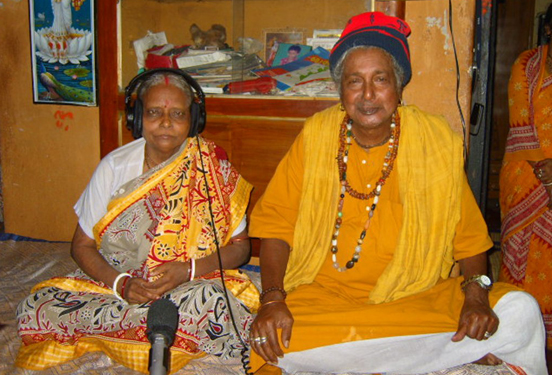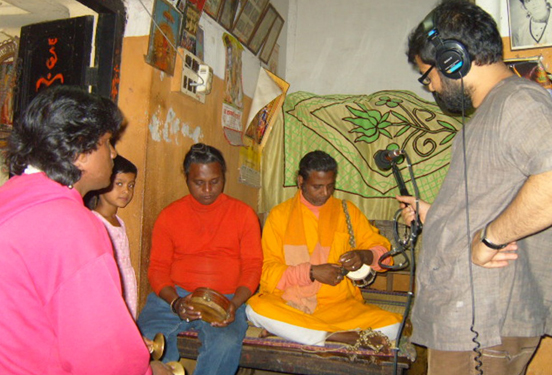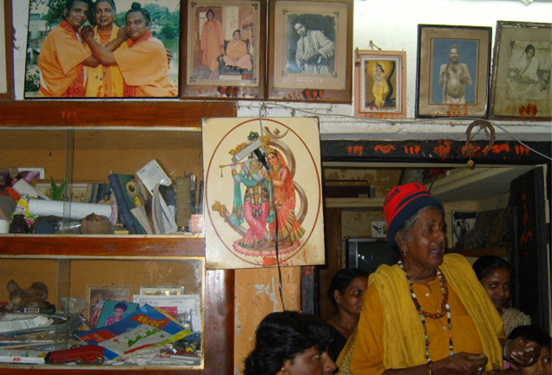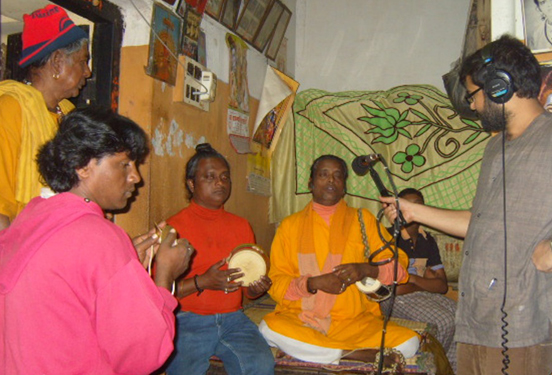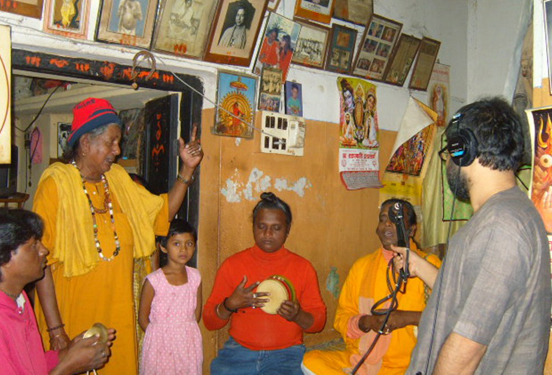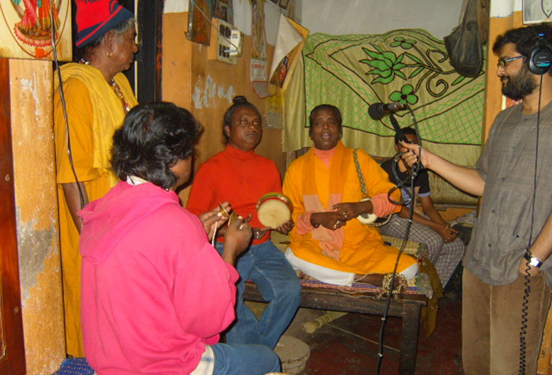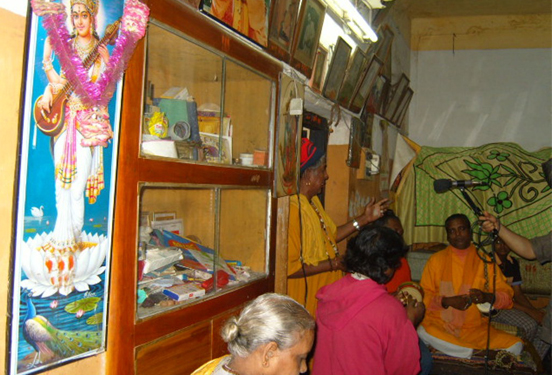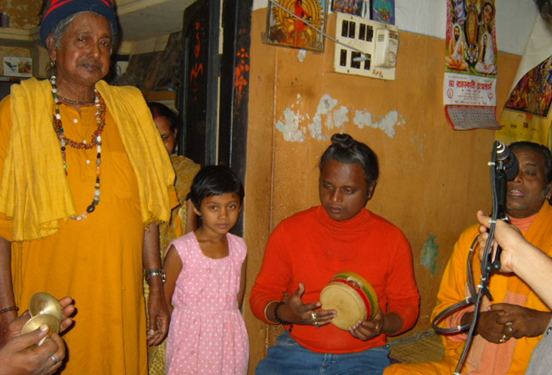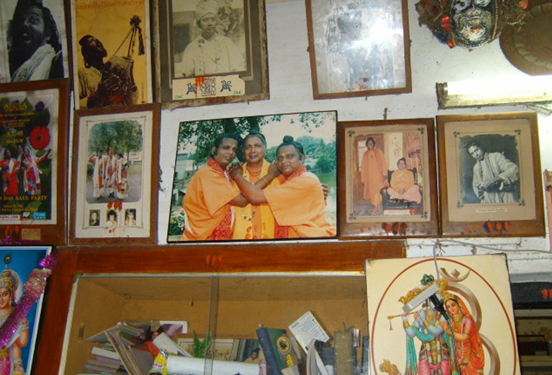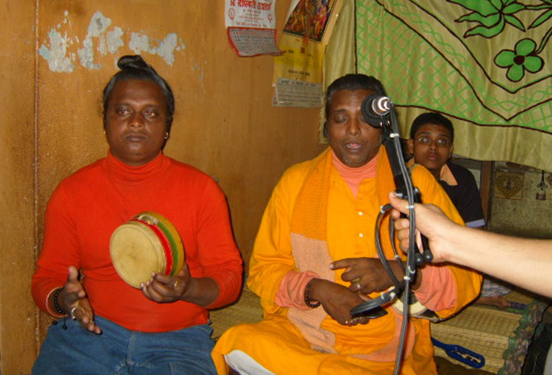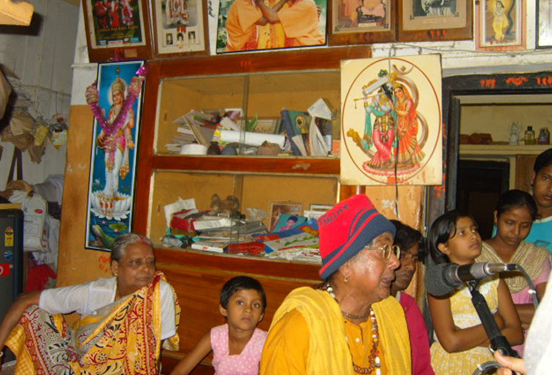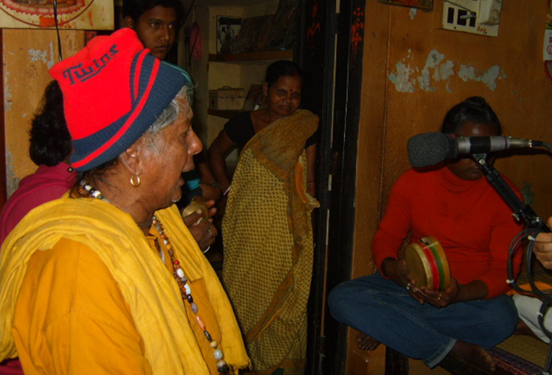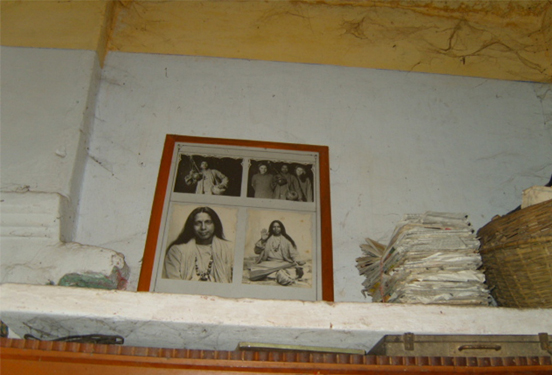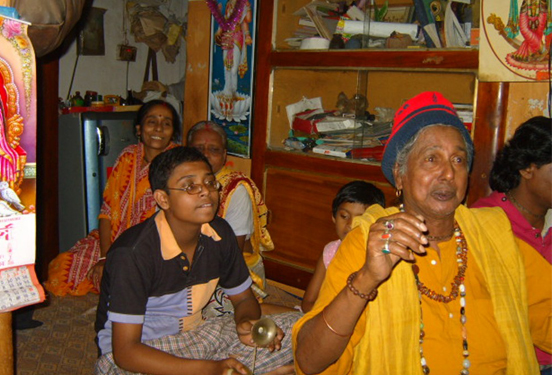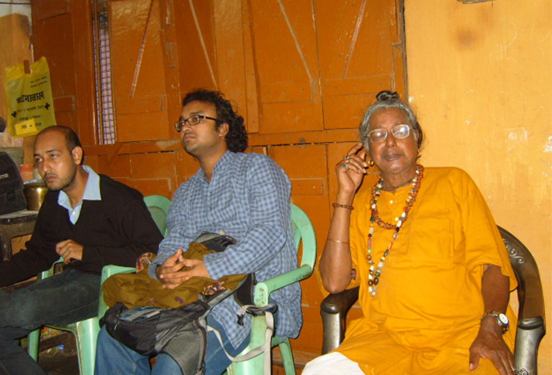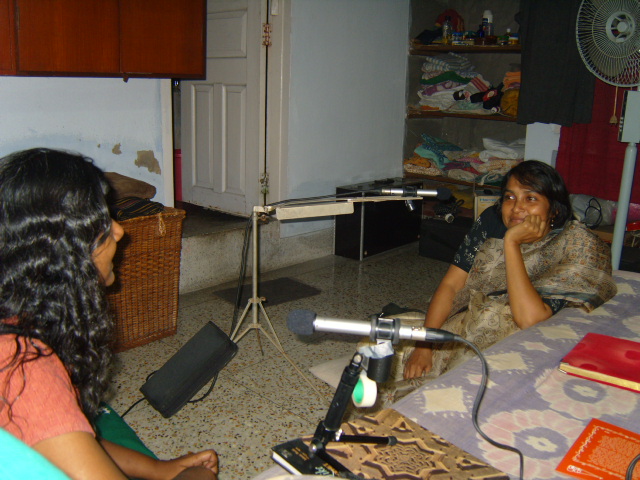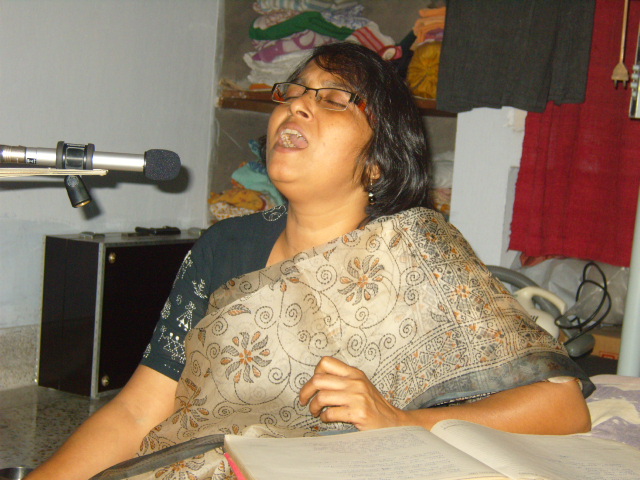Archives: Record Session
On 29 October 2018, I was at the British Library sitting at the desk of Lead Curator of World and Traditional Music, Dr Janet Topp-Fargion, looking at some papers relating to Arnold Bake, the Dutch scholar of Sanskrit and Indian music, pioneer field recordist in the Indian Subcontinent in the 1930s and 40s, for my ongoing research on his wax cylinders from Bengal. They gave me a few files with miscellaneous papers and after I finished going through what I had gone to study, namely the typed up sheets of the first catalogue notes for the cylinders, I continued to browse through the other papers, for they looked interesting enough to me. I was allowed to take photos of the papers with my phone and occasionally I found something to bring back with me. Then, I found a few typed sheets stuck together with a pin, with the heading: ‘Overseas Research Leave, Report by Dr A. A. Bake, Reader in Sanskrit. India and Nepal– May 1955 to August 1956.’ This was Arnold Bake’s last trip to India (and Nepal). I was curious, as I knew of two recordings of Tagore songs that he had made in this time, one of Indira Devi Chaudhurani in Santiniketan and another of the Tagore singer Chitralekha Chowdhury, then a young schoolgirl who studied at Patha Bhavan, and whose mother was the painter Chitranibha Chowdhury. We had in fact interviewed Supriyo Tagore, Indira Devi’s nephew and Chitralekha herself for our exhibition Time Upon Time, playing them the songs and recording their listening. Bake’s notes about his recordings are always scant, so throughout my work I have had to look at other sources for more information, such as his letters. I wondered if there was something in this report about his Bengal recordings from that trip.
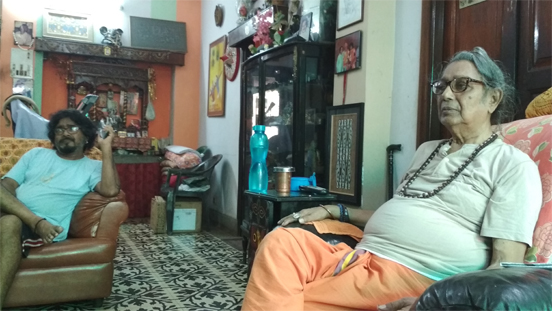
Purnadas and his son Dibyendu Das, Kolkata, Sep, 2019
‘The outward journey by Clan Macintosh, from Liverpool to Calcutta was extremely comfortable and pleasant. A dock-strike in Liverpool threatened to cause considerable delay, but…’
I went skimming through the pages. He arrives in Calcutta via Colombo, goes on to Nepal, then goes to Delhi, then Benaras, comes properly to Calcutta. Eight months have passed since he had embarked on this journey. ‘Arriving in Calcutta on the 24th February we just escaped being stranded in the general–and complete–strike on that day. Zero hour was 6 a.m. and our train arrived at 5.30 a.m., which made it just possible to catch one of the last taxis running, to reach the boarding house before everything came to a standstill. My wife and myself, the driver and an assistant and 26 pieces of luggage (including my recording equipment) in one single not too large taxicab. The hartal had been organised as a protest to the proposed merger of Bihar and Bengal to one administrative unit (as it had been up to 1912 or thereabouts), and was only one of the manifestations of popular –or political–dissatisfaction with the decrees from Delhi. On the whole, things went without loss of life, except for a couple of poor shopkeepers, who thought that, as on previous occasions, the hartal would be over at 4 p.m. instead of at 6 p.m. as decreed and who were promptly stabbed to death.
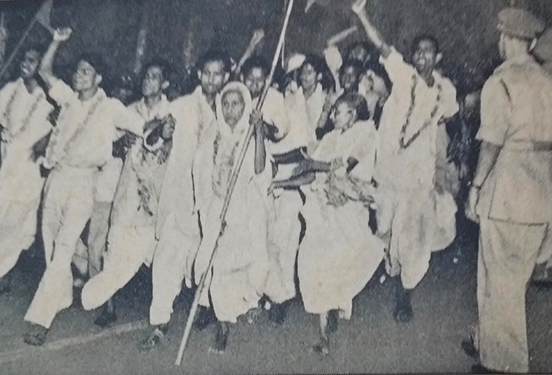
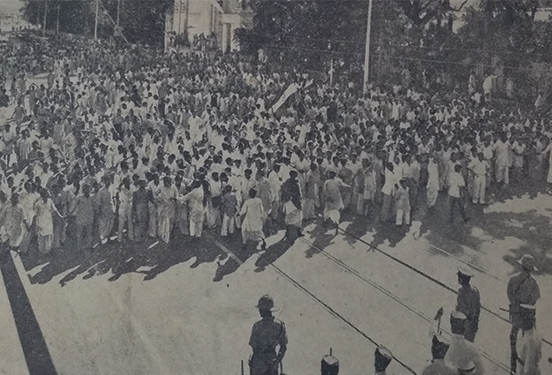
From local newspapers, photos of satyagrahis protesting the merger of Bihar and Bengal
‘As luck would have it, there was a festival of Bengali folk music shortly after we arrived and I was able to take several records of Vaishnava religious songs as sung by groups of wandering mendicants from West Bengal. Kindness and helpfulness from old and new friends were most enjoyable and made the days unforgettable. The same was the case during our visit to the Santiniketan after an interval of nearly 20 years. Also there I had the opportunity to make some interesting records of Oriya songs and folk music and Bengali songs, including the rendering of one of Tagore’s songs by his niece, aged 82–the acting Vice-Cancellor of Visvabharati University–a remarkable achievement on the part of the old lady.
‘On our return to Calcutta, I had hoped to acquaint myself with the stock of recordings anthropologists of the Indian Museum had made in the field, but an unexpected setback in health…’
I knew the song of Tagore’s niece of course, many know it; it seems that Indira Devi used to like to sing this song, ‘Katobaro bhebechhilo’, during this time (https://www.youtube.com/watch?v=K9bb9dumEM4). But what is his Bengali folk music festival he is talking about? Where are the recordings he says he made there? I asked Janet and she in turn asked their Bake-in-Bengal researcher, Christian Poske. He brought out two audio files marked C52/NEP/67 and C52/NEP/68. C52 is the Bake Collection at the British Library’s Sound and Audiovidual Archives. NEP would mean his Nepal recordings. By now Bake is no longer making recordings with the phonograph, on wax cylinders (1931-34), nor on the Teficord sound recorder, which he had used in the second phase of his field recording trips, from 1938. He was using a reel-to-reel recorder now. Bengali folk music recorded in Calcutta marked Nepal, with no other detail except to say Vaishnava songs. It is not surprising that after years of browsing the catalogue, and listening to Bake’s recordings, I had never found these.
Janet offered to open the files for me on her computer, so that I could listen. These were far longer sessions than anything we have had from Bengal so far; a wax cylinder could record for only about three minutes. These two tracks were of about 16 minutes each. I sat down to listen. The moment the first track, C52/NEP/67 started to play, I knew I had struck gold. I also knew I had no way to take these recordings back with me, no way to take them to people who would know and identify the singers, so I would have to listen as closely as I could and then use those those sonic impressions to find my way.
Here is the note I typed on my computer:
29.2.1956 and 1.3.1956—banga sanskriti sammelan?
Calcutta
C52/NEP/67 16:34 track
Religious Vaisnava songs, sung by the mendicants
Jiban he nutan, nyay na jeno chore, dekho dekho mon—Sanatan?/Nabanidas? (Nilakantha) khamak ghungur kartal
Gurupade prembhakti holo na mon hobar kale—fakiri style—prasanna kumar
Gurupade prembhakti again
C52/NEP/68 15:11 track
Sonar manush eshechhe bhai dekhbi jodi aay/ogo tribhuban korechhe alo jhalok daey bidyuter gaay—same singer– dugi, ektara aar kortal (performing, can hear reverb) বয়স্ক
Kal shokale hori bole amay nitai probhu tene naey (female singer) –khanjani prochondo echo , khola space e gaan mone hoy. Dotara accompaniment—manju? / purno sister? Sounds like a young voice.
Purnodas surely—ore amar abodh mon /sarbada chetane thak re mon
Banka nodir gotik bojha bhar—adbhut ektana fakiri style
Ektara dugi, ghungur
I had to tell Janet after I finished listening, that this was no ordinary recording, but I refrained from saying anything more. I asked if they would upload the recordings along with their other Bake-in-Bengal tracks (https://sounds.bl.uk/World-and-traditional-music/Arnold-Adriaan-Bake-South-Asian-Music-Collection), they said they could not do that just now. I was excited and worried too. I felt like I was holding something very precious in my hands and I knew I would have too take extra care of it. Such knowledge is, in fact, very fragile; a momentary lapse and it can break.
The following months, back in Kolkata, I had to think of ways by which I could establish the provenance of those two tracks. Where could I start working with a sound, which I did not have with me and which lay silent in the vaults of an archive many seas away? Dates, I thought. 29 February and 1 March 1956. What was the festival that Bake was talking about? Could it be the Banga Sanskriti Sammelan. A young friend, something of a bibliophile, Apurba Roy, and I tarted to search through old newspapers. 1956 was a leap year and indeed, the Banga Sankriti Sammelan had opened on 25 February that year. We found photos in the papers, the pandal at Muhammad Ali Park had caught fire the afternoon before the festival was to begin, but organisers promised to start at the same venue on the fixed date. The doyen of Bangla stage Sisir Kumar Bhaduri would open the festival. Historian Nihar Ranjan Roy would speak. The whose-who of Bengali literary and cultural world would descend on the pavilion, from classical to art song, theatre and folk performances too. Kalipada Pathak, Indubala, Angurbala, a troupe from Santiniketan, Nirmalendu Chowdhury, Sheikh Gomani Dewan… We searched programme announcements for names of the baul singers, and went through reviews to find something about who had performed. There was nothing. No name of any of the singers who I thought I had heard in the recordings at the British Library.
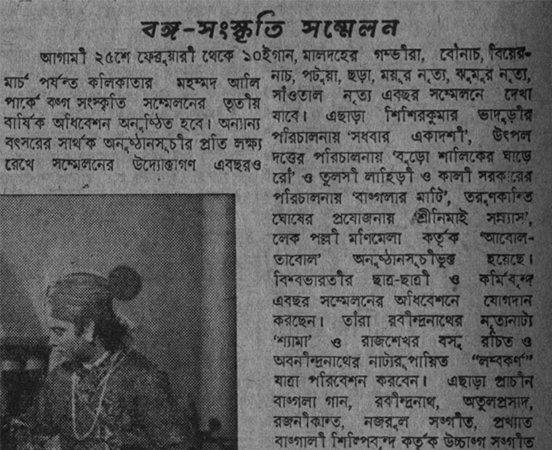
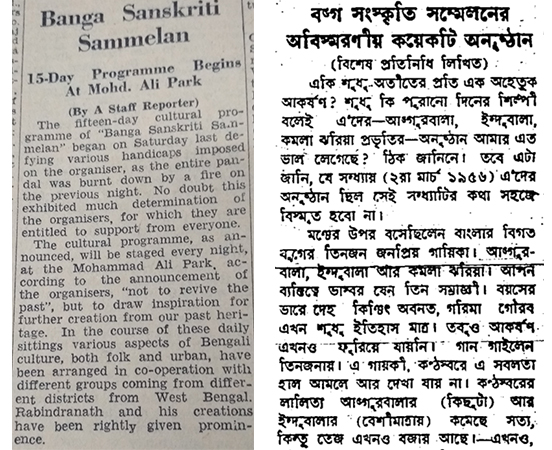
News of festival fire and review
So I decided to meet Purno Das Baul and ask him if he remembered performing at the festival in 1956; if his father was there and who else might have been with them. If Arnold Aadrian Bake had recorded Nabani Das Khepa Baul in 1956, then it was history. Nabani Das Khepa Baul (1890-1964), who shines in a galaxy made up of such stars as Rabindranath, Kshiti Mohan Sen, Shambhu Saha, Shantideb Ghosh, Mukul Dey, Deben Bhattacharya, Richard Lannoy…
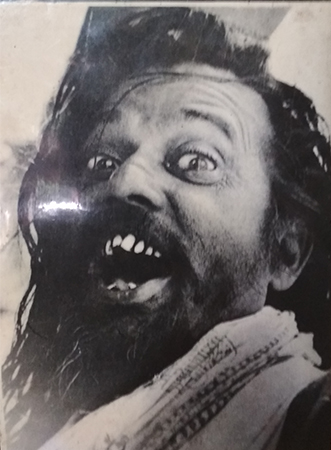
Richard Lannoy photo of Nabani
We know about the first and only recording of Nabani Das Baul and the first of Purno Das and Lakshman Das, made by Deben Bhattacharya, at the Banga Sankriti Sammelan of 1954. Debenbabu has talked and written about it. There are enough publications from that trip to stamp it with lac. After all, Debenbabu was the kind of recordist who made sure he carried his recordings out into the world. In one his last and final conversations with the actor and theatre director Aly Zaker in Dhaka in 2001, he had talked about that trip and about the festival, about how he had come with his photographer friend Richard Lannoy, how he had recorded Abbasuddin and Nabani Das Baul, how he had gone back with cans and cans of songs and tunes, enough to compile many albums. We have heard from Deben Bhattacharya’s wife, Jharna Bose Bhattacharya, stories about Deben and Richard’s trip to Nabani Das Baul’s home in Suri. All of this is known history now and the two songs of Nabani Das Baul, the only recordings of his voice so far heard, are available, even on the internet.
Listen to a Nabani Das song recorded by Deben Bhattacharya in 1954, Gour chander haspatale
The Purno Das and Lakshman Das recordings of Deben are another story. How they played a role in opening the doors to a whole wide world for the bauls. How they carried a sound to the West which also led to the making of a sound. That should be the subject of another session note.
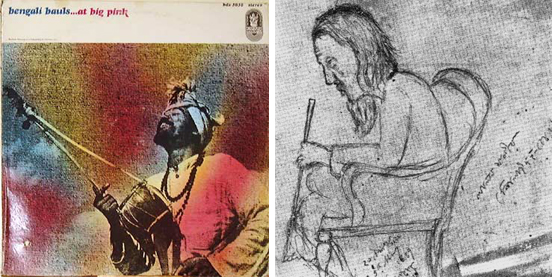
Cover of Bengali Bauls at Big Pink, released by Budda in 1968 (left). The image they used was Sambhu Saha’s portrait of Nabani Das Baul taken some time after 1937. This image is as iconic to baul matters as Jyotirindranath’s sketch of Lalon Fokir from 1889 (right).
I met Purno Das Baul and his son Dibyendu (Chhoton) in their home in Dhakuria, south Kolkata, on 7 May 2019 . The 86-year-old Purno Das remembered the Banga Sanskriti Sammelan, although he got some details of the fire mixed up. He insisted the venue had been shifted after the fire, which was not the case. Never mind that. As I read out from my notes, and told him what I had found out from the papers, he began to talk about his father’s songs, their musical family, his own musical journey, the fire in the tent during that year’s festival, and much more. This is how we have organised the recording from that day.
00:00 Chapter 1: Talking about the 1956 recording
15:40 Chapter 2: On Nabanidas Khepa
21:30 Chapter 3: More songs. First trip abroad, to Russia. Did not know anything about the value of archiving. Hence, so much has been lost.
25:56 Chapter 4: American trip in 1967, following Allen Ginsberg’s visit to their home and later of Sally [and Albert Grossman, of Woodstock fame]. Other singers in their group were Purna’s brother Luxman Das Baul, Ashok Fakir and Sudhananda Das.
27:46 Chapter 5: Family, lineage
32:51 Chapter 6: More on Nabanidas
33:34 Chapter 7: About Edward C. Dimock and Charles Capwell
34:15 Chapter 8: Voice of Purno Das’ mother Brajabala (Nabanidas’ wife)
40:16 Chapter 9: About photos, Sambhu Saha, Sai Baba
43:50 Chapter 10: The historical importance Purno Das Baul and his early recordings
We then decided that Purno Das would write a letter to the British Library and tell them about what he had heard from me and about how he was convinced the recordings were of his father and their own songs. And how they would like to have a copy of the recordings.
The rest does not need elaboration. The letter was taken, the plea heard, the recording repatriated by the British Library. A happy ending for all.
What we have here are a set of recordings from a session when we listened together to the recordings the British Library had sent to Purno Das Baul. We cannot play here the archival recordings as we do not have the permission to do so. Here is a recording of our listening to the recording. Such as the photos of photos we take, and bring back with us, this is a recording of a recording of a recording–many times removed from the source, but a source in itself.
Strange streams meet in this story. The Santiniketan world of which Nabani Das Baul was a part was also a world which formed Arnold Bake. He went there as a 26-year-old young researcher in 1925, and his love of Indian music, songs of Rabindranath, folk music, the bauls, kirtan–so much came out of his years of association with the place and deep friendships he forged there. Not only because of Santiniketan, but surely that time in his life played a huge role in the choices he made. Which is why, before coming on this 1955-56 trip, he was writing to his old friend Annada Sankar Ray and making plans about what they might do, how they can listen to baul songs, how they might go to Kenduli. And Roy suggests that he consult Mrs Mukul Dey about this, as they have recently gone to the Kenduli mela. Interestingly, there are among the private papers of Mukul and Bina Dey (http://www.chitralekha.org/) evidence of the fact that Bina [Mrs Mukul] Dey would visit Nabani Das’ akhra. She wrote down directions to the place as well as words of songs in her notebook. This same Bina was also a friend of Mrs Bake’s, for they had met in their youth on the grounds of Santiniketan. Here s a photo of a photo of a photo–something from the library of the University of Leiden, where Bake was a student and where many of his papers are housed.
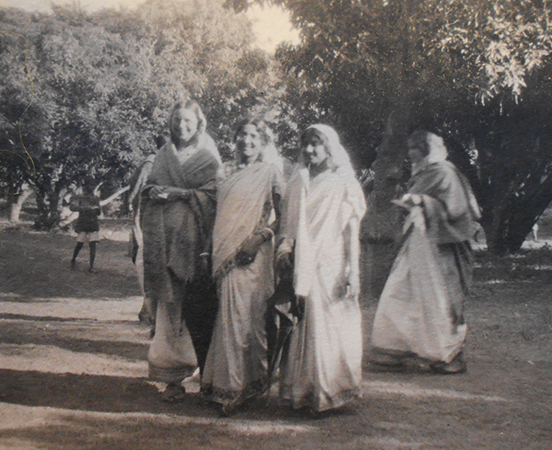
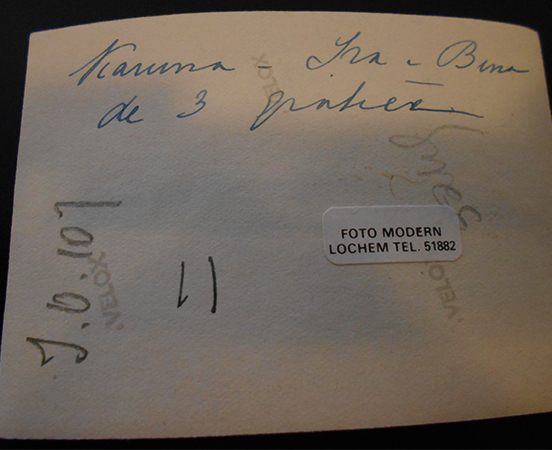
Photo from the library of Leiden University
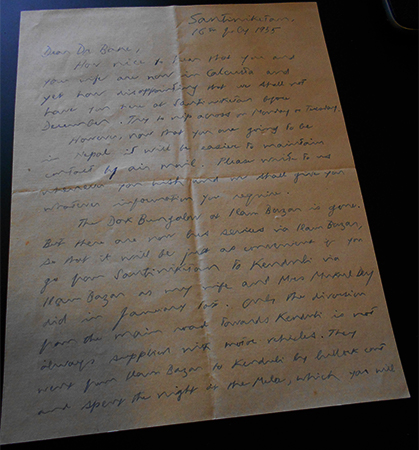
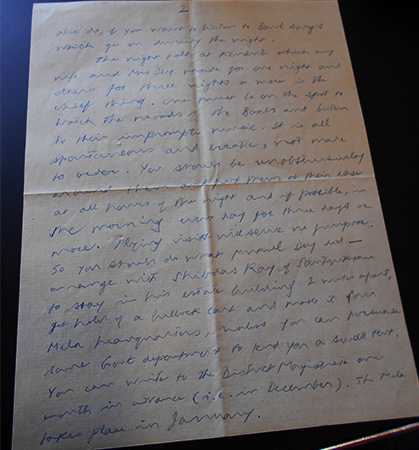
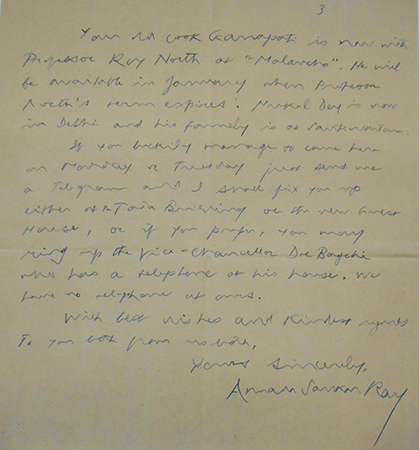
Annada Sankar Ray letter
The fact of Arnold Bake’s non-recognition of Nabani Das Baul, or at least the fact that Nabani remained unmentioned in Bake’s notes, troubles the mind. We speculate on answers. What is an archive? What do we keep in an archive? What do we fail to keep? What happens to the unrecorded part of the story? Is it lost forever, or does it remain in some other form, as another kind of trace?
At The Travelling Archive, we are often faced with this question. We fail to keep records too. We fill in for the gaps left by people before us, someone else will fill is our own gaps. That is how life flows and knowledge grows. What is wonderful is that we have two new songs of Nabani Das Baul, a song of Sudhananda Das Baul (who came from a tradition of kobigan singing in East Bengal and hence had such a distinctive style), a song of the gentle Radharani Dasi, Purno’s sister who loved him so much that she refused to record for HMV when her brother was not offered a contract, the brilliant Purno Das Baul in his late teens, and his brother-in-law, Gopal Das, who was a yogi and travelled about, singing songs. ‘Perhaps Radharani would accompany him if she did not have to care for her infant nephew,’ wrote Charles Capwell in his book Sailing on the Sea of Love. ‘She and Gopal have no children of their own because, as Laksman explains, they are yogis; that is, they are adept at baul sadhona… Radharani likes to sing and does so well; nevertheless she does not get as much opportunity to sing as she would like because most of the attention is given to men.’ Perhaps Radharani longed for her own child too, like she longed to sing? How to know? Where do we find the record of such things?
We will end this session note with two beautiful photos by a woman artist from Santiniketan, Kiron Barua, who was born in 1924 and studied at Kala Bhavan, Santiniketan. She captured the madness of Nabani Das Baul, the khepa baul, with her Rolleicord camera, some time in the 1950s. This is how we can assume Nabani Das Baul to have looked on stage when Bake was watching her perform.
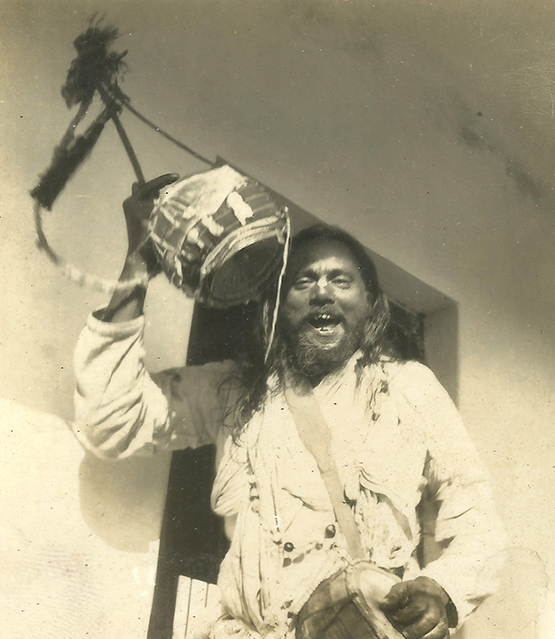
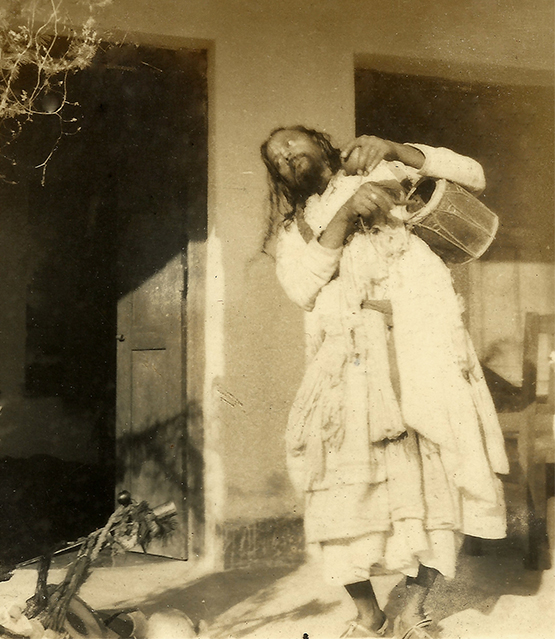
Written by Moushumi Bhowmik and page designed by Sukanta Majumdar, Aug, 2020
Related link:
https://www.anandabazar.com/supplementary/rabibashoriyo/story-of-nabani-das-baul-father-of-purna-das-baul-article-by-moushumi-bhowmik-1.1193096 (accessed in Aug, 2020)
It is strange to write a session note more than a decade after a field recording trip, to recall details of an experience of 2009 in 2020. Now, it is the recording that has to take us back to that day, also the photos and recordings from days before and after the session. That is all we have with us, there aren’t any other field notes, as I am not in the habit of keeping a diary. This in fact is the diary we keep. We also have our individual and collective memories, and we tap into those.
I am trying to remember if there was a specific reason for us to go to meet Lakshman Das Baul (also written as Luxman and Laksman in various sleeve-notes and books, sometimes also enhanced with diacritics, while we pronounce the name more as Lokkhon), in his home in Suri on 18 November 2009. We were four of us; besides Sukanta and me, there was our friend, musician Satyaki Banerjee and Biplab Ghosh, a poet. We went in the evening, it was about 7 pm when these recordings were made. Before going to him, we went to meet Abani Biswas of Milon Mela, The Sources’ Research theatre project (https://digilander.libero.it/milonmela/), built on the ideas of Jerzy Grotowski’s Theatre of Sources. And, before going to Abani, we had gone in the morning to meet Gour Khepa (the Gour Khepa session notes and recordings can be accessed here https://www.thetravellingarchive.org/record-session/bolpur-birbhum-18-november-2009-gour-khepa/).
So, I try to go backwards, looking for the ‘source’.
In 2009, several years into our field recording, our own folk festival in Shaktigarh, Jadavpur, the Baul Fakir Utsav having quickly grown from seed to quite a big tree in the past four years while we were preparing for its fifth edition in January 2010, with Deepak Majumdar, Georges Luneau and Ruchir Joshi in circulation amongst us, this trip to Gour, and then to Grotowski via Abani, and then taking one step back in time, to Lakshman Das, must have been our own attempt at tracing the course of a journey, albeit backwards.
And now when I am writing this note, we are in the process of going further back from the brothers Lakshman Das Baul and Purno Das Baul, to their father, Nabani Das Baul, via Deben Bhattacharya, Albert and Sally Grossman and Allen Ginsberg, having discovered in the archives of the British Library. a recording of Nabani Das Baul in performance in 1956, made by none other than Arnold Bake.
I am never comfortable writing about baul matters, because I feel utterly confused by its anthropology, sociology as well as baul as a form of performing art. There are many scholars to write about such things. I think that at The Travelling Archive, we are drawn to the power and beauty of this music, and we are also interested in the stories which come out of the lives of those who sing this poetry which is layered with meaning. In 1967, Purno Das Baul, Lakshman Das Baul, Sudhananda Das Baul, Hare Krishna Das, Jiban Krishna Mondal and one curious non-baul by the name of Asoke Fakir (who is a central character in Deborah Baker’s book A Blue Hand: The Beats in India, had gone on a US tour. Our conversation with Lakshman Das Baul starts from there.
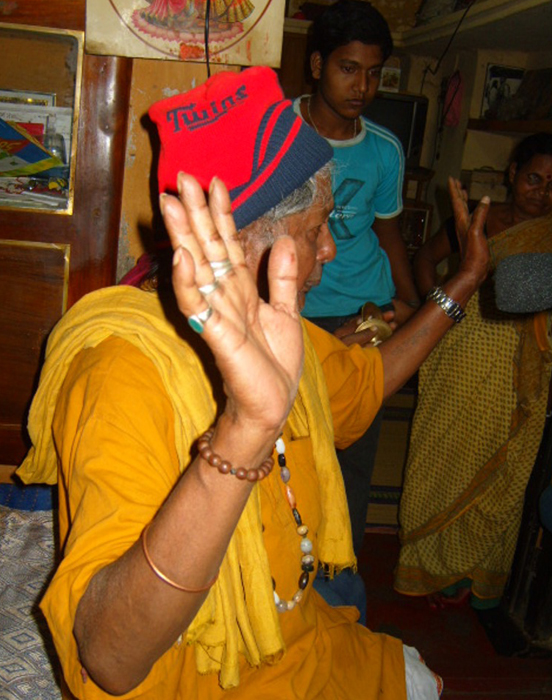
Lakshman Das Baul in his home, Suri, Birbhum
‘Like Purno, Laksman has fond memories of America and is proud of having been asked to go there,’ writes Charles Capwell in Sailing on the Sea of Love: The Music of the Bauls of Bengal, a pioneering study on the songs of the bauls, first published in 1986 and then from Seagull Books in 2011. ‘On his mailbox,’ Capwell continues, ‘in the manner of Indian gentlemen of the last century who had been to the UK to study, he has written “Laksman Das Baul, U.S. Returned.” Laksman’s impressions of America can be summed up in his statement that the gods and great beings who once inhabited India have been reincarnated in America.’
When we met Lakshman Das Baul, he still remembered things, but he had also forgotten details and was getting confused; perhaps he did not care so much to remember either. His home in Suri was filled with people and things, hence also with time. The US trip had receded to the background, now his sons Sukdeb and Mahadeb were carrying on with the singing, but they were not the shining stars of this time, hence there was a sense of fading out of the light.
Thousands of songs, he said, thousands of songs. I got from my father and I am leaving with my sons. And so many places, where to begin to tell the story? I had bought a pair a shoes from Kalighat, and walked for a few days in them to prepare to go. They took us to San Francisco instead of New York, so we stayed there and also played some gigs. Albert Grossman, the producer of our tour, had arranged it all. But my feet were covered in blisters and they hurt very badly. Sally looked after me. I could not perform, but had to have an operation. Then when we came to Bearsville, not far from Bob Dylan’s house, Sally would stock our kitchen with food, and if there were things left over from two or three days, she would throw everything and get new supplies. There were apples in the garden. So many apples. I would cook chicken with apples instead of potatoes. Dylan loved my cooking. He would keep coming back for the food.
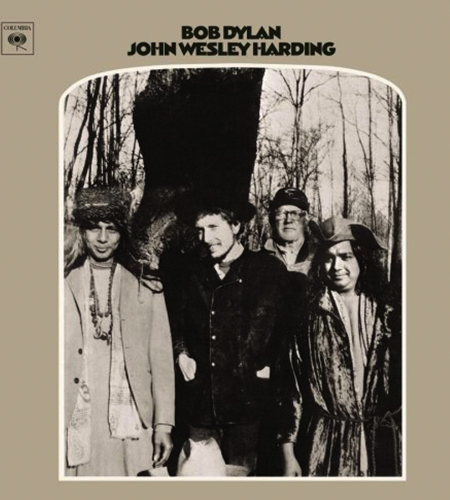
Purno Das and Lakshman Das on the cover of Bob Dylan’s album, John Wesley Harding.
(https://www.expectingrain.com/dok/who/h/hardingjohnwesley.html)
Interestingly, after a gap of decades, Sally Grossman had started to come back to Bengal to work with the Bauls in the 2000s to create their Baularchive, and so when we met Lakshman Das in 2009, he had also started the process of reconnecting with own his past. Some memories had returned to him, but in our presence too, some memories were reignited. We talked about Allen Ginsberg, who had been instrumental in connecting the bauls with the Grossmans, which kicked off their American journey in the late 1960s.
‘Allen was my friend. I taught him some asanas. When he came to our home in Suri, Baba had had a stroke and he was paralysed. He could not move at all. So I had to do everything for him. He would be drooling, and Allen cleaned his mouth with his hands.’
‘From Tarapith, Asoke brought Allen, Peter [Orlovsky], and Shakti [Chattopadhyay] to Suri, where he knew of a large clan of Bauls. There Allen found the aged Nabani Das Baul on his deathbed, half-paralyzed and unable to wander farther. Upon being introduced, the old man said of Allen and Peter, “They are born Bauls, they will spread the Baul message, and true peace, friendship and dharma will arrive.” Sitting at the old man’s bedside, Allen took down Asoke’s translation of the old man’s quavery song.
‘O blue dressed woman why don’t
You put on your blue dress again
Put vermillion on yr forehead
& come before me as a lover,
& wind and bind and plait my hairs …
I came to play the flute in Brindaban
Now I give the flute to you
young girl– …
Why don’t you take my flute
& let it sing on yr lips
Radha Radha Radha
‘A Baul is only helpless, it is said, before the sound of Krishna’s flute.’ (Deborah Baker, A Blue Hand)
Lakshman Das Baul passed on 21 April 2015. His son, Sukdeb Das Baul, who sang for us on this day in 2009, has also died. Lakshman Das Baul cared for the song to live; in our recording you can hear him introducing his sons Sukdeb and Mahadeb. Does Mahadeb continue to sing? Do his children sing with him now?
Photos from the recording session in Lakshman Das’ house in Suri, Birbhum
‘According to Purno and Laksman, their family has been baul for seven generations, but it is difficult to get more specific information from them about those generations,’ wrote Capwell. Whether to call it baul or not can be a matter of debate. What is baul, who is a baul, what it means to be of baul lineage–it is not for me to enter into this space of critical thinking, I do not have the wherewithal to do so. I do not feel much interest in pursuing such questions either. However, there is a story of love and care from father to child which we heard and saw that day in Lakshman Das Baul’ home, and let us end our session note with it. But first a prelude.
Do you remember recording at the Big Pink with Garth Hudson? Every name from that time does not ring a bell. There was a drummer named Levon Helm, you remember you rolled him a joint? Very potent it was, but then you told him about your father and how he used to mix snake head with the weed… This time Lakshman Das Baul’s voice lit up. Shaaper mathar churno, he nodded.
‘The Bauls had long black hair braided to the waist and were wearing cowboy hats they’d picked up on the drive east from California, where they’d arrived direct from Bengal. (Before heading east in a beat-up old van, they’d played the Fillmore West on a bill with the Byrds.) They loved the bubbling beer sign over our fireplace, and I played checkers with some of ‘em, and we were laughing pretty hard. I was smoking a chillum with Luxman Das, and I said, “Man, that’s some good weed.” He smiled and said, “Very good, but nothing like my father used to smoke—little hashish, little tobacco, little head of snake.” I said, “Wait a minute. Did you say ‘snake head’?” And Luxman laughed. “Yes, by golly! Chop off head of snake, chop into tiny pieces, put in chillum with little hash, little tobacco. Oh, boy! Very good—first class high!”‘ (Levon Helm , 2006, as quoted in ‘Mystic Rites for Permanent Class Conflict: The Bauls of Bengal, Revolutionary Ideology and Post-Capitalism’ by Fabrizio M. Ferrari)
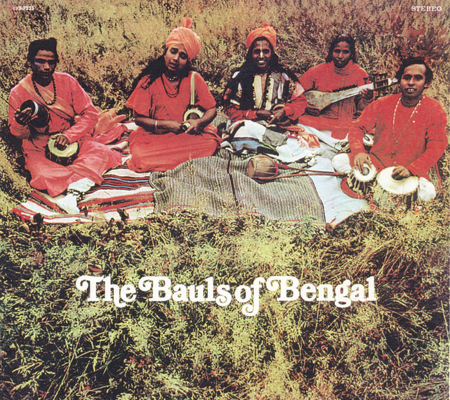
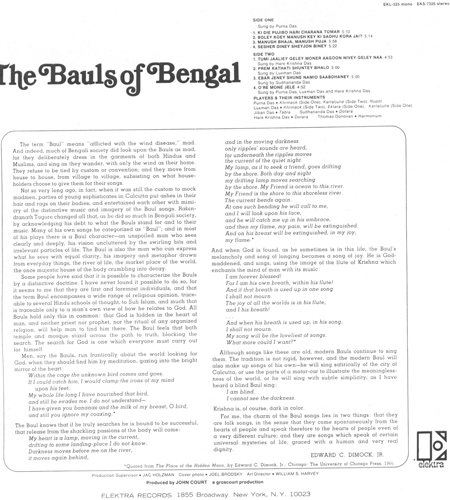
Front and back cover of ‘The Bauls of Bengal’ LP. This is one of the many records which came out of the 1967 trip.
Nabani Das Khepa Baul was a heavy smoker of weed and many have written about how he would smoke up and get into a trance while singing and dancing. By the end of his life, following his stroke, this Khepa Baul was so severely paralysed that he could not even smoke anymore, Lakshman Das told us and you can can hear it in this recording. ‘Then I would go to the market, get the ganja, prepare a chillum, take a deep drag and then breathe into Baba’s mouth. That is all that I could do. It would give him some peace.’ That image has stuck to my mind as one of resuscitation–a beautiful image of holding on, of son helping father live.
Written by Moushumi Bhowmik. Page designed by Sukanta Majumdar, Aug, 2020
Related link:
https://www.anandabazar.com/supplementary/rabibashoriyo/story-of-nabani-das-baul-father-of-purna-das-baul-article-by-moushumi-bhowmik-1.1193096 (accessed in Aug, 2020)
This is a ‘lesson’ I had with Nirmalda, Nirmalendu Mitra Thakur, at the home of his cousin, Milan Mitra Thakur, both of the Mitra Thakur family of Mainadal, in Birbhum, who were recorded by Arnold Bake in 1933. The song I am drawn to is one we first heard during their Janmashtami and Nandotsav festival celebrating the birth of Krishna, in 2014, when we were in Mainadal. That was our first trip to the village, on the trail of sounds left to us by Bake. Nandotsav is an elaborate two-day festival of singing and dancing and rituals; this song about the birth of Krishna to Jashoda, the queen, in the home of Nanda, the cowherd king, was among the many songs we heard that day and I don’t think I took any particular notice of it at the time of the singing, Only when I heard it later on our recordings from that day that I began to play this section again and again. Then I called Nirmalda and asked for the words and their meaning. Before this day in 2018, therefore, I had been following this song and making room for it in my own cycle/circle of songs for several years.
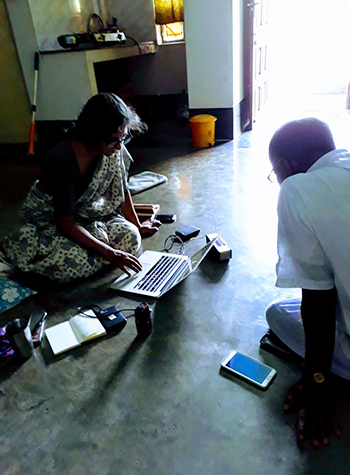
Nirmalendu Mitra Thakur and Moushumi in the home of Milan Mitra Thakur in Bolpur, Birbhum, going through kirtan recordings of Arnold Bake and related recordings of The Travelling Archive.
17 June 2018 was a day heavy with rain, our first monsoon clouds of Asarh having just arrived. So, we can hear the rain throughout this recording. Milanda and his wife lived in a unique room at the time. Milanda is a painter and you could feel it in the way everything was in the long single room on the first floor, circumscribed by a balcony, with parallel walls lined with windows. That room was everything for them–bedroom and kitchen and studio and living room; bare floor, bare walls, minimum furniture, a single bed, Milanda’s canvases and brush and paint stood in one corner, the kitchen things in another–everything neatly arranged. In this recording, while we are singing and talking, tea is being made and we can hear Milanda and Kona Boudi (his wife) talking too. They are concerned about my health, and advise me not to drink too much tea because it disturbs my sleep. I laugh and say I need to have tea all the time.
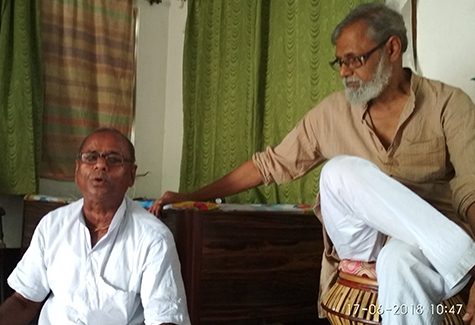
Milan Mitra Thakur, sitting on a mora, Nirmalendu MItra Thakur on the floor. The curtains are drawn as it is raining outside.
নিদে অচেতন রানী, কিছুই না জানে/চেতন পাইয়া পুত্র দেখিলা নয়ানে (বয়ানে)। The queen lies unconscious in sleep. Awakened she sees her son’s face. ব্রজরাজ বলি, রানী/ রানী, ডাকি ধীরে ধীরে/শুনিয়া আইলা নন্দ সূতিকা মন্দিরে। ‘Borojoraj’, (King of Braj), the queen whispers. Hearing her call, Nanda comes to the birth-chamber. হরল চেতন দেখি আপন তনয়/লাখি পূর্ণিমা চান্দ জিনিয়া উদয়। He sees his son and is lost for words; as if a million full moons have struck. যে যায় দেখিতে, পুনঃ না আসিতে পারে/যদুনাথ দাস ভাসে আনন্দ সাগরে। Who goes to see [this birth/the child], they cannot return. Jadunath sails in the ocean of joy.
This telling of the story is very interesting, for it seems here as if Jashoda* is in labour and she is birthing Krishna. The myth however is that Jashoda is Krishna’s foster mother; Nanda his foster father. Krishna, who is not human at all but god born as a human child, must be saved from a political conspiracy, or he will be killed at birth. He has come to save the world, so he must be saved; separated from his birth parents Devaki and Basudev, and found a safe home. That is how Krishna is ‘born’ in Nanda’s home.
The festival of the Mitra Thakurs of Mainadal with their five century-old legacy of Krishna and Chaitanya devotion, has the dual name of Janmashtami and Nandotsav, thus celebrating both the birth of Krishna, the god, his arrival on earth, as well as his arrival in the house of Nanda and into the arms of Jashoda. The festival is grand in scale and meaning. it is also familial and intimate. Thus they sing the tenderness of the love between the parent and the child. Nirmalendu Mitra Thakur fondly remembers his Sejda, the famous Nabagopal Mitra Thakur, who was recorded by Arnold Bake 1933, and then again by Deben Bhattacharya in 1954, and who had taught him this song.
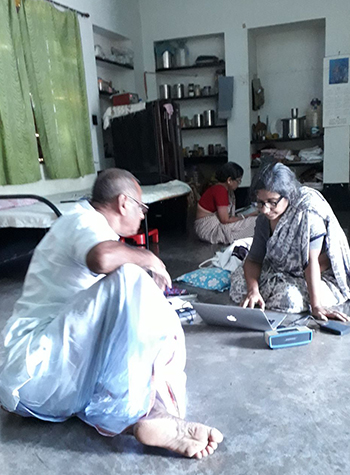
Nirmalendu Mitra Thakur and Moushumi listen to old recordings. Kona sits in her little corner
On this day in 2018, we sang this together, while talking about many other things, including reminiscing about visits of other scholars to Mainadal, talking about old photographs and worrying over the future of Mainadal. The Mitra Thakur tradition of kirtan singing is essentially patriarchal, their girls do not sing in the family temple or at their festivals. Hence there is some irony in Nirmalda teaching me, a woman, their song, and even telling me that I must let them know if ever I sing this song on the radio, so that they can listen.
Written by Moushumi on Janmashtami 1427 BS (12 August 2020)
*Note that the name Jashoda would be written as Yashoda in most parts of India, but in Bangla we pronounce our ‘ya’ as ‘ja’, and our effort in The Travelling Archive is to stay close to the sound of the language, where possible, although we cannot always do this with consistency. Working across languages, I am often–mostly unsuccessfully–grappling with the question of how to write sound with signs.
Filmed by Anadi Biswas, Sukanta’s Bangladeshi student at Roopkala Kendro, Kolkata, who had come to meet us in Faridpur from his home in Gopalganj. This is a rare video, because in all our years of work, there is hardly any record of our own process, we have almost never turned the camera upon ourselves. In fact, we don’t usually make video recordings and even when we do, the video only complements the audio. Our voices are recorded of course, because we are part of conversations. There are some stills too, usually me taking photos of the recording process. Sometimes Sukanta will place his recorder somewhere and take photos; occasionally he will go to the extent of recording with one hand and taking photos with the other. Sometimes I will record too. Now with our mobile phones fitted with reasonably good cameras, we make more video recordings than before, but here we are talking about 2013. Anyway, the point is that, whatever and however we record, we don’t really record ourselves. One big reason is also this that we don’t usually go anywhere as a big group and there is sometimes just the two of us; we also work solo. There is always too much to do and no time to look at ourselves.
This was different. We had a film school student who was trying out his own skills, zooming in on the leaves and fruit as Habib sang Lalon and Salamotbhai walked through the trees.
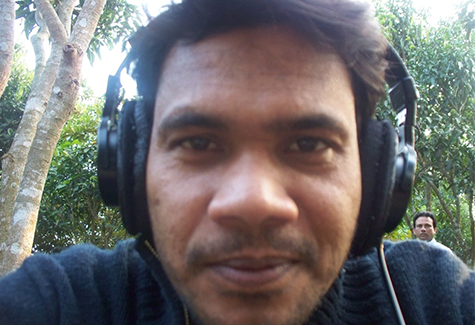
Self-portrait, Anadi
The other point to make is that, this was a special moment in our field recording work, and it must be read as such. This is not us going to the ‘field’, summoning singers to where we are lodged. and recording them. That is not at all our process. We met Habib several years ago, through Salamot Khan, whom we had met in 2006. We have listened to him for years, often to his same songs and stories. We have zoomed in on him as he have zoomed in on Faridpur–going to the same shops to eat, same songs to listen, same faces to see. ‘Now that I know your face by heart, I see’, wrote Louise Bogan in her ‘Song for the Last Act’. Faridpur is like that for us. Therefore, this was a gathering of old friends and a celebration of our lasting friendship. The place was an orchard of a friend of Salamotbhai. Sanjay Sikdar, our old friend from Faridpur, was with us and he always is.
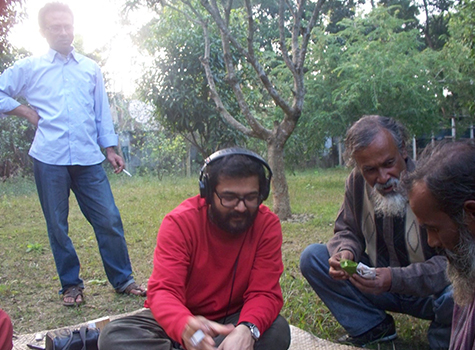
Paan-biri break
I am uploading this video on the anniversary of Salamotbhai’s passing.
Written by Moushumi on 12 August 2020
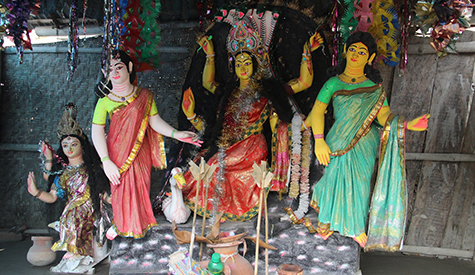
Ma Manasa idol, Jelepara, Munsiganj
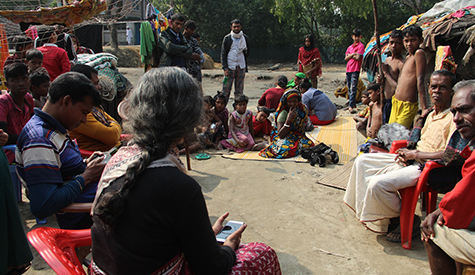
Recording session at Jelepara
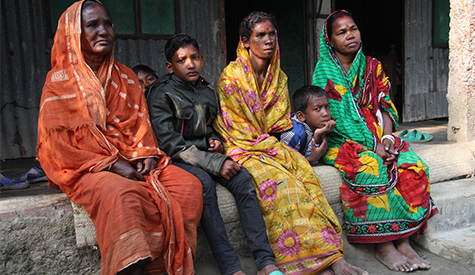
Mundapara women
We went on this trip on the trail of Arnold Bake’s Santal recordings of March 1931. We went to Kairabani where Bake had recorded students at the Baptist mission school.
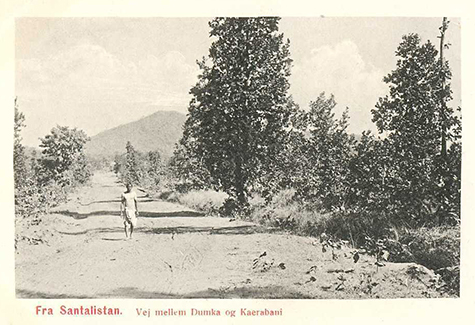
Babita Murmu’s Boge Gupi Do was sung in response to Bake’s recording of the same song, which can be heard here: https://sounds.bl.uk/World-and-traditional-music/Arnold-Adriaan-Bake-South-Asian-Music-Collection/025M-C0052X1641XX-ZZZZV0 (accessed 25 July 2018).
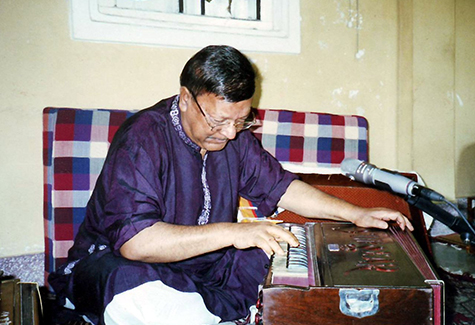
Biditlal Das
On 9 June 2016, we were invited to take part in a public arts event in Sarsuna, an area on the south-western end of Kolkata, around an artists’ residency project called Chander Haat (www.chanderhaat.org). This event was called ‘Sarsuna Theke Jana’ or ‘Derives from the Metropolis’ and it was curated by Sayantan Maitra Boka of Shelter Promotion Council (www.shelterpromotioncouncil.com).
As we began to explore the area, contemplating what we could do by way of taking our work to this event, we realized that this area was largely immigrant territory and that most of the people who had set up home here had arrived from Bangladesh over the past two decades or so. Hence these were new immigrants and were quite different from the old refugees of the time of Partition, or even 1971.
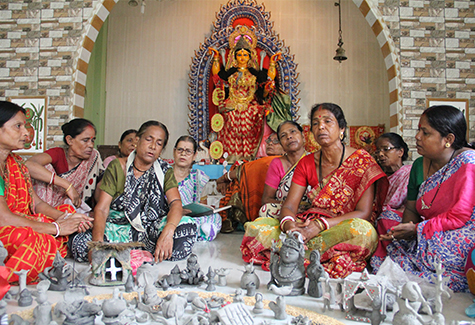
Women of Sarsuna singing Manasamangal
Many of the families were from Barisal in Bangladesh, we learned. One of the visual artists also taking part in the event, Mallika Das Sutar, was working around the Manasa Mandir, which is the temple of Manasa or the Snake Goddess. Mansa is of course big in Barisal and Bijoy Gupta’s Manasa Mangal or narrative in praise of Manasa, is read through the monsoon month of Sraban. In fact, in 2012 we went around different places in Bangladesh to record Manasa’s songs. Here Mallika’s installation involved the local women’s live performance of Manasa’s songs.
We entered into this space of Mallika’s installation and talked with the women who had gathered and recorded some of their songs and stories, as a prelude to a recording session we will have there later, in the month of Sraban (July-August). This was also for us an extension of our ongoing work on Manasa, and a direct continuation of our work in Barisal in 2012.
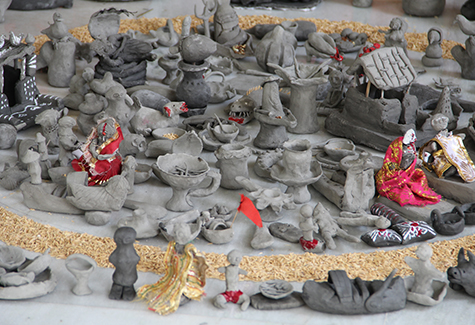
Mallika Das Sutar’s installation. Clay idols and models made by the women of Sarsuna
Here the women are singing that part of the story where Manasa makes a deal with Sanaka, when she begs for a child, after all her sons have been drowned by Manasa’s curse. ‘You may have a child, you may name him Lokkhindor, but I will snatch him away as soon as he is born,’ Manasa says. Sanaka says, ‘No, that is unacceptable.’ The deal-making goes on. Sanaka is adamant; she will have a child. Manasa relents and finally grants her a son who, she says, will be snatched away on his wedding night. This Sanaka accepts for she then thinks that she will not give her son in marriage and that will solve the problem for her. The story of course becomes far more complex and tangled up. Here they only sing a short extract from the long story. The women who are leading the song are Chandrakala Roy, Malati Majumdar, Parul Sheel and Parul Halder. There are many more who have gathered.
Written in 2016.
Bhungur Khan and his team of Manganiyar singers from Barmer in Rajasthan had been invited to our 10th Baul Fakir Utsav in Jadavpur Shaktigarh in January 2015. For some years we had been inviting a team of bhakti/sufi singers from outside Bengal, to come and sing songs which would have some overlap with the songs of our bauls and fakirs in Bengal. Hence Prahlad Singh Tipaniya (http://www.kabirproject.org/profile/prahlad%20tipanya) came once with mainly his songs of Kabir; then there was ere the qawwals of Rampur, Mohammad Ahmed Warsi (https://soundcloud.com/irfan-zuberi/ustad-mohammed-ahmed-warsi-nasiri-qawwal). So, the Manganiyars came with Kabir, Mira and also songs from further West, such as Bulleh Shah.
They performed at the main festival on 10 January and then the next morning we met in the festival grounds and I suggested they could come to our house, to which they agreed and came along. So, in effect this became a recording session of The Travelling Archive. Sukanta recorded in our living room. These wonderful musicians sang something like five songs, quite getting into the mood of singing. Here they are singing a song of rain, love and longing, such as our bichchhed songs are.
Bhungar Khan is playing the khartal or castanet, Mehru Khan plays the harmonium and sings; Pappa Khan plays the dholak. Din Muhammad usually plays the kamayrcha, but here he had not brought his instrument, so he sat and listened.
Written in 2016
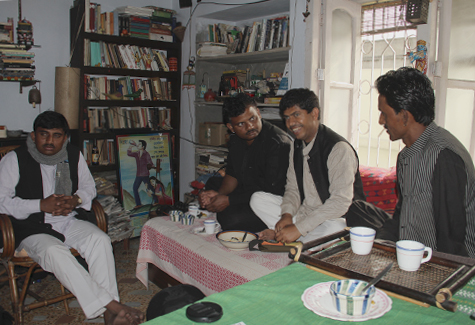
From left to right: Din Muhammad, Pappa Khan, Bhungar Khan and Mehru Khan
Related links
https://saxonianfolkways.wordpress.com/2013/06/03/music-masters-from-the-desert/
https://books.google.co.in/books/about/Bards_Ballads_and_Boundaries.html?id=b30HAQAAMAAJ
Tuntun Fakir of Kushtia in Bangladesh had come to sing at our 10th Baul Fakir Utsav in Jadavpur, Shaktigarh in January 2015. The tenth year was a very special occasion for us, for while it marked a milestone in the life of the festival, for some of us it was also a closure of sorts, for things were rapidly changing all around us and the festival could not remain as it was in these ten years. That though is topic of a whole separate discussion. Anyway, there was a team of bauls who had come from Kushtia this time.
After the performance tent had been set up, and the sound was in place, Sukanta declared that now he would go around making his own recordings (for The Travelling Archive). So, he went over to where the artists who had come to the festival were staying and made recordings of those informal sessions of singing and talking.
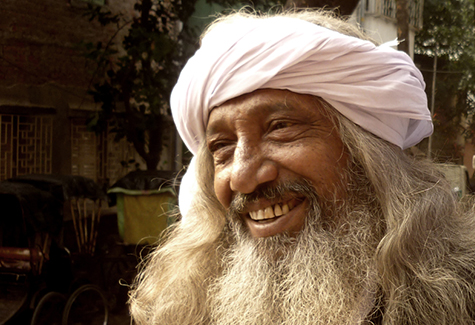
Tuntun Fakir at the festival. Photo: Amit Roy.
Tuntun Fakir has come many times to many festivals on this side of the border. Hence he is not physically so ‘opaar’ as he sings in the Lalon song, not so ‘un-take-across-able’. In fact, he does not care for lawful papers or anything–he is one of those people, like Laila in some ways, who lives in defiance and denial of the border. (Such acts of subversion will become more and more difficult as our cities and countries become more and more walled). Yet, metaphorically, the ‘opaar’ he sings about is the state we all are in, where we are unable to move without help, unless someone shows us the way and takes us across. Tuntun sings in the style of Kushtia, where song is more like a beautifully delivered sermon. He will remind the listener of Khoda Baksh Sai song also of Nazrul Fakir, Ajmal, even Binoy Nath, whom we had recorded way back in 2006, in Faridpur.
Written in 2016.
Mainadal is a village in Birbhum district, West Bengal, 215 km northwest of Kolkata. It is home of the famous Mitra Thakur family, known for their practice of kirtan around the shrine of Chaitanya Mahaprabhu, who has been their house deity since the beginning of Vaishnavism in Bengal, about 500 years ago. We reached Mainadal tracing a link from a set of sound recordings in the archives of the British Library. These recordings, made on wax cylinders by the Dutch scholar Arnold Bake in 1933, mention both Mainadal as the place of recording and the Mitra Thakurs as the artists being recorded–Haridas Mitra Thakur, Haladhar Mitra Thakur, Advaita Chandra Mitra Thakur, Nabagopal Mitra Thakur, Sanket Bihari Mitra Thakur, Gour Gopal Mitra Thakur and Kaliakanta Mitra Thakur.
It was a bit of an adventure identifying the place and the practice and then finding the contacts through whom to reach Mainadal. But once contact was established, things began to flow quite smoothly. The Mitra Thakurs heard of our interest in their music and invited us over to their Janmashtami or Nandotsav festival, which is the celebration of the birth of Krishna.
So, we went to Mainadal for the first time on 19 August 2014. Arnold Bake had been there 81 years before us; his recording dates were 12-14 August 1933, and we know now that in 1933, that was indeed the time of Nandotsav–the end of the monsoon month of Sravan and the beginning of Bhadra.
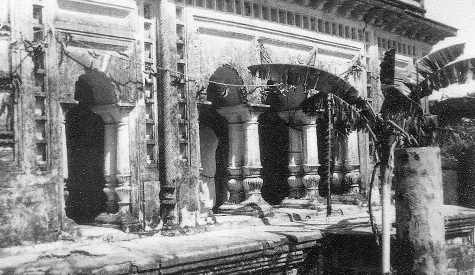
Mainadal old temple. Photo courtesy: Milan Mitra Thakur.
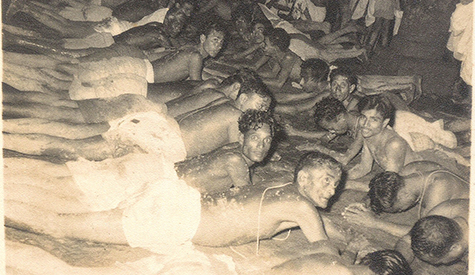

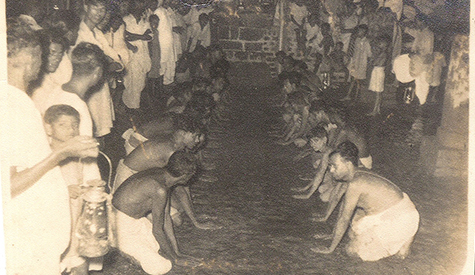

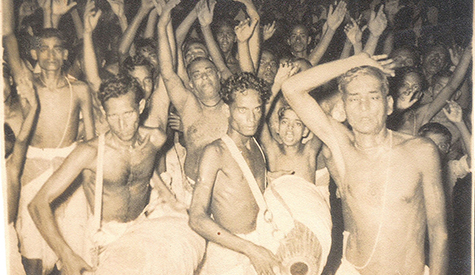

Old photographs of the annual festival of Mainadal. Photo courtesy: Milan Mitra Thakur. Photos taken by Pulak Dutta and Masyuaki Onishi during their trip to Mainadal in 1980.
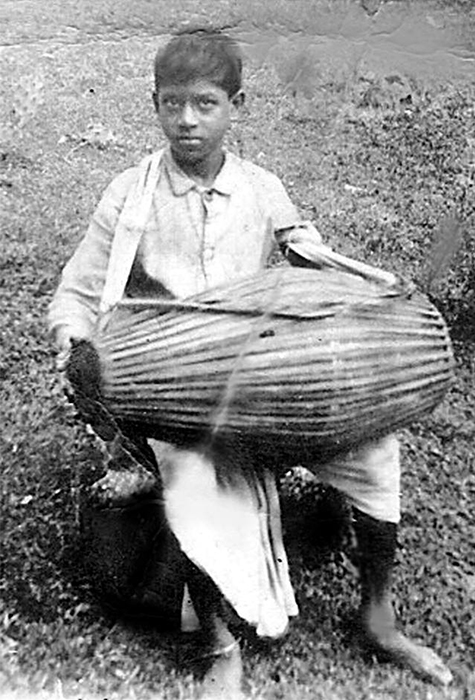
An eminent mridanga player, Kaliakanta Mitra Thakur.(or Kaliyakanta, as Arnold Bake wrote). This photograph is at least 80-85 years old, when Kaliakanta was a boy of eight or nine.
Milan Mitra Thakur sent us this photograph and wrote in an email: “মিত্রঠাকুরদের শৈশব শুরু হত এই পথে। শৈশবেই নির্ধারিত হত জীবনদিশা। এই ফোটোগ্রাফটি মৃদঙ্গ-বিশারদ কালিয়াকান্ত মিত্র ঠাকুরের (নির্মলের বাবা) ৮-৯ বছর বয়সের ছবি।”
Who might have taken this picture, is a matter of speculation. In fact, who took all the rest of the old photographs? Could it have been Arnold Bake himself? After all, he took pictures and sometimes filmed too wherever he went, especially for recording. Besides, Kaliakanta was recorded by Bake, along with his father Haridas Mitra Thakur. The British Library shelfmark is C52/1918 and the note in the catalogue reads like this: ‘Bake India II, No.269 (1931-33). Male solo recitation with drums and cymbals. Bake’s notes: “Kirtan from Mainadal 12-14/8/’33. [Kirtan tals] 12. shashishekara, 14. bororupak, 19. ?oj [Doj]. Haridas M.Th. [Mitra Thakur] cymbals with mistakes Kaliyakanta M.Th.” Reasonable quality recording.’
We have recorded many sessions of music performed by Kaliakanta’s sons, Nirmalendu, who is a beautiful singer, and Sachchidananda, one of the last remaining musicians to hold the great tradition of the Mitra Thakurs’ khol playing and recitation of what Bake called ‘drum poems’.
The large and extended family of the Mitra Thakurs were not aware of Bake’s visit to their village all those years ago; as a matter of fact, they had no idea who Arnold Bake might have been. When we told them their own story, they were truly excited. As I read out their ancestors’ names from my notebook, they responded with, ‘Oh, he was my grandfather! He was my father!’ and so on.
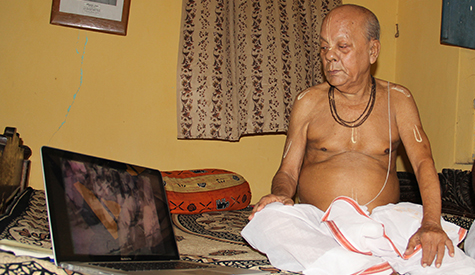
Manik Mitra Thakur watching photographs taken by Arnold Bake
That was the beginning of a relationship for us, for since that first meeting we have gone back many times to Mainadal, stayed overnight, recorded some beautiful music, while some of the Mitra Thakurs–Milan, Nirmalendu, Putul and so on–have become close friends. We did not have copies of Bake’s recordings with us when we first went to Mainadal (although now the British Library have taken the lead from our work and sent to the Mitra Thakurs digital copies of their recordings), but what we did have was some silent footage from Bake’s films (which we had from ARCE-AIIS) of what we thought was kirtan from Mainadal, although we were not so sure about them. So we wanted to check this out with the Mitra Thakurs. We also had a copy of a recording of Mainadal (Mayanadal, as written in the record sleevenotes) kirtan recorded 21 years after Arnold Bake, in February 1954 in Asansol, by Deben Bhattacharya. The singer was Nabagopal Mitra Thakur, who had also been recorded by Bake in 1933. This was from an LP released in 1966 by BAM in France.
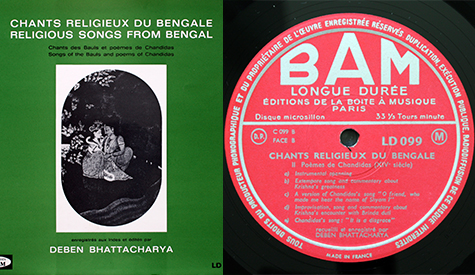
The cover and the record
So we played to the Mitra Thakurs these audio recordings and showed them the images of the record covers and silent footage we had with us. We went especially to the oldest family member, Manik Mitra Thakur, to record his response to these recordings and images, and what stories he might have to tell us. And, it was from here that we were directed towards Mongoldihi, for the octogenarian Manik Mitra Thakur and his sons identified the footage as being of the Ras festival of Mongoldihi, another village of Birbhum. Then he saw the photograph on Deben Bhattacharya’s record which had Nabagopal Mitra Thakur’s name in the caption. That is not Nabagopal, he said. The rest of the family said the same thing. (So then who is on the photograph of the Deben Bhattacharya album?)
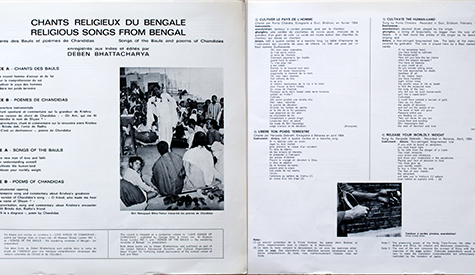
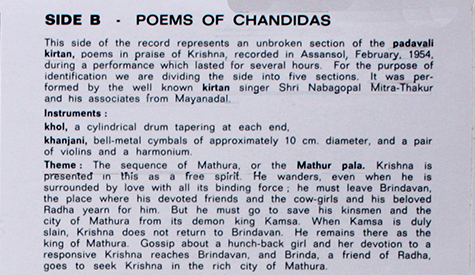
Liner notes from Deben Bhattacharya’s record
Anyway, We went round the village, meeting people, talking with them, while the song and dance of Nandotsav went on in the temple grounds. There were many people who had come to the festival. They sat listening to the music, watching the performance, and later all of us would be fed by the Mitra Thakurs; such has been the practice for hundreds of years. Sing, dance, eat and rejoice in the name of Gour or Gora.
ওহে গোরা, ওহে গোরা!
Nityananda Mitra Thakur, or Nitai as he was lovingly called by his family, one of the younger performers of this large kirtaniya family, had a natural charm about him. His movements were supple and as he sang and danced the story of Radha and Kirshna’s courtship–purbaraag or the flowering of love–that love and loving came to life. Nitai’s audiences savoured every gesture he made and every rasa which was aroused. This was performance before the initiated, so the audience knew where to feel what; they knew their rituals of appreciation. Here we have presented clips from that performance.
Later we talked with Nityananda about his performance, training, his lineage, showing him our finds–the Deben Bhatacharya album cover, the Bake footage, the names from BL. We talked about meeting again, about talking more. Something was begun, to be carried on later.
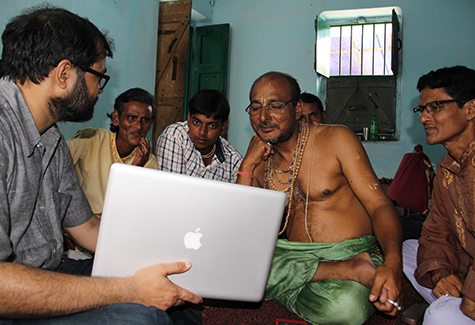
Nityananda Mitra Thakur watching old photographs
On 29 March 2015, I called Nitai, because I wanted to ask him something about Mongoldihi, where I remembered his wife had said she had family. Nitai’s phone rang a few times, then there was a voice on the other side. I introduced myself. There was a moment’s silence, I could hear a breeze hitting against the mic of the phone, so I asked Nitai if he was going somewhere and if I should call back later. Silence again. Are you not home, I asked. No, came the reply. The natural warmth of Nitai seemed to be missing and I wondered what might be wrong. So I asked if I was indeed talking with Nityanananda babu. ‘No,’ said the phone. ‘Nitai has died.’ I could not quite comprehend what he was saying. Beg your pardon? I said. I thought I must have heard wrong. The voice said again, ‘Nitai died last night, on stage, while he was performing. He had a heart attack. We have brought him to the crematorium now.’
So, that breeze and the crackling sounds were of fire and wind from the burning ghat.
This session is dedicated to our unfinished conversation with Nityanananda Mitra Thakur, who died at the age of 48, while in the act of singing and dancing his songs of love and devotion, for Krishna, Radha and Gora.
Written in 2016.
Post Script, added on 14 August 2017.
Referring to the photograph of Kaliakanta Mitra Thakur above, about which we were wondering if it might have been taken by Arnold Bake, we now know from Milan Mitra Thakur that it was indeed taken by him. The confirmation has come from Christain Poske, British Library and SOAS’ research scholar, who visited Mainadal earlier this year.
In this context, we refer to Bake’s letter to his mother, dated 16 August 1933. He wrote: ‘I brought a film but I did not use it because there were no performances during the day. I did take a number of pictures that I will send to Calcutta soon to have them developed. I hope they are nice, but I’m a little afraid . . .’ (Translation: Jan-Sijmen Zwarts). So, Kalianata’s was one of those pictures he had taken during that visit.
Bhaktadas still comes to our street. We had recorded him at home in 2010. Then one day we played him his song on our website. He was very excited to ‘see’ himself on ‘TV’.
With Bhaktadas, nothing seems to change. Only the years go by. We hear his voice, sometimes go out to the balcony, sometimes stay in, some days we go down and meet him. Make plans for another recording session; a recording session that is always a week or two away, as Sukanta tells us.
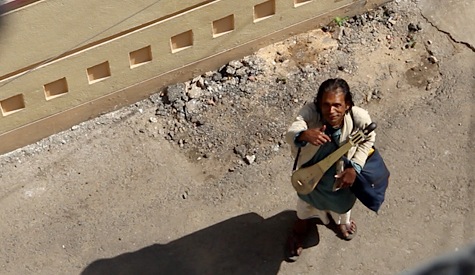
Bhakta Das in East Road, Jadavpur, Kolkata
ভক্ত দাস যাদবপুর অঞ্চলে কতদিন ধরে গান গাইতে আসছেন ঠিকমত বলা মুশকিল। বিগত বছর তিন-চার নিয়মিত দেখি। মাসে এক, দু’বার অতি অবশ্যই শোনা যায় ওঁর গান। ইউনিক গায়কি আর দোতারা বাজানোর স্টাইলে প্রথম দিন থেকেই ভক্ত দাস নজর কেড়েছেন সকলের। আমার কাছে একটি ছেলে কিছুদিন আগে একটা ফিল্ম নিয়ে এসেছিল সাউন্ড মিক্স করার জন্য; সে এই অঞ্চলেই থাকে একটি মেস বাড়িতে, সেও দেখা গেল তার ছবিতে রেখেছে ভক্ত দাসকে। ওদের পাড়ায় দাঁড়িয়ে তীব্র চিৎকারে, ঢোলা বিরাট সাইজের পাঞ্জাবি পরে আসর মাতাচ্ছেন তিনি।
মানুষটার সম্পদ হল ওঁর গলা। গান গাইলে সদা-ব্যস্ত এই শহরও একবার থমকে দাঁড়িয়ে দেখে নেয় ওঁকে। পাড়ায় ঢুকলে টের পাওয়া যায় অনেক দূর থেকেও। এই কংক্রীটের জঙ্গলে, দেয়ালে দেয়ালে প্রতিধ্বনিত হয়ে গমগম করে বেজে ওঠে ভক্ত দাস বাউলের কন্ঠস্বর।
গানের মাঝে নিজের মত করে কথা বসিয়ে নেবার অভ্যাস ভক্ত দাসের। অনেক চেনা গানেরও নানা অচেনা লাইন তাই মাঝে মাঝেই শোনা যায় ওনার কন্ঠে! কেউ ওঁর গানে শুদ্ধতা খুঁজতে গেলে বিপদে পড়বেন। ও গানের রস তার সপ্রতিভ মেজাজে, তার ইউনিক সাউন্ডে। আমরা তো এত জায়গায় যাই, কত রকমের মানুষ দেখি, কিন্তু এই একটি মানুষকেই দেখি যিনি সত্যি সত্যিই ভবঘুরে। ভাবে নন, স্বভাবে যথার্থই কিঞ্চিৎ বাতুল। মাঝে মাঝেই অনেকদিন আসেন না। তারপর হঠাৎ একদিন শোনা যায় সেই বিরাট আওয়াজ। এসে প্রত্যেকবারই বলেন কামাক্ষ্যায় গেছিলেন। আমাদের কয়েকটা রুদ্রাক্ষের ফলও দিয়েছেন একবার এ পকেট সে পকেট হাতড়ে। একদিন এসে আমার শরীর খারাপ শুনে বললেন, “আমি গান গাইছি একটা, সব ঠিক হয়ে যাবে”। বলে নিজের সুরে নিজের কথায়, মা আমার বাবাকে ভাল করে দাও ইত্যাদি বলে একটা গান গেয়ে চলে গেলেন। আমাদের বলেছেন এখন অশোকনগরের (উত্তর ২৪ পরগণা) দিকে কোথাও থাকেন। কথা শুনে বোঝা যায় কোনও কালে বর্ডার পেরিয়ে চলে এসেছেন। কন্ঠে নিয়ে এসেছেন বিচ্ছেদের সুর। প্রথমদিকে বেশিরভাগ বিজয় সরকারের গান গাইতেন। ইদানিং শহরে কলেরার মত ছড়িয়েছে, “হৃদ মাঝারে রাখব”। আগের উল্লিখিত ছবিটিতে দেখলাম তাই গাইছেন নিজের মত করে। লোকে পয়সা-টয়সা দিচ্ছে।
ভক্ত দাসের গাওয়া বিজয় সরকারের গান আমাদের ২০১০ এর একটি রেকর্ডিং সেশনে আছে এই সাইটেই। এই সেশনের ছোট ভিডিওটিতে ওঁর যাওয়া আসার একটা ছবি ধরা রইল; যেভাবে আমরা এখন ওঁকে দেখি আমাদের চারতলার বারান্দা থেকে। আগে উনি এলে নিচে যেতাম কখনো, আর যাই না এখন। উনিও জানেন। বারান্দার নিচটিতে দাঁড়িয়ে গাইতে থাকেন যতক্ষণ না এমরা একবার বারান্দায় বেরোই। দু’একটা বাক্য বিনিময় হয়, তারপর চলে যান। ইদানিং নিজেরই মত আর কোন এক গায়ককে নিয়ে আসবেন বলছেন আমাদের কাছে গান “শুটিং” করাতে। সে তো এখনও হয়ে উঠল না। প্রতিবারই বলেন কোন এক শনিবারের পরের শনিবার আনবেন তাকে! আমরা সেই পরের শনিবারের প্রতীক্ষায় আছি!
Written in 2014.
I have known Ibrahim Boyati for almost two decades; from the time of the shooting of Tareque Masud’s ‘Muktir Kotha’ in 1998. I was at the rehearsals with him and Muhammad Shah Bangali, a singer and composer from Chittagong, whom the ethnomusicologist Deben Bhattacharya had recorded in 1971.
As I write these lines, I think of the layers of sonic history contained in them. If an archive is the future of the past, as Alexander Stille calls it, then the present, the moment of the creation of sound, which is also the moment of its death, foretells the future. Who would have known that when a man from Paris had recorded refugee songs in an emerging Bangladesh in 1971, those sounds would find new meaning in a film made more than 25 years later? Who would also know that the young, blind and ever-smiling dotara player accompanying the singer on the sets of Muktir Kotha, our Ibrahim Boyati, would tell us his story of ageing with music; rather, of never ageing, in the two decades to come?
Late in the evening on 17 January 2013, we went to meet Ibrahim Boyati in the mazar of Khoka Pir in Faridpur town, where he can often be found. We went to ask him if we could have a session with him the next day, for it has been some years since we last recorded him.
Ibrahim bhai is a treasure of The Travelling Archive. He has enriched the space of our archive in non-replicable ways. Which is why when we see him in fear, looking hither and thither in the darkness with his blind eyes before whispering a promise to come to us the following day, as if we were hatching a plot; when he tells us in gestures about the silencing of the song; we feel ashamed for having taken part—directly or indirectly—in the process of this silencing.
We are a hapless people, who do not know what past to keep for the future. Ibrahim bhai had wanted us to shut the windows of the room where we were recording him on this winter morning in 2013. I still have my songs, he seemed to be saying, but I dare not sing them everywhere.
As we listen to him, over and over, in the recordings Tareque made for Matir Moyna, in our recordings of 2004, 2006, 2009 and now in 2013, we need to ask ourselves this singular and simple question: Why did Ibrahim bhai ask us to shut the windows that day, while he was singing?
And now for Sukanta, the keener listener’s story.
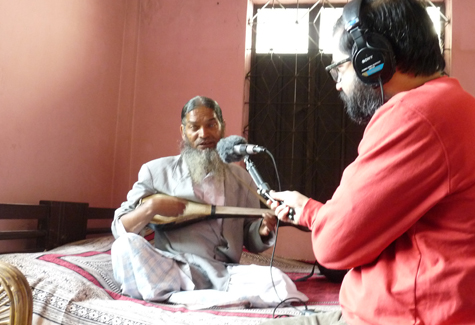
Recording Ibrahim Boyati
ইব্রাহিম বয়াতিকে যখন ২০০৬ সালে ফরিদপুর শহরের কাছে উত্তর শোভারামপুরে সাদেক আলির খামার বাড়িতে রেকর্ড করি, ওঁর গলা শুনে তো আমার পড়ে যাবার অবস্থা!
তারেক মাসুদের মাটির ময়না ছবিতে আগে শুনেছিলাম ইব্রাহিম ভাইকে। কিন্তু সামনে থেকে ওই ঈষৎ কর্কশ অথচ মধুর গলা, কখনো একটু কম-লাগা সুর আর অতুলনীয় দোতারা বাদন শুনে ব্লুজ গায়কীর কথা মনে পড়ে যাচ্ছিল।
অতিথিপরায়ণ সাদেক আলির সৌজন্যে শীতের সকাল সকাল সকলের খেজুর রসের পায়েস জুটেছিল। সেই খেয়ে দিনভর গান হল খুব। সেই আসরে ইব্রাহিম ছাড়াও আরো দু’একজন গায়ক ছিলেন, সাদেক আলি নিজে ছিলেন, তবু সবার মধ্যে কাঁচা-পাকা গোঁফ দাড়ি আর খোঁপা করা চুলের ইব্রাহিম ছিলেন নিজ বৈশিষ্ট্যে অনন্য।
পরে আর একবার ২০০৯ -এর মার্চ নাগাদ ইব্রাহিমের সঙ্গে দেখা হল। এবারে ওঁর বাড়িতে। ফরিদপুর শহর থেকে বেশ দূরের গ্রামে, আমরা খুঁজে খুঁজে পৌঁছলাম ওঁর বাড়ি। আগের রাতে কোথাও ম্যহফিল ছিল, বেশ ক্লান্ত ছিলেন। গান হল না, তবে কথা হল অনেকক্ষণ। ছোটবেলায় “ক্যানভাচার” ছিলেন, গান গেয়ে লোক জড়ো করে ওষুধ বিক্রি করতেন। একাত্তরের যুদ্ধের সময় ঢাকা থেকে পালিয়ে আসার রোমহর্ষক গল্প আছে ইব্রাহিম ভাইএর। এবারে গোঁফ-দাড়ি আরও সাদা হয়েছে। কুড়িয়ে-বাড়িয়ে টাকা জোগাড় করে ছেলে গেছে মিডল ইস্টে কাজ করতে। ছেলের নিজের হাতে সাজানো চাঁদোয়া টাঙানো ঘর, রাংতা আর রঙীন কাগজের সজ্জা, খালি পড়ে আছে। ইব্রাহিমের পকেটে মোবাইল। ছেলের ফোন আসে। মেয়ের বিয়ে হয়ে গেছে। কোলে গোলগাল বাচ্চা নিয়ে সে বাপের বাড়ি এসেছে।
ইব্রাহিম খোকা পীরের শিষ্য। ফরিদপুর শহর থেকে যে রাস্তা অম্বিকাপুরের দিকে চলে গেছে, সেই রাস্তার বাঁয়ে, কুমার নদীর ধারে খোকা পীরের আস্তানা। পীর দেহ রেখেছেন অনেকদিন। তবুও ওই মাজারটির সঙ্গে ইব্রাহিমের ওতপ্রোত সম্পর্ক। নিজের বাড়ি ছাড়া বয়াতির ওই আর একটি স্থায়ী ঠিকানা।
আমরা একথা জানতাম বলেই, ২০১২-র এক শীতের সন্ধ্যায় ইব্রাহিমের হদিশ পেতে আধো অন্ধকার মাজারে হাজির হলাম। অনেকদিন ইব্রাহিমের সঙ্গে যোগাযোগ নেই। ফরিদপুর যাওয়া হয় প্রায় প্রত্যেক বছর, কখনো তো বছরে দু’বারও। কিন্তু ইব্রাহিমের সঙ্গে আর যোগাযোগ করা হয়ে ওঠে না। যতবার সেই ২০০৬-এর রেকর্ডিং শুনি, মনে হয় এই মানুষটিকে জমিয়ে রেকর্ড করা দরকার।
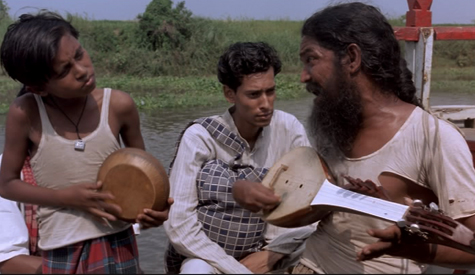
Ibrahim Boyati in Tareque Masud’s film, Matir Moyna.
শীত সন্ধ্যায় আশপাশ নিঝুম। মাজার চত্বরে ঢুকে দেখি বেশ বড় উঠোন। একপাশে পীরের সমাধি ঘিরে বেশ বড় আটচালা, কংক্রীটে ঢালাই করা মেঝেতে বিছানো কার্পেট। আর একদিকে বসতবাড়ি। পীরের পরিবারের লোকজন থাকেন বোঝা যায়। আমাদের হঠাৎ আগমনে অবশ্য বিশেষ কেউ বেরিয়ে আসেন না। আমাদের একমাত্র বল-ভরসা সালামত ভাই অন্ধকার উঠোনে ঢুকে কাকে যেন শুধোন ইব্রাহিমের কথা। আমি ভিতরে গিয়ে দেখি, অল্পবয়সি এক পুরুষ বসে আছেন মাজারের কাছে। তাঁকে ঘিরে জনা সাত-আটেকের একটা দল। সকলেই প্রার্থনারত। অল্পবয়সি পুরুষটিই যে জমায়েতের প্রধান বুঝতে অসুবিধা হয় না। প্রার্থনা শেষে সকলেই তাঁর পা ধরে কদমবুসি করে উঠে পড়েন। ইব্রাহিমকে দেখি সেই দলে। কেউ গিয়ে তাঁকে বলে আমাদের কথা। ইব্রাহিম বেরিয়ে আসেন উঠোনে। প্রধান পুরুষটি নীরবে আমাদের পাশ কাটিয়ে ওপাশের বাড়িতে ঢুকে যান। অন্ধকারে আমরা কেউ কাউকে ঠিকমত দেখতে পাই না। ইব্রাহিম মৌসুমীকে চিনতে পারেন; আমাকে পারেন না। আমাদের উদ্দেশ্য শুনে একটু নীরব থাকেন। একবার বলেন গান-বাজনা বিশেষ করেন না, আবার বলেন পরের দিন অন্য কাজ আছে। আমরা অন্ধকারে পরস্পরের মুখ চাওয়াচাওয়ি করি। এই ইব্রাহিমকে ঠিক চিনতে পারি না। মনটা খারাপ লাগতে থাকে। এতদূর থেকে এসেছি, এতদিনের পরিচয়, তবু এড়িয়ে যেতে চাওয়ার কি কারণ ঠিক বুঝি না। অবশেষে সকলের চাপাচাপিতে পরেরদিন ফরিদপুরে আসতে রাজি হন, আমরা যে বাড়িতে ছিলাম সেই বাড়িতে। ঠিক হয় হাবিব গিয়ে ওঁকে নিয়ে আসবে শহরে।
পরদিন সকালে আমরা অপেক্ষা করি। হাবিবের যা পাগলাটে স্বভাব, আদৌ আনতে গেল কিনা কে জানে! হাবিব অবশ্য আমাদের ডোবায় না। একসময় তার হাত ধরে ইব্রাহিম এসে ঢোকেন। সকালের উজ্জ্বল আলোয় দেখি বয়াতির মুখে একটু বয়সের ছাপ পড়েছে। দাড়ি পুরো সাদা, গোঁফ জোড়া নেই। মুখের ভাবে মনের ভাব ঠিক বোঝা যায় না।
যে বাড়িতে ছিলাম, তার লাগোয়া বিরাট বাগান। ছায়া-ছায়া নিরিবিলি বাগানে আগের দিনই লায়লার গান রেকর্ড করেছি। শীতের রোদ-ছায়া গায়ে মেখে বসতেও আরাম আর কংক্রীটের ফাঁকা ফাঁকা দেয়াল-ওয়ালা এই ঘরে টেকনিক্যাল কারণেও রেকর্ড করতে মন চায় না। কিন্তু বয়াতিকে বাইরে বসার প্রস্তাব দিতেই নাকচ করে দিলেন। অগত্যা ঘরেই আসর বসল।
মনে আছে ২০০৬-এর রেকর্ডিং সেশনে প্রথমেই গেয়েছিলেন, “এলাহি আলআমিন আল্লা বাদশা আলমপানা তুমি”। আমরা ওঁর গলায় বিচ্ছেদ গানের জন্য উশখুশ করে উঠেছিলাম। বলেছিলেন, হবে কিন্তু সবার আগে তাঁর বন্দনা করা চাই।
এবারে শুরু করলেন মাঝভান্ডার শরিফের এক গোঁসাই, রমেশের গান দিয়ে; “আমার প্রেম জ্বালায় অঙ্গ জ্বলে, জ্বালা কি দিয়ে জুড়াই”। প্রথমে একটু আড়ষ্টই ছিল কন্ঠস্বর। ধীরে ধীরে কথাবার্তায় সহজ হল। বললেন শিল্পী হিসেবে যোগ্য সন্মান পাননি বলে মনে করেন। সেই অভিমানে বিশেষ আর যান না অনুষ্ঠানে। দু’একটা বিচ্ছেদ গেয়ে, তারপর আমাদের একটু চমকে দিয়েই গাইলেন নিজের রচনা, “আমার আঙ্গিনার পাশে/ কে বাঁশি বাজায় রে/ বন্ধু, তিলেক দাঁড়ায়ে যাও, শুনি।/ তোমার লাগিয়া বন্ধু/ আমি জাগি সারারাতি রে/ জ্বালাই মোমের বাতি/ পথের দিকে চাইয়া থাকি/ আমার বন্ধু আসে নাকি”।
আমাদের মনটা ভরে গেল। ইব্রাহিম বয়াতি জাত শিল্পী। তাঁর প্রাপ্য মর্যাদা তিনি পেয়েছেন কি পাননি সে বিতর্কে না গিয়েও বোঝা যায়, তাঁর অন্তরাত্মাকে কোন কিছুই দমিয়ে রাখতে পারবে না। সঙ্গীতের ফল্গুধারা সেখানে বহমান।
ভান্ডার শরিফের গোঁসাই রমেশের গল্প (ইব্রাহিম ভাইএর ভাষায় যিনি “অনেকদূর অগ্রসর হয়েছিলেন”), ওঁর মুখেই শুনেছি। রমেশ নাকি গুরুর সামনে নির্ভয় চিত্তে জেনেশুনে বিষ মেশানো সরবত পান করে গুরুর কৃপা লাভ করেছিলেন।
ইব্রাহিম বয়াতির মত শিল্পী চারদিকে দলে দলে ঘুরে বেড়াচ্ছে এরকমটা ভাবার তো কোন কারণ নেই! তিনি স্বাধীনভাবে গান করুন। গুরু-কৃপায় সব গরল নিঃশেষে হজম করে ফেলে সুরে আমাদের মাতিয়ে দিন। ভক্তিহীনের এই প্রার্থনা।
Written in 2014.
We became friends with Nazrul Fakir of Kushtia in our home in Kolkata in the winter of 2012. He first came as our friend Satyaki’s friend. Slowly he started to come on his own; perhaps he felt an affinity. Those days Sudipto was doing his play on Lalon. Nazrul performed in it. So he had to keep crossing the border at Benapole, and that was not so easy. So once the trial of border-crossing was over, he had to find his places of comfort. In his own quiet way, he had made his own friends.
Once he came to us straight from Sealdah station. He brought us a CD of Mamun Nadia, a singer who had inspired him. He would stand on the bank of the Garai river and listen to music coming from the boats. Once they were playing a cassette of Mamun Nadia, a Lalon song, he said, and he felt deeply moved. He wanted to gift us that experience.
Nazrul wanted to take a gift home to his family. He is a man of very few words. But he confided in Sukanta. He said, at home, they don’t know what I do, what I sing. I go to all these places–London, Berlin, Bangalore–but they don’t know what I do. Could you please make me a CD of my songs so I can go home and play for them?
Sukanta’s recording and his note capture the essence of Nazrul. There is nothing more to say. You meet the man in his song. He is what you hear, not an inch less; perhaps more.
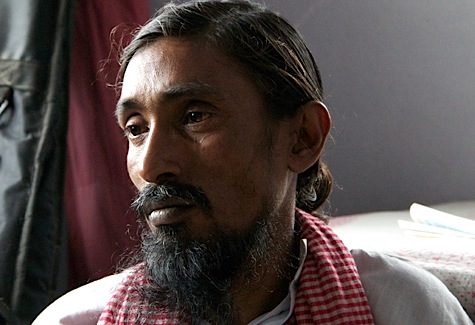
Nazrul Fakir
নজরুল ফকির কলকাতায় আসেন লালন-গবেষক, অভিনেতা সুদীপ্ত চট্টোপাধ্যায় ও নাট্যপরিচালক সুমন মুখোপাধ্যায়ের নাটক, Man of the Heart -এ কাজ করার সূত্রে। আমাদের বন্ধু, শিল্পী সাত্যকি বন্দোপাধ্যায়ও এই প্রযোজনার সঙ্গে যুক্ত থাকার কারণে সাত্যকির সঙ্গে নজরুলের সখ্য ও সেই সূত্রে আমাদের সঙ্গে তাঁর পরিচয় ও বন্ধুত্ব। নজরুল কুষ্টিয়ায় থাকেন। লালন সাঁই-এর মাজারের কাছেই। রব ফকিরের শিষ্য নজরুলের স্বভাবটি খুব মিঠে আর ঠান্ডা। কোথাও কোন কিছুর উপর জোর আরোপ করেন না। পাশের ঘরে নজরুল থাকলে বোঝাই যায় না ঘরে কেউ আছেন।
গল্প শুনেছি, ভারতীয় রাগসঙ্গীতের অন্যতম দিকপাল শিল্পী উস্তাদ বড়ে গোলাম আলি খাঁ সাহেবের বাড়িতে কেউ এলে, দু’একটা কথাবার্তার পরেই খাঁ সাহেব বলতেন, “এবার ইজাজত দিলে দু’একখানা গান শোনাই”। হয়ত বিশ্বাস করতেন তাঁর আর মানুষকে কি দেবার থাকতে পারে, তাই নিজের গান দিয়েই অতিথি আপ্যায়ন সারতেন!
আমাদের বন্ধু নজরুল ফকিরের মধ্যেও এই ভাবটি লক্ষ করেছি। নজরুলকে বিশেষ বলতে হয় না গানের ব্যাপারে; আর আড্ডায় নজরুলও অন্য কোন প্রসঙ্গে বিশেষ কিছুই বলেন না। খানিকক্ষণ চুপ করে অন্যদের বকবক শুনে, দু’একটান তামাক সেবা করে একতারায় সুর বাঁধতে থাকেন। তারপরে একফাঁকে অনুমতি নেবার সুরে বলে ওঠেন, “এবার দু’একখান পদ গাই”? আমরা হইহই করে উঠি। নজরুল একটানা গাইতে থাকেন। খান-চারপাঁচ গান অন্তত না গেয়ে নজরুলকে বিড়ি-বিরতিও নিতে দেখিনি। একবার বিড়ি খেয়ে আবার গাইতে থাকেন বিরতিহীন ভাবে। মাঝে মাঝে আবার শুধোন, “বিরক্ত করছি নাকি”!
সাঁইজির যেসব গানে দীন ভাবের প্রকাশ, যেখানে গুরুর প্রতি বা পরম করুণাময়ের প্রতি তাঁর শর্তহীন, সর্বাঙ্গীণ আত্মনিবেদন, সেইসব গান নজরুলের গায়কীতে ভারি সুন্দর খোলে। একতারা ও ডুগি সহযোগে যে শব্দজগত তিনি সৃষ্টি করেন, সাধারণভাবে দেখলে তা ভীষণভাবেই কুষ্টিয়ার নিজস্ব। সেদিক থেকে নজরুল হয়ত কোন ইউনিক সাউন্ড পেশ করছেন না শ্রোতার কাছে। কিন্তু পদ অনুযায়ী গায়কের ব্যক্তিসত্তার ছাপ তো গানের উপর পড়ে। নজরুলের সত্তায় ওই করুণ ও দীন ভাবটি এমন ওতপ্রোত জড়িত, ফকির যখন গেয়ে ওঠেন, “দেখে ভব নদীর তুফান, ভয়ে প্রাণ কেঁদে ওঠে/ এসো দয়াল পার করো…”; অথবা, “ও মেঘ হইল উদয়, লুকালো কুথায়/ পিপাসিত প্রাণ যায় পিপাসায়/ আমায় দাও হে দুঃখ যদি, তবু তুমায় সাধি/ তুমি না তরাইলে কে তরাবে আমায়”, তখন ওই তৃষ্ণার্ত প্রাণের হাহাকারটি আমাদের বুকে বাজে। ক্ষীণতনু ফকিরের জোর সেইখানে। আর কোথাও যে ফকির জোর খাটাতে পারেন না বোঝাই যায়। কোন উটকো লোকের অনুরোধে(না আদেশে সাঁইজিই জানেন) নিজের ছোট্ট থলি বোঝাই করে “ভারত” থেকে সাবান, পাউডার আর ম্যাগি নুডলস কিনে নিয়ে যান! ভয় পেতে থাকেন বর্ডারে কেউ কিছু বলবে কিনা সেই নিয়ে। এসব কোথায় কিনবেন, আমাদের জিজ্ঞেস করেন সসংকোচে।
সংসার পালনের জন্য নজরুল রঙ-মিস্ত্রীর কাজ করেন। ছেলেকে সঙ্গে নিয়ে লোকের বাড়ি রঙ করে বেড়ান।
মহাজ্ঞানী সন্ত কবীর তাঁর পদে বলেছেন, “সাহেব হ্যায় রংরেজ, চুনরী মোরি রংগ ডারি/ স্যাহী রংগ ছুড়ায়কে রে দিয়ো মজীঠা রংগ”।
রজকরূপে তিনি/ রাঙিয়ে দিলেন/ এ অবগুন্ঠন।
সব রঙ ধুয়ে/ উজ্জ্বল করো/ আমার প্রেমের রঙ।
কবীরের বহু পদেই তিনি পরম করুণাময়কে রজকরূপে কল্পনা করেছেন। প্রেমের রঙে ডুবে যাবার আর্তি জানিয়ে এই পদেই বলছেন, “সব কুছ উন পর বার দুঁ রে, তন মন ধন আউর প্রাণ”। দেহ মন ধন প্রাণ সর্বস্ব তাঁকে সমর্পণ করলাম।
কাপড় রাঙানোর কাজ তো আজকাল উঠেই গেছে। আমাদের ঘরবাড়ি রাঙানোর দায় তাঁর ভাবশিষ্যের ঘাড়ে হয়ত স্বয়ং সাঁইজিই চাপিয়েছেন! আমাদের অবিশ্বাসী মন এটুকু বিশ্বাস করতে ভালবাসে।
Written in 2014.
Related link
Sahib Hain Rangrez by Shubha Mudgal
We first met Linkon when we went to their house to record his mother and other women singing the Padma Puran on our first day in Dumra village in the Shalla region of Sunamganj, Sylhet. Our friend and guide on this trip, Suman Kumar Das, also lives in this village although his family originates from neighbouring Sukhline village; Suman belongs to a family of school teachers. Suman now lives in Sylhet town and works as the Sylhet correspondent of Prothom Alo, a widely circulated daily of Bangladesh. Suman is also a prolific writer and has already published many books, mainly on the folk poets of his region; even won awards for his books. Barely 30, he is the pride of Shalla. Linkon’s parents look up to him for guidance; they believe that Suman will show the way to their bright and talented eldest son and take him to a world beyond their enclosed haor.
In these monsoon months, the haor becomes an archipelago. Water from the streams and rivers of the surrounding hills gathers in the low-lying plains of this region and stays that way for months while the more elevated villages float like little islands. Shalla is one such island and it holds several villages—Sukhline, Dumra, Ghungiar Gaon Bazar.
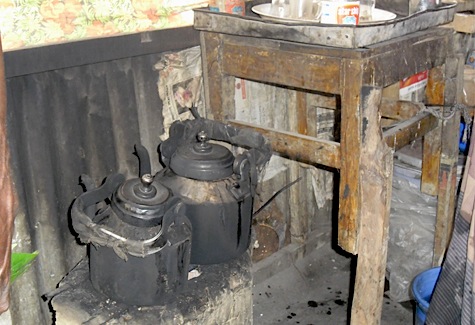
Shafik’s Teashop at Ghungiar-Gaon Bazar, Shalla
That was the evening of 15 August 2012. We had arrived by boat earlier in the day and had set out to record the reading of the Manasa Mangal—they call it the Padma Puran here. Linkon’s house was our first stop. In their small দশ ফুট বাই দশ ফুট room, Linkon’s parents live with their sons. Most of the space is taken up by the beds (we sat on one of them). There is also a desk with books and posters and pictures on the walls. Linkon’s father, Khitishbabu, had a business in book binding; now he makes paper boxes for packaging. Stacks of undelivered boxes lined the room. There is no limit to how much such a space can hold. In the middle of it all, Manasa presided, with coloured paper decoration around her. The women sat singing her praise. Linkon, who now goes to college in Sylhet, had come home, as he knew we were coming. He was doing most of the running around, organizing tea and food for us. There were people outside watching us through the open door. For Linkon, there was pride in this whole affair; he now knows such people, from his stay ‘abroad’. When there was time for introductions, Suman told us that Linkon was a very talented singer.
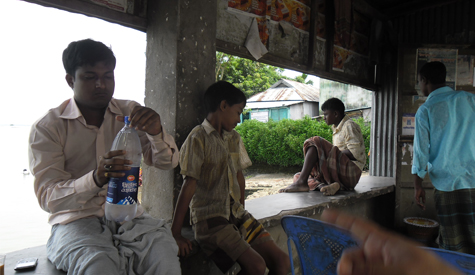
Suman
On a regular day in the city, Suman and Linkon usually meet in the office-cum-bookshop of Shubhendu Imam, alias Hannan bhai, writer and publisher and proprietor of Boipotro, the leading publishing house of Sylhet. Sumon has found Linkon a job in Hannan bhai’s shop, so the boy can support himself while he studies in an undergraduate college. Sumon often goes there after work to meet with the city’s intellectuals. Linkon naturally comes in contact with such people. Sometimes the ‘bhodrolok’ gathering asks him to sing. When he finishes college, Linkon will be his family’s first graduate. Perhaps he will find a better job then, or go for further studies. But he would prefer to become a singer. He watches television, and aspires to go one day to the young talents shows. He loves the voice of Sonu Nigam. Bollywood has planted a dream in Linkon.
The next day we went by boat to Haripur and Nainda villages, but came back to Shalla by the evening. Then we met at Shafik’s tea shop in Ghungiar Gaon Bazar. The tea shop is on the edge of what has now become a river, beside the ‘Jatri Chhauni’, where passengers wait for the next boat. Here, as evening descended, between cups of sweet tea, Linkon sang for us. The song here is a composition of Shah Abdul Korim, the legendary composer of this region, who died at 93 only a few years ago. Linkon sings beautifully, with great tenderness, but from his singing you wouldn’t think of him as belonging to this region. His voice does not carry marks of the place which birthed him, and which is steeped in the Padma Puran, dhamail, bichchhedi, murshidi gaan. Later we said amongst ourselves: লিংকনের গলা থেকে অঞ্চল মুছে গেছে। Linkon could belong anywhere now. Is this satellite television’s gift to civilization? It wasn’t just a matter of style of singing; Linkon after all was singing a song of his own region. The shift seemed to have taken place in the interpretation. And it wasn’t even a conscious interpretation, in my view. It was more a matter of processing and packaging.
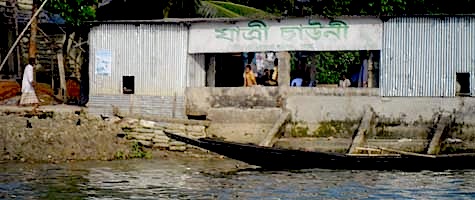
Jatri Chhauni
Korim Shah’s songs, as it is with songs of all mystic poets, have layers of meaning attached to them. On the surface they might be talking about separation and longing, but what this separation is, who or what from, is not spelt out in so many words. You make your own meaning out of a song, depending on who you are and where you are located; also what you want it to mean at a particular moment—a rich composition allows for so much multiplicity of meaning. Linkon’s song, it seemed to me, was losing this complexity, the bhav had changed, it had been reduced to a simple song of love. Beautiful and tender for sure, but made for that notorious ‘box’ as if. Back in 2006, we had met another beautiful and tender singer in Debicharan, Rangpur in the north of Bangladesh, Bipin Roy. He had sung a song not from his region, but from Netrokona in the east. Amar gaaye joto dukkho shoy. song Again there were no signs of a ‘home’ in the song. It could belong anywhere.
Interestingly, while Linkon was singing, a small group of passers-by had gathered in the shop. They were listening to the music but they were also curious about us. Who we were, what we were doing, what instrument Sukanta was holding in his hand, why he was wearing headphones, why we talked in this strange and unfamiliar way—they wanted to know. Our dialect confused them. This wasn’t Sylheti, for sure, but could this be Bengali? We were from India. So, was this Hindi maybe? You speak Bangla in Kolkata, they asked?
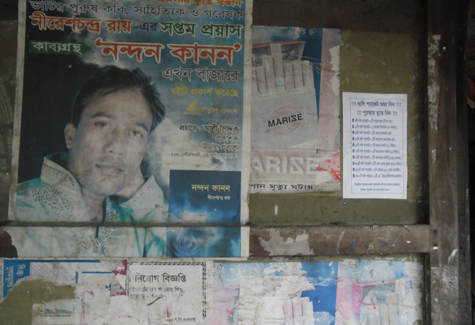
Poster announcing a new book of poems by a local poet
One man was more brave than the others. He said he would like to sing too. His name was Shishu Mia, he said. Then he sang. Again it had to be a composition of their ‘national’ poet—Shah Abdul Korim. And when he sang, every bit of his song and his voice became the region. He got his words mixed up, his lines were in disarray, but that roughness, that play with tempo, those cries—they can only come from someone who is rooted in this place. Linkon, by comparison, had become an outsider. I remembered Helal Miah in London. So far from the land of his ancestors, and yet so rooted. Is root then something we can carry with us where we go, and nurture in our new homelands?
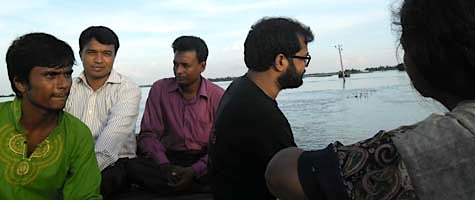
From left: Linkon, Dipu, Dharani, Sukanta, Moushumi
Linkon’s song:
কেন পিরিতি বাড়াইলায় রে বন্ধু
ছেড়ে যাইবায় যদি?
কেমনে রাখিব তোর মন
আমার আপন ঘরে বাদী রে বন্ধু?
ছেড়ে যাইবায় যদি।
পাড়াপড়শি বাদী আমার, বাদী … ননদী
মরণজ্বালা সইতে না’রি
দিবানিশি কাঁদি রে বন্ধু,
ছেড়ে যাইবায় যদি।
কারে কী বলিব আমি,
নিজে অপরাধী।
কেঁদে কেঁদে চোখের জলে
বহাইলাম নদী রে বন্ধু,
ছেড়ে যাইবায় যদি।
বাউল আবদুল করিম বলে,
হলো এ কী ব্যাধি?
তুমি বিনে এ ভূবনে
কে আছে ঔষধী, এ বন্ধু
ছেড়ে যাইবায় যদি?
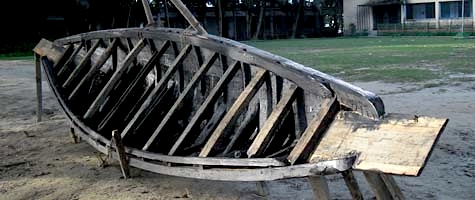
A boat out of water
And Shishu Mia sang:
মন রে তুমি কুপথে যাইয়ো না।
কুপথে যাইয়ো না তুমায় করি রে মানা
গেলে পাইবে লাঞ্ছনা।
তুমি চলো হুশ করে নইলে পড়বে বিপদে,
মন রে তুমি কুপথে যাইয়ো না।
সুজা সরল রাস্তা ধরো
কাম কামিনীর সঙ্গ ছাড়ো রে।
করিম কয় বা ভুল,
তুমি ঠিক রাখিও মূল
নইলে লাগবে গণ্ডগোল।
মন রে, মন রে তুমি কুপথে যাইয়ো না।
তুমি সরল সুজা রাস্তা ধরো
ছয় রুহুকে (রীপু?) বাধ্য করো রে
তুমি করিয়া সিজন [সৃজন?]
তুমার নাম করো স্মরণ, মুর্শীদো।
মন রে তুমি কুপথে যাইয়ো না।
কুপথে যাইয়ো না তুমায় করি রে মানা
গেলে পাইবে লাঞ্ছনা ।
মন রে, মন রে তুমি কুপথে যাইয়ো না।
Written in 2014.
The four recordings in this session come from an ongoing project on Manasamangal or the Song Cycle of the Snake Goddess, Manasa, which we have been recording, bit by bit, in different places in Bengal for some years. The idea is that over a period of time we will have different versions of the story of Manasa sung in different forms and styles across a whole range of places within Bengal and beyond, showing it as a living and evolving tradition.
The Manasamangal, also known as the Padma Puran, is a Mangalkavya sung for Manasa (the Mangalkavyas are devotional paeans to some local deity, composed in Bengal between the 13th and 18th centuries). This ritualistic song cycle is performed as a timeless but also living tradition in Bangladesh and eastern and north-eastern India; even in southern India. It is performed usually in the monsoon month of Sraban, i.e. from mid-July to mid-August, when it is the time of the snakes in a land of flooding rivers and swamps.
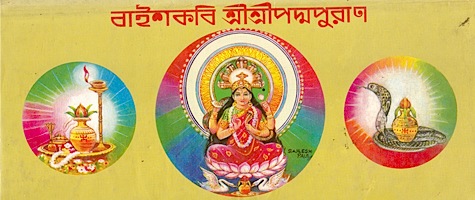
Book cover: Baish Kobir Padmapuran
In August 2012, we travelled for 10 days in Barisal and Sylhet, and caught parts of the story of Chand Sadagar, the merchant who refused to worship Manasa, preferring Siva instead; of Manasa’s anger and revenge against of Chand; of the death from snakebite of Lokkhindor, Chand and Sanaka’s last remaining son, on his wedding night, (all other sons were drowned in sea and Chand’s merchant vessels destroyed, before the birth of Lokkhindor); and of Behula (Bipula in Sylhet), Lokkhindor’s newly-wedded and widowed bride, sailing to the heavens with her husband’s corpse with the pledge to return him to life.
There are many tales about the origin of Manasa, a deity of partial godhead (for she may have been born when the aroused Siva’s semen dropped on a lotus or padma flower; hence she is called Padmavati), or she might have been a creation of the sage Kashyap’s mind or manas, hence Manasa. There is also the incident of Manasa losing an eye to the fury of her stepmother Chandi. Whatever her origin, Manasa is a one-eyed goddess who presides over a world of snakes and reptiles, and humans who live in close contact with such creatures. In practical terms, she is worshipped by those who need her protection; that is, those who risk snakebite or stormy rivers and seas in their everyday lives. Manasa is worshipped for her ability to prevent and cure humans of snakebite; she also brings them prosperity and fertility. When praised, she is benevolent and kind; when undermined and humiliated, she is full of vengeance.
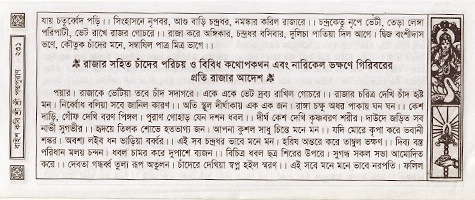
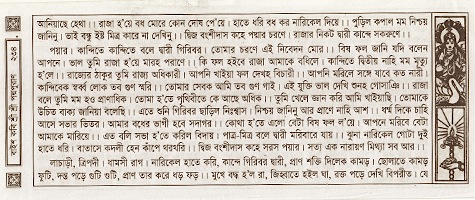
Pages from Baish Kobir Padmapuran
In both Barisal and Sylhet, the Manasa Mangal is sung from start to finish through the whole month of Sraban, mostly by women, as a community ritual. So also in Murshidabad, where Sukanta had made some recordings of Manasar gaan song back in 2009, when we did not have such a project in mind but he was only recording sounds for a feature film. Anyway, the fact is that in each place they sing their own versions of the same story, reading from panchalis or texts written down hundreds of years ago by their own regional poets. These poets localise the Manasa story—the land is described in local terms, rivers bear local names, the food is what local people eat—shaak, machchh and so on. . . Such are the signs of any great story, when it can be both local and universal.
The text most commonly followed in Barisal is by Bijoy Gupta, a 15th century poet of Goila, Agailjhara in this southern district of Bangladesh. The text followed in Sylhet, on the other hand, is the Baish Kobir Padma Puran, credited to 22 different poets, prominent among whom is the 15th century Narayandeb. As historical accounts go, Narayandeb’s original home might have been in Rarh in the heart of West Bengal, but it is believed that his family later moved to Kishoreganj, in the east of central Bangladesh. Interestingly, Narayandeb’s narrative is as popular in eastern Bangladesh as it is in Assam, and by Assam we are not only talking about places contiguous with Bengal, such as Cachar, which are in effect extensions of the Sylhet region. We are here talking about places distant and distinct from Bengal such as the Darrang region of central Assam. Here there is a very old tradition of singing and dancing the Suknani Ojapali (or Oja Pali), in praise of goddess Manasa; Suknani being an acronym of Sukabi Narayandeb.
So then, as we move on our trail of Manasa’s songs, listening and watching, recording and writing–for much of the Manasa rituals are also very strongly visual—we get caught in a complex web of overlaps, intertwines and juxtapositions. Enchanting new maps of rivers and forests, poets and devotees, snakes and charms, life and death, open up before us. There is something primeval, yet universal about this world. Behula sails with the dead from shore to shore, but we are assured by fore-knowledge that the dead will eventually come back to life and Manasa’s mangal or blessings will prevail.
What we have recorded so far lays out a basic structure of an ambitious field recording project that will take several monsoons to complete. The Manasa Mangal is a song cycle with important historical, anthropological, ecological and political implications of contemporary relevance. It upholds the image of a cosmos where the human and divine and animals and plants are bound in a relationship of harmony. The stories around the origins of Manasa and her place in the Hindu pantheon—tribal or Hindu, of partial or full godhead—lead to further questions about our social and racial relationships. Who is Manasa? What does she symbolise? More than a hundred years ago Ananda Coomaraswamy and Sister Nivedita had written: “[The] legend of [Chand Sadagar and] Manasā Devī . . ., reflects the conflict between the religion of Shiva and that of female local deities in Bengal. Afterwards Manasā or Padmā was recognized as a form of Shakti . . . and her worship accepted by Shaivas. She is a phase of the mother-divinity who for so many worshippers is nearer and dearer than the far-off and impersonal Shiva. . .” The related question concerns Behula; who or what is she? Is she creating, or following her destiny? Is she a free will, an indomitable spirit expressing her own desire for life and love or herself an object of desire, dancing to please the gods?
Perhaps it is too early in our research to try to find answers to these questions. We can try to talk about something else, which is no less important, if not more. On our first Manasa Mangal field recording trip in Barisal in August 2012–our third trip to the town–we were faced with a complex identity question. Our young friend and guide in this small town is Supriyo Datta, who works for an NGO, Nagarik Udyog. He is a Hindu by birth and is conscious of his community identity. He is taking part in the restoration of the local temple; it is an important social and political gesture, as assertion of a presence. We walk through Barisal and he talks of thriving real estate businesses, the filling up of the canals which once gave Barisal its uniqueness; he talks of past glory. It is very common to talk about such things, as there has been so much change in the last 60 years. Surpiyo very consciously belongs to his community but he is also consciously not communal. They talk about practical things. His young friend Suvro has just got a job in a government bank—they say it is a big thing for someone from the minority community to get employment in a government organisation. Standing by the lake in downtown Barisal where students and others gather every evening, Supriyo says, India makes it harder for us. The fence, the killings—the more such things happen, the more difficult it gets for us. They see us as enemies, at an everyday level.
This ‘us’, this ‘them’—this starts to trouble me. Supriyo, Suvro—they are saying such things to us because for them we come from the other side of the border, from the ‘safer’ land where ‘we’ are the majority by virtue of our birth.
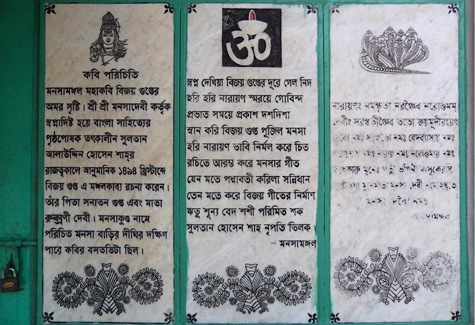
Stones with short biography of Bijoy Gupta and the story of poet’s dream about Manasa, Goila, Barisal
Then when we go to Goila, Agailjhara, where the poet Bijoy Gupta’s humble house and temple used to be, the place is slowly being promoted as a pilgrimage as Manasa puja is a very big thing for this whole region and Bijoy Gupta is part of the heritage of the region. The old temple which was crumbling down has been built into a glass and steel structure. What an aesthetic shift! Then there will be guided tours, bus service, shops, hotels, better roads, lights—will work to give the minority community some agency while some people, irrespective of community identity, will make some good money.
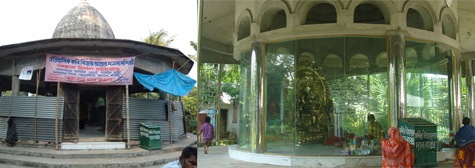
Bijoy Gupta’s Manasa Temple. Left: Before. Right: Now (2012)
For now the shaded places around the temple are still very beautiful. There is a performance area, where an annual festival of royani gaan—a theatre based on Manasa’s story—is held in these monsoon months. Then on Sraban Sankranti—the last day of Sraban which is usually around 15 August, thousands upon thousands of devotees come to the temple with their offerings of milk and banana. Manasa is said to have been an Adivasi (tribal) goddess who later got appropriated into the Hindu pantheon; in the past she was only worshipped by the lower castes. Hence her puja is also very humble, materially she does not ask for much. It is mostly the women who come to seek her blessing on behalf of the whole family. Among them are also many Muslim women, some even in burqa, who have come with their offerings. They will not be allowed to enter the temple, so someone else will place their offering before the icon of Manasa—again untouchability and desecration—but it seems as though people naturally accept this system of simultaneous exclusion and co-habitation. So long as them and their families are blessed, so long as ‘mangal’ reigns.
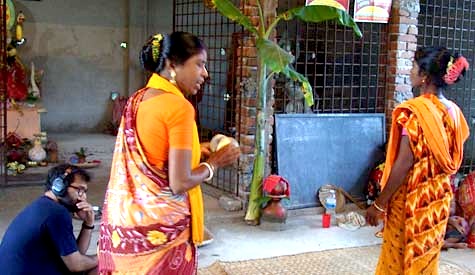
Royani performance in a manasa temple at Kaokhani, Barisal
Agailjhara women-Mangal Gaan
Bakal village in Agaijhara sub-division of Barisal district. 8 August 2012
This recording took place in the house of Bidyut Kumar Das, who works with Supriyo Dutta for Nagarik Udyog. A fairly educated community, reasonably well-off, many of the women in the congregation also had jobs. Bidyut’s wife, in fact, is a school teacher. However, the ritual of singing Bijoy Gupta’s Manasa Mangal panchali continues and even very young girls take part in it. On this day, as we were going to visit them, they made the occasion very special by singing through the day till late at night the story of the death and re-birth of Lokkhindor. It is the day of Lokkhindor’s maran and jiyon. Which means that the worst is over and now life will be renewed. They ended the day’s session with this song seeking Manasa’s blessings. This song is not part of the Bijoy Gupta text, but it is part of the ritual. ও কি জিলো,/জিলো লখিন্দর সর্বাঙ্গ সুন্দর/খণ্ডিল পদ্মার বাধ।
Wake up Lokkhindor, Padma’s curse has broken.
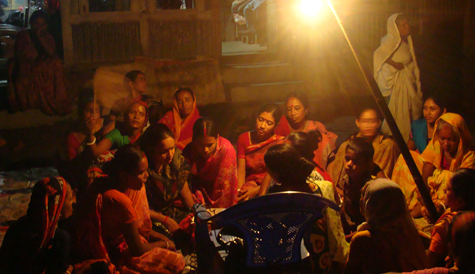
Women singing Manasamangal in Agailjhara, Barisal
The song then goes to name individual family members—those who must be blessed. Interestingly, they only sing the names of the men. বিদ্যুতের কল্যাণে এই দংশন জিয়াইলাম রে, খণ্ডিল পদ্মার বাধ। আশিসের কল্যাণে, বিভুতির কল্যাণে. . . One after another, they remember the boys and men of the community. Do the girls not matter then? They certainly do. Once the women sing: সবার কল্যাণে এই দংশন জিয়াইলাম রে. . . seeking protection for ‘All’. The women must be part of that ‘All’. But there is also an order in this universe, a clear separation of the world between those who seek protection for others and those who get protected. What can one say? The world of Manasa Mangal is a world riddled with irony and contradiction. There were many women singing that day. I have many names written in my notebook. Some came, some left, as the singing went on for the whole day, till late in the evening. Bidyut’s mother Rekharani Das sat like the matriarch on a chair, chewing paan; she has bad knees. The rest sat on the floor, around the book. One read, the rest sang in a chorus. They women took turns to lead. They did not really need the book, as they knew the whole text by heart. But they would also not be able to sing without the book, as it was integral to the ritual, sitting around it, like it was the deity. Purnalakshmi Sarkar looked like she could be 90—they said that she belonged to the Victorian times, উনি তো মহারানীর রাষ্ট্রের মানুষ। Jhumur Mondal studied in Class X, Nupur in Class VI, there were girls who looked like they should be going to school, but were already married, with think vermillion in their parting, even with children some of them.
What struck us in Barisal I think was the energy and dynamics of this social gathering, more than the pleasure of listening. The music was not always coming together, there were too many outside influences—of the radio, television, of ‘royani’ theatrical performances. As a result, what the tune of the land was, became hard to tell. It is only in songs like this mangal gaan that we got drawn into the plain and repetitive cycle of the panchali form. Such moments were rare in Bidyut’s village home in Bakal, Agailjhara. There was a certain festivity in the air, but less intensity in the sound.
Bahara girls-dukkher majhe janmo
17 August 2012
Almost 300 km to the northeast of Barisal, Bahara is one of those little villages of the Sunamganj ‘haor’ region which remains water-locked for more than six months every year. It is like those little planets Exupery writes about in The Little Prince—from one end to another, you can measure by the number of footsteps you take. Somehow there was no distraction in the Bahara singing. They noticed us, gave us seats and carried on singing. We made three sets of very interesting and different recordings that day. One was in the house of Rabindra Master, a retired school teacher, idealistic and pedagogic, who recited morally uplifting poetry with great emotion and action. Another was a group of men and women singing the Padma Puran, more in the style of kirtan, with accompaniment.
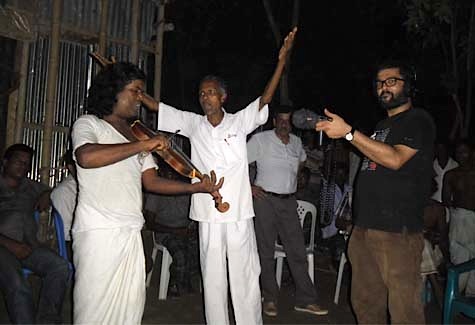
Rabindra master reciting poems
But what we have here is a group of three teenage girls, high school students, singing in the courtyard of their house, in front of their Manasa temple. The girl who is leading is Rimpi Rani, and she is totally unostentatious and absorbed in her singing, and her friends follow her with likewise dedication. The part of the story that they are singing is about the old Brahmin woman (Manasa in disguise) cursing Bipula (same as Behula, Lokkhindor’s bride) when she has gone to the pond to take a dip, that she will become a widow on her wedding night. ‘ছদ্মবেশে চন্দ্রধর ও লক্ষ্মীন্দরের গমন, বিপুলার প্রতি ব্রাহ্মণীর শাপ এবং বাদানুবাদে ব্রাহ্মণীকে পরাজয়’। The refrain that they sing is not part of the main text and it is something for which they have a stock. Here they are singing a lament, হায় গো, দুখের মাঝে জন্ম আমার গো। /হায় গো পাইনা শোকের সাড়া . . . Why lament? Because in these stories which are told and re-told again and again, the eventualities are known from before, and so the grief is also anticipated. This is the last-but-one day of Sraban and the next day is the day of immersion.
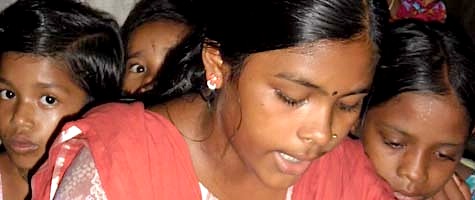
Rimpi Rani singing Manasamangal, Bahara
Nocturne
Shukhline, Dumra, Ghungiar Gaon. 17 August 2012
The night before the immersion of Manasa in the waters of the haor in this Shalla part of Sunamganj, is a night of music. The book, Baish Kobir Padma Puran, is read across the villages—Shukhline, Dumra, Ghungiar Gaon, all of which touch each other.

Haor
Turn around a corner, the name of the place has changed to become another village. We were sitting on the roof of our friend and guide in this Sylhet region, Suman Kumar Das’ house after dinner. His parents live in Shukhline, he works as a journalist from Sylhet town. It is he who had arranged for us to go and do this recording. On the terrace, there was music coming from every direction. Then Sukanta began to walk back towards our guest house. Walking stopping, walking. Approaching the music, then going past it. That night the sky was heavy with clouds. শ্রাবণের প্রায়-শেষ রাত।
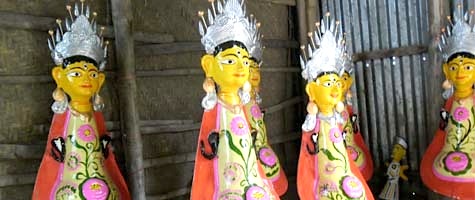
Manasa idol
Dumra men-bharosa gobindo
18 August 2012
This was the last day of the month of Sraban, শ্রাবণের শেষ দিবস। That day it is the men who sing in these temporary islands of Sunamganj in Sylhet. Something from the Padma Puran, not in any specific order though. The men go from house to house singing and in every house they are offered slices of the coconut fruit. Here in this recording, Shubhas Bose and his companions are singing the story of Chand Sadagar on one of his mercantile voyages, meeting the king of some land, with coconut and other offerings. The Chorus sings Bhorosa Gobindo more/ Rakho ranga paaye, —interestingly the gods come together in these utterances and the distinctions of Shaiva and Vaishnava seem to dissolve when it comes to the everyday lives of ordinary people. Unlike Chand of their Manasa Mangal story, they are flexible and open to the idea of any god who may give them support and protection.
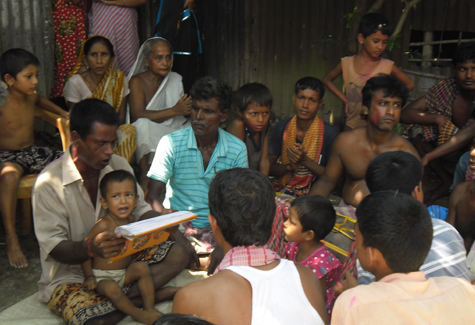
Men singing Manasamangal, Dumra
The song has now risen to a height, there is percussion accompanying the singing, the men dance as they sing. Today is the day of closure of a whole month of festivity. The boats will sail on the waters of the haor, the men and boys of every house will carry their Manasas with them, rarely a girl, and they will all be singing along the way. Then when they reach the deep point in the haor, they will take the plunge with their goddesses. Leaving their Padma and Neta to meld with the waters, they will rise and swim back to the boat.
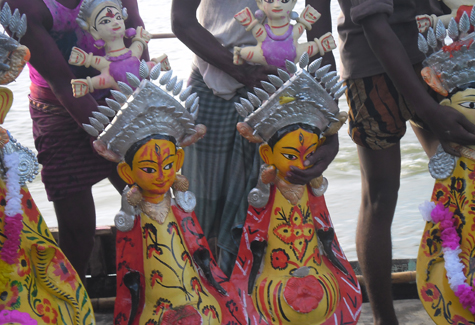
Taking their Manasas to the deep point in the haor
At home that night, the house is empty of the goddess, but the story must be sung to its finish. Now the women and men will sing the rest of the Padma Puran. They had left it at the death of Lokkhindor. Tonight Bipula will sail to the heavens and bring back her husband to life and with him his brothers and their vessels will all be restored. Prosperity will prevail for one more year. Not prosperity perhaps, but the hope of it at least.

Immersion procession in the haor
Written in 2014.
Related links
Manasa in patachitra
https://www.youtube.com/watch?v=gQkoiZUyuT8
A song by Dukhushyam Chitrakar and his team, scroll painters from Midnapur. This song was recorded in an exhibition titled “Ekchala” by various artists at Birla Academy, Kolkata in Dec 2010. The song was performed by the patuas as part of an installation on rivers by the artist, Amitava Adhikari.
This trip to Barishal and Faridpur was mainly to help some friends who have been trying to make a film on the poet Jibanananda Das. They had never been to Bangladesh before and we were their obvious choice as guides. Moreover, Sukanta has been the sound recordist of this unfinished project. We went on the old paddle steamer from Morelganj to Barishal. Then, on our way back, we wanted to introduce our friends to Faridpur.
The place never fails to surprise us. This time too was no exception. When we had gone a few months ago in October 2011, as we were entering Shambhunath’s tea shop, a man got up from his seat and excitedly said, Hello Moushumi Bhowmik, do you remember me? Remember, Banikanta’s village? সেই যে গোসাঁই দাস? I remembered well and clear: the man who in 2006 had wanted to renounce the world. His photograph is on our Contact Us page, standing with Sanjay and Sayeed in front of a mobile recharge shop where we were waiting to catch a bus to take us to Baotipara. Where he had come from I don’t know. ভাব জমালো সঞ্জয় আর সাঈদের সঙ্গে। বললো, বিষয় আশয় সব নাকি ত্যাগ করে দেবে, শ্মশানঘাটে ঘুমোচ্ছে ইদানিং। এই শুনে সঞ্জয় আর সাঈদ বলেছিল, ঘরবাড়ি দেবার লোক না পেলে আমাদের বলবেন!
So here he was again, re-entering our lives and soon we would realize how significant this reappearance was. No, he did not seem to have abandoned all riches, given away all possessions, or to be sleeping in the crematorium like he wanted to do when we had first encountered him. He was chatting with his lawyer colleagues in the shop next to Shambhunath’s.
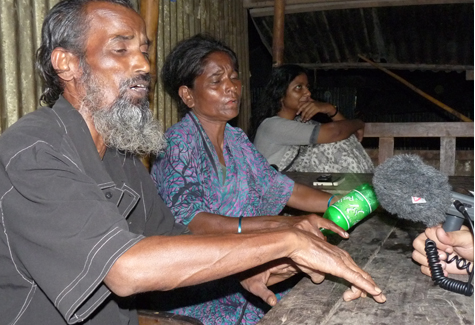
Habib and Laila singing at Shambhunath’s tea shop, Faridpur.
That day in October 2011, Habib the singer had arrived and the session with tea and music had begun. Habib sang one of his usual songs—Khul re mon tor del er kopaat—and we said, will you sing something new this time? He said, I am learning one or two new ones. There was nothing new about this answer either, because each time he says the same thing and then sings the same song. But his song always sounds so good! Of course, some days he is more immersed, and some days more distracted, depending on his circumstances.
On this October evening, while Habib was singing, our friend who was wishing to renounce the material world six years ago, got up and said, ‘Let me go and fetch Laila. I know where she is.’ We didn’t know Laila, but everyone in the tea shop got talking about her; they said that she was kind of a vagabond who often crosses the border and roves about in India, then comes back as unpredictably as she had disappeared. She is a great singer, they said. People call her Laili Pagli—Laili, the mad one. Then Laila arrived and she entranced us with her songs and stories.
Five months later we had gathered once more at Shambhunath’s. Our friends from Kolkata were with us: Indranil sen. Pratyush Banerjee, Tamonash Bhattacharya. Pratyush had a camera. Habib was singing and Pratyush was shooting the session. Suddenly Laila appeared! She said she had had a feeling we would come and sure enough we were there!
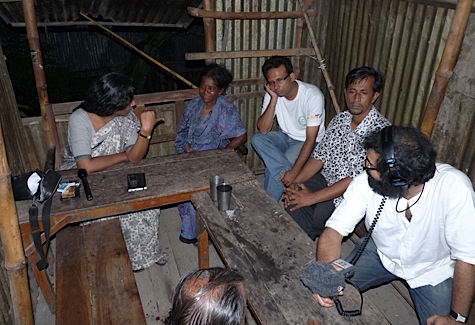
From Left: Moushumi, Laila, Sanjay, “The Renouncer” and Sukanta
This short film is edited from the recording session of that evening. Sukanta mixed his sound with Pratyush’s footage. Laili or Laila sang and talked non-stop. She is very versatile and sings many forms of songs. Here she is singing a Bangla qawwali, in praise of the ‘Boro Pir’ Abdul Qadir Jilani. The tune is typically north/northwest Indian and is an example of the continuing migration of music within the subcontinent. The stories too came into Bengal from other geographies. There are shrines of many local saints across Bengal, who belong to some bigger Sufi order such as the Qadiriya or Chishtia. In Faridpur there is the shrine of Duddu Shah (not to be confused with the Duddu Shah of Lalon Fokir’s lineage) , to whom Laila has pledged obeisance. She is his murid. Many of the songs she sings, such as this one, are in praise of Duddu Shah, but through him, the devotee is singing praises of Abdul Qadir Jilani, also referred to as Ghaus-E-Pak or Ghaus-E-Azam. This song, Salam lao he o Boro Pir is a composition of a local poet, Makhon, who was also Duddu Shah’s murid. At the end of the song, when asked who the song is by, Laila says, ‘Makhon. He was a great man.’ Then she adds, ‘There was such a man here. Kind of Hindu. হিন্দু মতো ।’
This ‘kind of’ also applies to Laila in many ways; there is much ambiguity in and around her. She has no fixed home; was a Hindu who converted to Islam for marriage, but straddles between Sufi and Hindu shrines. She crosses the border on her own terms without any papers, goes to faraway places such as Delhi and Ajmer, rides trains with no ticket, sings wherever she goes and in whatever she thinks the local language is (she has a great gift for picking up dialects and accents), even makes up songs in different languages. Then at one point she turns back and decides to return to Faridpur. The journey home is filled with as much uncertainty as the going out was. What does her family–her husband or her grown-up children; Laila even has grandchildren —think of all this? Her answers are vague and after you ask them, you realize that so far Laila is concerned, such questions are inconsequential.
That Laila is supremely talented and confident is clear from the way she is singing here. We can also see that she is bossy; she snubs Habib and refuses to give him room in the song. At first he tries to join in, but he is Laila’s opposite–he cannot be aggressive. So he leaves the stage to her. Laila and Habib are both essentially artists; talented and temperamental, both recognized for their madness. Such madness is indeed a rare gift and a blessing.
Written in 2014.
Once again we were in Faridpur. We keep going back to this small town in the West of Bangladesh, ‘closer’ to us than most of the other places where we go. We feel drawn to it; in Bangla we would put it like this: জায়গাটার কী যেন একটা টান আছে। Perhaps because we have very close friends here—Salamat Khan, Sanjay Shikdar, also friends of friends; some singers we keep recording—Habib, Ibrahim Boyati, Laila; often the same songs. We go to the same haunts—Shambhunath’s tea shop in the evening where Habib might appear and sing Anathero bondhu koruna sindhu song for yet another time; Sadi bhai’s shop where we will eat breakfast; then an evening of music in Sadek Ali’s courtyard, a special session of Jainuddin’s jari; or to the river. . .
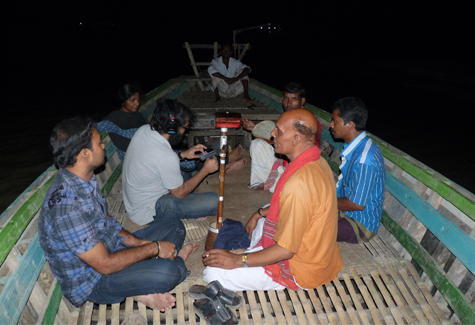
Recording Fakir Ajmal Shah and Emtaj on a boat on the Padma
It takes us about half a day to go from Kolkata to Faridpur. These days, the way we do it is, we call Sanjay or Salamat bhai and tell them when we are likely to cross the border at Benapole. We reach Benapole, usually in a taxi, and now most of the people at the border check-post know us —immigration, customs, money changer; also some of the young men who work as porter-cum-border-crossing facilitators. It is from the latter that we learn that our friends have arrived to take us home. Salamat bhai or Sanjay or both, sometimes with some other friends, hire a car and come and once our two-nation formalities are over, the rituals of our ‘reunion’ begin. We stop for lunch at Joshor.
On each new visit, within this sameness of Faridpur, there are also signs of change. A new bill-board is selling dreams of apartment houses and the happiness contained therein; a Dutch-Bangla Bank ATM has cropped up on Mujib Sarak, another a few yards away; there are fewer cycle rickshaws on the roads because wobbly rechargeable battery-powered three-wheelers have taken their place; these new vehicles emit strange birdcalls from time to time. There are more head-scarves on the streets; a shiny gift shop with cards and roses ; Ibrahim Boyati has shaved off his moustache; Bidyut serves tea in his father, Shambhunath’s tea shop because Shambhu da’s diabetic sores are eating up his feet. Bidyut’s tea is reassuring. Reassuring like the songs still sung around here.
We had first met Salamat Khan in 2006 and it is through him we got to record singers like Binoy Nath and Habib. All these years Salamat bhai had been telling us about Ajmal–Fakir Ajmal Shah. He said we should to listen to him at some point. It was late evening on 21 October 2011 when Ajmal Shah came to meet us at Dhalar More on the bank of the Padma. First we drank tea; then Salamat bhai said it would be nice to go on a boat to a quiet place, to record. Such was the wish, to find quietness, but motorised boats and mobile phones make a hell of a lot of noise. Especially as these days our phones can also endlessly sing.
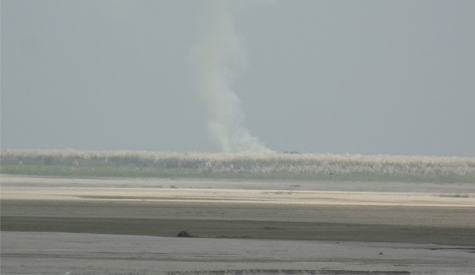
Char on the Padma
However, we went to Aat-trish Ghat , a little island on the river, a char. The Padma keeps changing course, Salamat bhai told us; where the river once was now we have charland. As it is, there is less water in all our rivers these days. In the fading light of the evening, anchored near the ghat, Fakir Ajmal Shah sang mostly compositions of Lalon, playing his ektara and dugi. Then when Emtaj played his dotara and sang, Ajmal Shah accompanied him on the dugi. In the background there were other voices; we hear them in the recording. We had met Emtaj earlier in the day at Dikrir Char in C&B Ghat. He was singing to a small audience gathered in a little shop. Salamat bhai invited him to the evening’s session. Emtaj and Ajmal sang in very different styles.
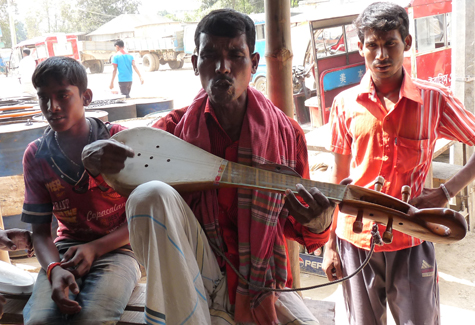
Emtaj singing in a tea shop at Dikrir Char, Faridpur
Ajmal Shah’s song reminded us of the late Binoy Nath, also the singing style of Khoda Baksh Shah, song who was his guru. His original home was in Sujanagar, Pabna, but Ajmal Shah had made this Faridpur-Kushtia region his home for four decades. Thus, his repertoire and style both carried the Khoda Baksh Shah-Mokshed Ali Shah stamp. For this session we have included a composition of Khoda Baksh Shah that Ajmal sang.
Emtaj does not carry the mark of any particular place or lineage. The song he sings here could well be from the Rarh (Birbhum, Barddhaman,Bankura) region of West Bengal. It has such a musical structure. This particular song, Amar matir gachhe lau dhoirachhe, is quite popular and has been sung by many artists and variously interpreted. Some of the song picturisations on youtube are indeed quite lewd. Yet, Emtaj’s singing has a mystical quality about it. He refers to the composer as Wahed. In fact, who the composer is or where he is from and whether he is dead or alive does not seem to matter to him. When asked at the end of the performance where the composer comes from, he says, Tangail maybe. It seems that all that is important for Emtaj is that he likes to sing this song; it inspires him.
Interestingly, the Wahed of Emtaj’s song was Sheikh Wahidur Rahaman of Biyanibazar in Sylhet, who died in 2012. The song was first recorded by Kangalini Sufia. So, perhaps the song moved out of its place of origin in its very first rendition when Sufia marked it with her own style, which in turn is marked by her location near Bangladesh’s western border with India, and by her multiple border crossings.
It is as if two opposed approaches to songs and singing are placed side by side in this session. For Ajmal, it is all about theme, composer and composition; about lineage and the rootedness of style. For Emtaj, his song has no fixed home. Which is why in our notes, we have left his song region box blank.
Written in 2014.
Bhakta Das has been coming to Kolkata for many years as a wandering singer, roaming from street to street, sleeping in the Dakshineswar Kali temple at night, and then going back to his house in the North 24-Parganas of West Bengal, near the Bongaon border with Bangladesh. We had heard him first time when his clear voice wafted with the breeze into our room in Jadavpur, Kolkata one spring morning. There are such singers who sometimes visit the neighbourhood, but we don’t always pay heed. Bhakta Das seemed different. So I went down and met him and invited him upstairs. This recording session took place in our apartment, in Sukanta’s improvised ‘studio’ (which comprises a couple of computers and microphones). Bhakta Das sang in the style of the singers of Faridpur and when asked, it turned out that we had guessed right; his old home was indeed in that region. But he had also left the place about 40 years ago, at the time of the Bangladesh Liberation War, as a very young boy. So then, how come he still retained such a style of singing? In fact, it wasn’t really a case of retention, the more apt question would be, how come he acquired such a style? Bhakta Das said though that where he lived there were entire Bangladeshi villages which had moved over from the other side. There were teams which sang kirtan and had sessions of kobigaan, Tinnather gaan and so on, such as they did in their old home.
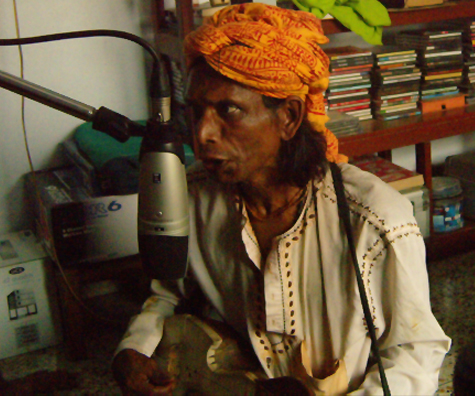
Bhakta Das
Here we have a very popular composition of Bijoy Sarkar, which anyone from that region would know. Ibrahim Boyati of Faridpur also sang it song. Bhakta Das sings his own version of the song; he keeps the basic structure of the song and mixes up the verses. Why does this happen? Is it because he does not know or is it because it does not matter to him to change the text? There is a certain naturalness in the way the text comes out in Bhakta Das’ song. Is it then in the nature of oral traditions that such changes occur?
I have presented here the text that Bhakta Das sang in our room and I did not attempt to write down a more ‘authentic’ version. The question that comes out this session is, how do we write about music, especially music that is part of an oral tradition? Do we write down what we hear or try to write ‘what we know to be true?’
Written in 2011.
Chandrabati Roy Barman was invited to the Baul Fakir Utsav in Kolkata in 2010. It was through our work that our friends in Kolkata had come to know about her. Our friend and guide in Sylhet, Ambarish Dutta, brought a team to this festival; this became the beginning of a new phase of music sharing between Sylhet and Kolkata.
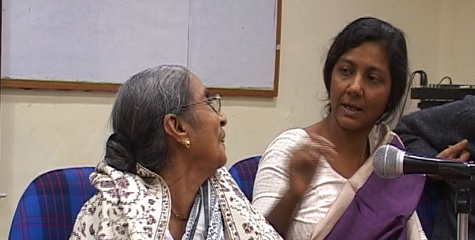
JU Conference
I was to speak at a seminar on orality and dissemination at Jadavpur University, Kolkata, at this same time. So I decided to make this presentation with Chandrabati mashima.
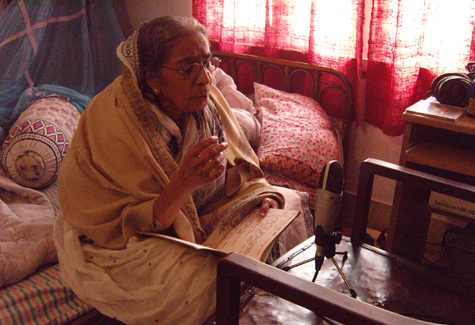
Masima singing at our place
The next morning, before I took mashima to her relatives in Birati, she sang a song I was trying to learn from her. She sat on the unmade bed and holding in her hands my notebook in which I had written down the words she had dictated to me, with light flowing in through the open windows and the water pump humming in the background, accompanied by a cacophony of crows, the attempt was to keep a record of the song, not so much to reach perfection in singing or recording. Now this song and her photograph in our house remain as her final gifts to us–the fact that she came to us and touched our lives with her grace.
Written in 2011. Last section added on 28 August 2014.
A team from Sylhet was invited to take part in Baul Fakir Utsav 2010 –they were mainly musicians we had come to know through our fieldwork in Sylhet. Ranesh Thakur, the main singer of this session, is the younger brother of our departed contributor, Ruhi Thakur. Here he is singing a song that Ruhi da had also sung during a recording session in Sylhet in 2006, which is also available for listening on this site. At this point we realise that our work has perhaps started to take a new turn. It is not only field recording and dissemination that we are engaged in now, but we are also being able to collaborate with friends to bring live music from our field in Bangladesh to audiences in Kolkata.
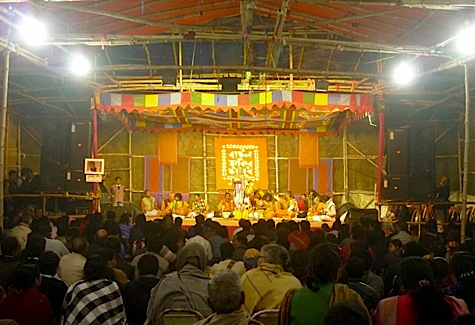
Baul Fakir Utsav, Jadavpur, Kolkata
Written in 2011.
This conversation with Sanchita Roychowdhury, whom we familiarly know as Jhun, and who has been a long-time friend, took place in my house in the winter of 2009. Sukanta had been working with Jhun and others on a project to restore old recordings of her father, Ranen Roychowdhury (1925-1985), the legendary singer of Bengali folk songs. The songs were released on a CD , Pari Dhoro Sujano Naiya, song by Lok Saraswati in 2008.
Conversation at 26H
Over the years I had had had several discussions with Jhun about her father’s music, her own practise, and other related matters. So this time we thought of recording a formal conversation with her, to add to our archive.
Immersed in a Ranen Roychowdhury song
Written by Moushumi in 2018
When Gour Khepa succumbed to his fatal injuries from a road accident in a hospital in Kolkata on 27 January 2013, there were many friends and bhaktas (devotees) waiting outside to take him to his samadhi or burial in Kankalitala, not far from his home in Bolpur, Birbhum. There this wild and restless artist would sit now in eternal meditation, under the ground, as is the practice among the Vaishnavas. Pity Gour could not see who all had come to see him for one last time, for he so loved to be at the centre of things; charming, entertaining or disturbing people with his words and wildness.
The veteran Purno Das Baul got out of his car and talked to the Press about the unfairness in this sudden disappearance of a musician so much younger than him; Paban and Mimlu stood waiting for their friend of many decades; Ruchir asked questions about funeral plans for one of his most charismatic heroes of Egaro Mile; Gautam Chattopadhyay’s son and daughter stood by quietly, remembering other untimely deaths perhaps. It seems that Gour had sung a brilliant version of Gautam’s song ‘Telephone’ at the urban baul’s memorial service in 1999.
There was grief in the air at Gour’s ‘transition’, especially in our Baul Fakir Utsav circle. The last festival, our eighth, had happened only two weeks ago to which Gour as Gour had come to conquer, as he always did. Neither Sukanta nor I was in Gour’s close circle; in fact, I found him a bit intimidating. Yet, back home from the hospital that day, all I could think of doing was to listen to his interview which we had taken in 2009, and transcribe it, word for word. More than a year has passed and meanwhile we have had our ninth festival; this time with a huge cut-out of Gour standing in the doorway to the performance tent, for it was hard for his countless admirers to imagine a festival without him. The 2014 festival journal was also dedicated to Gour, there were T-shirts designed with his face. Even those critical of Gour could not ignore him.
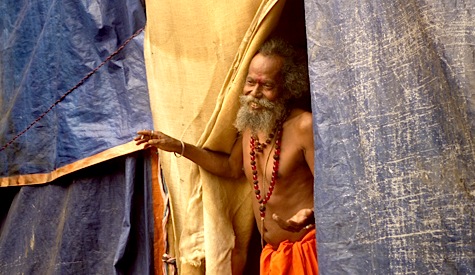
Gour Khepa in front of the tent, Baul Fakir Utsav, 2013
What was so special about Gour? How come this enduring charm? If not charm, at least the ability to draw attention? Was it hype? But even for such hype to build up, there has to be some history.
Gour had talked about his journey through life in his interview with us in the morning of 18 November 2009. He was perfectly sober and seemed to be enjoying this conversation with his devoted pupil Satyaki Banerjee, Sukanta, another friend of ours, Biplab, and me; reminiscing really. Being characteristically caustic and full of himself. Well, what else was Gour supposed to be? That was part of his charm—that he could say whatever he liked, he did not care to be pleasant. মুখের ওপর যে কোনো কথা বলে দিতে গৌরের জুড়ি ছিল না। যেন সবার মুখোশ খুলে দেবার মহান দায়িত্ব দিয়েছিল কেউ ওকে। (এই যে গৌর লিখছি, ‘ওকে’ লিখছি, যেন দাদাটাদা বলা যায় না। আপনি করে সম্বোধন করা যায় না, করলে অদ্ভুত শোনাবে। যেন দূরে থাকলেও আসলে কাছেরই ছিল মানুষটা।) But it was a lot of talking he did that day, serious talking. Towards the end he was getting restless for a drink and music, but by then it was also time for us to leave. He sang a little bit, playing his ektara like a khamak, for the string of his khamak was broken. It takes pure genius to play an ektara like that. I think it was the genius of Gour, which was also behind the making of the enigma that Gour was.
Let’s go backward from the last song.
He turned on his electronic tanpura. Ore amar mon goala,/Roj dubela doodh doabi—a song about the pure essence of life that we must try to draw out bit by bit, like milking the cow. We must also know how to preserve this ‘milk’; cannot let the preying cats and ants with their kuprobritti (badness) destroy it. Poor paraphrasing I know; it is hard with these songs. However, what strikes us is the tanpura, which had become an obsession with Gour. Somehow he had to make this point that he was ‘classical’, he knew his raags, and thus he was musically superior. (Grotowski had said that the purpose of his art in the Theatre of Sources, to which Gour had been invited one year, was ‘first to discover differences, then to discover what was before the differences.’ Perhaps the ‘pre-differentiation art’ Grotowski had found in the baul world was more a thing of his imagination; maybe that is what he needed to see and show to others. In the baul worlds around us, as in any other world of art and artists, there is fragmentation, contestation and differentiation. Could it have been different a long time ago, when ritual was art? How to say?)
Anyway, coming back to the point about classical and folk, Sukanta and I often say that it is strange, also sad, when the finest artists of a genre do not seem to be sufficiently convinced about the greatness of their own art. Why must a baul be classical in order to be special? If everyone cannot be Abdul Karim Khan, then everyone cannot be Gour Khepa, Sanatan Das or Purno Das either. There was no tanpura on the day the eclectic writer and thinker, Deepak Majumdar, had heard Gour in Tarapith, in the mid seventies; he hadn’t yet started to feel the need for one.
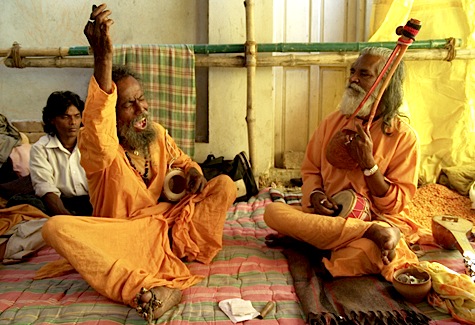
Gour singing with his khamak. Biswanatha Das Baul accompanying with the ektara and dugi.
‘তারাপীঠ মহাশ্মশানে তীব্র উন্মাদ অনুরাগে, নির্দিষ্ট কুম্ভক পাকের মোচড়ে, ঝাঁকড়া-সজাগ মাথাভর্তি চুল চামরের ছন্দে, মেরুদণ্ডের হাতে দুলিয়ে, খমকের সটান-তীক্ষ্ণতায়, দু’পায়ের আকস্মিক বজ্রযানী লাফে, মর্মপ্লাবী দু’চোখের ভাসমানতায়, ঠোঁটের অনাথ-চড়ুই উদ্বেগে, বীরভূমের নাগার্জুন-প্রতিম বাউল গৌরক্ষেপা ঘটিয়ে তুলছিল এমন এক আত্মনিবেদনের জগৎ, এমন এক আত্মবিস্ফোরণেরও ছবি, যার কোন সংজ্ঞা হয় না, কোন তুলনার আলিঙ্গনে যাকে বাঁধা যায় না, চল্লিশ মিনিটের যে ব্রতচারণ মানুষকে ডেকে নেয় এক ভ্রূণাকুল সৌন্দর্য-সাঁতারে।’—দীপক মজুমদার, মাটি-আকাশের দূরন্ত খেলা, কলকাতা: মনচাষা, পৃ ২৩ ।
Again, impossible for me to translate. If Gour knew how to sing, then Deepak knew how to write. But one phrase stands out in this description: কোন তুলনার আলিঙ্গনে যাকে বাঁধা যায় না. . .There was no need to measure yourself against given standards, Gour. You were this amazing performer; people have seen you, they have written about you, they have filmed you. What more can there be to ask for in this one short life, which can end as unexpectedly as it had begun?
There were not many people Gour loved and respected as much as he felt for Deepak Majumdar. Deepak too seems to have felt a deep reverence for him. Writer and musician Mimlu Sen (Baulsphere) said that when Gautam Chattopadhyay and Deepak made Gour their friend, there was an element of hero-worship in it (See Baul Fakir Utsav journal 2014 on Space). Perhaps it was not just that. It was also a matter of mutual admiration between two artists.
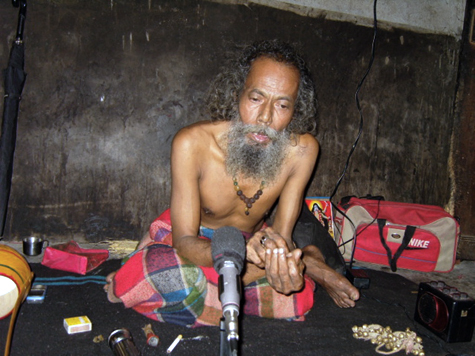
Gour during the interview session
Gour on his birthday and birthplace
This is how our conversation had started on 18 November 2009.
‘Plus minus one month—which means now I am 63. In January I will turn 64’
‘In January? But your birthday is in September. So you will turn 64 in September. From birthday to birthday . . .’
‘How can that be? It has to be calculated by the year.’
Everyone laughs. ‘Agreed, that is also a way to calculate.’
‘This is a different arithmetic. Like Deepak da would say. I took Deepak da to my desh (birthplace). ‘
‘Where is that?’
‘That’s in Labpur thana area. There is a place called Tarulia Lajpur in Labpur thana area. I took Deepak da with me when I went for my passport. When I needed a passport. Deepak da had organised the whole thing for me, he took me.’
‘When you went to Poland? Was that the first time?’
‘Yes, Poland. After Jerzy Grotowski had come to me. So then I said, dada, I don’t know about these things. You have to come to my birthplace. So he went with me and got all the information about my birth from there.’
Childhood and first lessions
Bhaba Pagla
Subal Gosai
Santiniketan
Deepak Majumdar guided Gour through this trip to Poland. Later they had their differences, but Gour was also aware that if there was one person who matched up to him, it might have been Deepak Majumdar. Gour was a frightfully intelligent man. He rattled off names of places and people; analysed events; picked up things from what he saw and heard, which he could later put to use with exceptional capability. Which is probably why he so enjoyed the company of Kolkata’s intellectuals from the start; he liked to see them not so much as his patrons but more as equals. He despised, what he called, the ‘shweeper class’—which was a sweeping generalisation. Anyone could be seen by Gour to belong to such a category; for what they sang, how they lived and what they said. Gour was not one for political correctness. This was probably why students and artists from the city continued to gather around him. They were attracted to his subversion, while—I think (maybe some people will not like me for thinking this way)—he was also quite conscious that his subversion could be attractive.
Bhaskar da and Deepak da
In his conversation with us that day, Gour had talked about visiting London for a month during the Poland trip. He went with Bhaskar Bhattacharya, another important friend of the Bauls. ‘Bhaskar da took me to the BBC, he got me concerts in London, kept me in his house, looked after me. He was a friend of many years.’
‘Tell us then, how were Bhaskar da and Deepak da different? What was different about their methods and attitudes?’
‘Bhaskar da and all—they were into the glamour of making films and would squeeze every bit out of a situation. Deepak da had wisdom. You ask him about any subject, about your PhD, about anthropology, anything to do with texts and learning, Deepakda always knew the answer. Deepak da belonged to a different world all together. English, Bangla—ask him about anything in any language, and he will know the answer. Bhaskar did not have that kind of depth. He was more interested in making films, organising concerts, showcasing artists—he had business in mind. This is how I saw him. Deepak da was not like that. He was not business-minded. He gave away all he had and then died a pauper. He entered the pyre at Keoratola [crematorium] as a pauper; we had to beg to raise money for his treatment. I performed his last rites.
Deepak da was different from others. The only problem was, he didn’t have enough self-knowledge. Knew paratattwa but lacked in atma-tattwa. He could explain things to others, but not to himself.’’
Now of course they are all gone. Gour, Deepak, Bhaskar, Gautam. No one left to feel proud, no one to take offence any more—all mighty talented men. Gour had said of Grotowski, ‘He was so talented. Those with talent don’t live for long. Think of Michael Jackson!’ Gour had said.
Deepak wrote about the Gour-Grotowski connection. ‘জর্জ লুনোর পরিচালনায় ‘দিব্যোন্মাদের গান’ ছবিটি তোলা হল ফরাসি টেলিভিশনের জন্য। অভিনন্দিত হল ইয়োরোপ জুড়ে। সারা পৃথিবীর নাট্যচর্চায় আলোড়ন সৃষ্টি করেছেন যিনি, সেই জের্সি গ্রটাউস্কি এলেন পোল্যান্ড থেকে, মুগ্ধ হলেন গৌরের প্রাণশক্তি দেখে, আমন্ত্রণ জানালেন তাঁর ‘থিয়েটর অফ সোর্সেস’ ওয়ার্কশপে যোগ দিতে। ১৯৮০ র গ্রীষ্মে গৌর পোল্যান্ড গেল। তিন সপ্তাহ পর আমিও পৌঁছলাম। গৌরকে দেখলাম এক অভূতপূর্ব আন্তর্জাতিক স্বীকৃতির সামনে নির্বিকার উত্তেজনায় দাঁড়িয়ে থাকতে।’
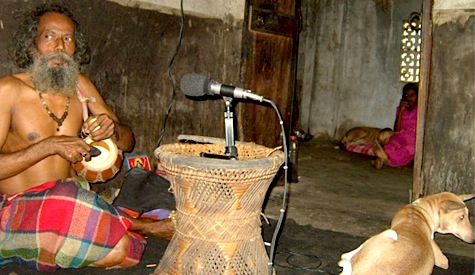
Gour in his house at Nichu Bandhgora, Bolpur
So, this Theatre of Sources to which they went—Naseeruddin Shah and Rekha Sabnis from Bombay, Abani Biswas, Ramkrishna Dhara and Prabir Guha from Calcutta, and Gour and Deepak—they all became friends. Deepak writes that Gour did not like the food—the fact that there was no one to serve. So some days he would end up eating eight to nine eggs. Gour would quote Shankarbaba who said that the act of offering food becomes both an act of giving and receiving. Such as the mother feeds the child in her womb. He was missing that in Poland, Deepak felt. Then when they went on tour with the theatre company ‘Gardzienice’ to villages in eastern Poland around the town of Lublin and when the local people in one village seemed particularly hostile to Deepak and Gour and kept making them drink loads of vodka, Gour offered them songs and laughter. The hard-faced people slowly began to smile. Wlodzimierz Staniewski, the theatre’s director, told them later that the villagers had thought that Gour and Deepak had been sent there by the devil. But Gour had won them over. You offer in order to receive, like the mother, Deepak wrote of Gour.
Grotowski in India
Gour described to us his experience of Grotowski and Poland in his own words. ‘Then Grotowski came [through the Deepak-Chitrabani-Father Gaston Roberge route]. Then he took us to many places across India—Kerala, Bangalore, Andhra, Rajasthan, Gujarat; at the end we came to Joydeb; Ramananda Khepa was there then—‘
‘Was your performance part of a larger performance or did you just do your own things?’
‘No, there was no main play. Each of us did our own thing. I mean, that is how it was here in our country. In Poland it was different. I am coming to that later. What Grotowski did here was, first he selected us; and then he took us to many places, to mountains and forests and placed us in particular settings and asked us to do our own thing while he watched us. He had his special eyes with which he saw, what we were doing, how we looked; such as we look with one eye through the lens before ‘doing’ the camera (ক্যামেরা করার আগে).
‘Then he discussed the plan with us in his [Deepak’s] Naktala flat [in Kolkata]. Said, you won’t get any ganja, there is no ganja in that country. But alcohol, sure; vodka, whiskey, rum as much as you like. Meat, fish, chicken there will be plenty, he said. So he invited me to his country. . .
In Poland
‘Then visa and everything was sorted and we went to Warsaw. They put us up in this building; my forefathers have never been to such a place! It was a huge thing! There were pine trees all around and when the strong wind blew through the pine trees—the storms in Poland! God, my forefathers have never seen such storms! The trees trembled and it felt as if there was an earthquake inside the building. In fact, inside that building I felt that there was always a tremor. And this tall matchbox of a house in a small neighbourhood –the scale of things—I was astounded . . . ‘
‘When was this? Which year?’
‘I don’t remember all that. And anyway, you just listen now to what I am saying. Then the food: everything was so smelly. I don’t know what oil they used for cooking. Poland! Food of the Communist country—no spices, they cook in vinegar, olive oil, who knows what? I began to eat omelettes with butter.
‘Then we went by train to this place, Wroclaw [The name is pronounced something like Vrotswaf, and Gour was quite close. Gour had in fact quite accurately retained the sound of the words; because sound was his source of knowledge. For us who are hovering between our written and sonic sources, the matter of transcription can be very complex: the problem of ‘writing’ sound is a recurring problem in our work. For example, during this transcription, it has been very difficult to find the corresponding written word for the sounds that Gour was giving to us, especially for unknown names and places. ] The train ran at such speed—my forefathers have never seen such trains! It had a pointy nose and sped like a rat; we don’t have such trains in India. It started-hoop! And stopped—goop! They kept us at the theatre, but I was totally constipated. This new place and the severe cold and we had gone from our hot place—I just could not shit.
‘Then they transferred us to Brzezinka-Ostrowina, the forest. There were wild boars in the forest, killer boars—real danger stuff. This was a forest and there were swarms of mosquitoes. They gave us ‘natural’ food and we would have to cook our meals. Got into real trouble because here I had never cooked, Haridasi [Gour’s first wife] would feed me. So I began thinking, god this life of a recluse, how shall I live it for a whole year? Then I needed to shit and went to the toilet and sat down to shit and somehow forced myself; was a real struggle. Then I looked around and there were rolls of paper with blue and yellow flowers, but no water! There was no tap but paper rolls everywhere.
‘There was a –well, they call it river but for us it is only like, you know, just from here to here—however, the water looked clean and nice. So I went –I wasn’t thinking at all—and put my feet and hands and bum in that water. There was to be an interview within an hour. People would come to ask questions. I would have to sing and show all our stuff. Damn! Forget singing and talking, I had to be admitted to a hospital. They fixed all sorts of machines to my hands, I felt numb with pain and it was as if my bottom had come off. My feet had swelled up and seemed to weigh a hundred kilos. I was trembling in my bones. I was in real trouble. So from then, in the daytime, I would use and throw away those rolls of paper in the name of my ancestors, and at night I would wash my bum with hot water and go to bed. What to do? Such was the life of Gour Khepa!
‘Food was also a problem. I found it hard. But the more important thing is that Grotowski loved me very much; he was a good man.’
Theatre of Sources
‘Did you have music programmes in Poland or did you do something with their theatre?’
‘It was—well: imagine a mela. Say, there were ten groups. So they placed the ten groups in ten different places. One Manitoulin, one Whirling, one music, one dotara, one guitar; one African, one Manipuri, one Baul—all happening at the same time. All going on simultaneously. Say, here one, here another, there one, there another, there another . . . like that. So it will happen all together for seven days, then will stop for seven days. At a fixed time every day, around dusk. ‘
‘Here one, there another—does that mean it was on the same stage or was it in some special performance space?’
‘In the forest. That’s where it was happening. Here manitoulin, here whirling–‘
‘What was that? [Manitoulin, we meant]’
‘One man, he would go round and round for three hours [Gour meant the whirling dervishes, I suppose]. Then Manitoulin—they had a piece of wood which they tuned up and produced a particular sound and they danced to that music.’
‘Which country were they from?’ [I think I know now. Probably they were Canadian Aboriginal] ’
‘I don’t know. They came from different places. Jerzy Grotowski had brought everyone. They had made space in the forest for everything to go on at the same time.’
‘So that people would go from one performance to another and see?’
‘Yes, people would go around the whole place. Then there was this guy, Claudoo/Kladu [this is the kind of name Gour was saying and I have no clue what the actual name was], he would drink four or five bottles of the finest vodka [number 1 vodka, Gour said] and vomit into the fire and the flames would rise up high and people would watch. All kinds of strange things he had assembled. He was putting up a show, a theatre. . . . It was not like our stage shows, not like jatra, theatre or our plays.
‘But Grotowski’s theatre, I’ll tell you how it was. Four or five people come into the room and make strange sounds, others respond. They don’t really talk in any language. But make a strange noise, as if they couldn’t talk and so they were talking in gestures.’
‘Did you also take part?’
‘[Laughs] No I just sat and gazed dumbfounded.’
‘So, this was Grotowski’s own composition?’
‘His own. And he was a specialist in alcohol; drank the best vodka all day long. But he was always alert. No one would say he was drunk. And he ate lots of eggs—a hundred, hundred fifty boiled eggs.’
‘Eggs?’
‘Yes, eggs. Eggs, vodka, and then cream and butter [মাখন, সর, চাঁছি। Think he meant cheese].’
‘So he didn’t tell you that this is what you have to sing? You could sing as you liked?’
‘No, not anything we liked. Baul songs. Dehotattwa songs or Radha Krishna tattwa songs. Deepak da guided me. He said, your song should hold the heritage of our land. Don’t sing some rubbish, don’t fool people, just because they don’t understand the language. Because it would all come out at the time of translation and if I sang some rubbish song, then it would be quite disgraceful for us.’
‘Did anyone record you at that time?’
‘No you weren’t allowed to go there with your camera or any other recorder, because you were going as a student. You were going there to see, but also to take lessons. That was the idea. That, here see, this is what you can learn from this country, this from another country. See if you can learn anything. So, someone might see my gabgubi [variable tension chordophone] and then he might keep coming every day; morning and evening. There was no spare instrument, so I could not help much. But he picked up bits of music on his guitar.‘
‘Did anyone learn anything from you?’
‘There was an Italian boy, Stefano. And another Jarek.’
‘They learned to play [the gabgubi]?’
‘No, how would they learn the gabgubi? But they learned some things on the guitar.’
‘Did you play together?’
‘I tuned up his guitar like a dotara and he would strum along. I couldn’t have him play, because that would stop my song.’
Grotowski had assembled artists from different parts of the world for his Theatre of Sources, for his transcultural experiments in Brzezinca and Ostrowina. From the Haitian voodoo artists to the Bauls of Bengal, who were to him both yogis and artists; the Yorubas of Nigeria and the Huichol of Mexico—he made research expeditions to places where ‘archaic’ rites are still alive and selected his artists. The Gour- Grotowski encounter resulted from such an expedition. Grotowski had said that the goal of his exploration was ‘to re-evoke a very ancient form of art where ritual and artistic creation were seamless. Where poetry was song, song was incantation, movement was dance.’ (Interviewed by Sylvia Drake, published in Los Angeles Times 0n 29 September 1983).
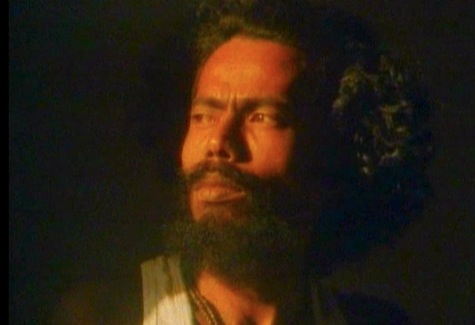
Young Gour, a still from Ruchir Joshi’s film, 11 Miles
I think of Ruchir Joshi’s film, before him Georges Luneau’s, before that Deben Bhattacharya’s recordings, Richard Lannoy’s photographs, or earlier still, Arnold Bake’s footage from Kenduli in the 1930s—they all give glimpses of that world where movement was dance, song was incantation, poetry was song.
In writing ‘was’, we are probably suggesting that that world is no more; it is gone. But, that does not necessarily mean that all is lost. Nothing can be as it was.
On Ruchir’s film, 11 Miles
Ramananda
Gour would not see Ruchir’s film, Egaro Mile, although he was so much in it. He used to say that seeing all those people who were dear to him once but were gone now—Haridasi, Ramananda, Joya Khepa, Deepak da—that would be too painful. But the point is, even if Gour had seen the film, would he not be seeing his own past, a time gone by, a time to which he would never be able to return? In a sense, would he not be encountering his own death? When we look at an album of old photographs, what do we see? Death or life? Life as it was, or life that is no more? About Ruchir’s film, Gour told us: ‘He has said the story in his own way, the way he saw and what he wanted to show. He got some of it. He didn’t get some.’
In other words, Gour was talking about perspectives.
About Paban and going on foreign trips
The storyteller has a perspective; the listener has one too. Mimlu describes the last time they met Gour, a few days before his accident. Mimlu and Paban had got off the train at Bolpur station and there was Gour sitting on the branch of a tree. He was watching the train, waiting for who would come, whom he could capture. In this story, Mimlu is seeing Gour’s dangling feet while Gour is seeing Mimlu and Paban’s heads. And as we listen to the story, we see Mimlu seeing Gour and Gour seeing Mimlu.
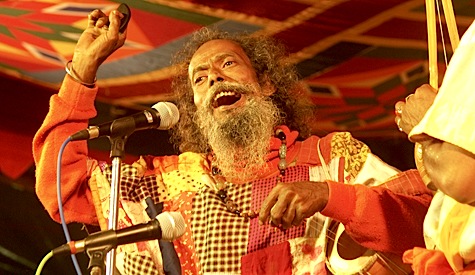
Gour singing at Baul Fakir Festival
As we listen to our interview of Gour today, we know that he is gone. This knowledge pre-conditions us. On that day we went to their house, Durgadasi, Gour’s last khepi (partner/wife), was saying, ‘It is hard enough that I have to hold on to you.’ Gour had replied: ‘Let go of me then, don’t hold me back’. The words gain new meaning now. A simple thing said half in jest, in typical Gouresque manner, sounds slightly prophetic. At the hospital, Durgadasi was singing to herself a wailing song—‘ও তুমি কোথায় গেলে গো, ও আমি কেমন করে থাকব গো, ও তুমি কেন চলে গেলে গো, ও আমায় কেন ফেলে গেলে গো, ও আমি কেমন করে থাকব গো।‘ Where have you gone? How shall I live? It is common to wail in this way in this part of Bengal, Sukanta tells me. As I play the interview over and over to transcribe it, the sound of Durgadasi’s voice entwines with Gour’s. I hear both; voices from the past brought into the future.
Natural and Chemical!
On changing audiences
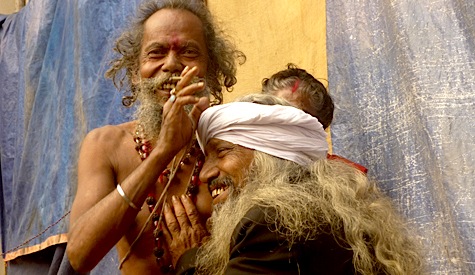
Gour with Tuntun Fakir of Kushtia, Baul Fakir Utsav, 2013
Fakiri gaan
_________________________
Written in May, 2014
Related links:
Grotowski: http://www.grotowski.net/en/encyclopedia/theatre-sources
Paban Das Baul: http://en.wikipedia.org/wiki/Paban_Das_Baul
Gautam Chattopadhyay: http://en.wikipedia.org/wiki/Gautam_Chattopadhyay
gautamchattopadhyay.com
Moheener Ghoraguli: http://en.wikipedia.org/wiki/Moheener_Ghoraguli
http://moheenerghoraguli.hpage.com/
We had this session in the courtyard of our late friend, Sadek Ali’s house in Ambikapur bazar, Faridpur. The evening before we had had another session inside his house. Like his mentor, the poet Jasimuddin, Sadek Ali bhai was a true lover of music, which is why he could open his doors to anyone who came to him, for or with music, anytime of the day or night.
Our first experience of jari, a form of narrative folk song of Bengal based mainly on stories of the Battle of Karbala, was in 2006. Looking back now, however, I feel that at that time the significance of the form, its content and history, and its beauty, had passed us by. Jari is derived from Iranian azadari , the ritual of lamentation (from the Arabic aza and Persian dari). The day we had gone on a boat to record music on the Kumar river, Sadek Ali had sung an abridged version of the Hanifar jari, also known as the Khatnamar jari, or Chacha-Bhatijar jari. It is the story of Hussain’s son Joynal (Zainul Abedin) sending a letter to his chacha (uncle) to save him from the tyranny of Ejid (Yazid) after the death of his father in the Battle of Karbala. The previous day we had had a recording session in Sadek Ali’s house, and Nuru Pagla had sung another version of this same jari, although Nuru had mistakenly called it the Shohidnamar jari. But none of this had struck us then. It is only with repeated visits and replays of the recordings from those sessions, that we have been able to go beyond Ibrahim Boyati’s bichchhed or Idris Majhi’s bhatiyali, which had seemed like the main gifts of those 2006 sessions. It took several years to realize that that trip had opened up for us the possibility of new journeys into yet uncharted songlands.
As in many other cultures, in Bengal too it is common to sing long and short narratives or to tell stories through songs. Jari, kobigaan, palla gaan, kirtan, agomoni, panchali, punthi, goshtho are all different forms of narrative song, based mostly on Hindu or Islamic mythologies. In some of these forms, the way of telling the story is through a chronological ordering of events with plot and subplot and moral preaching. In some the storytelling is more argumentative. These are communal songs; that is to say, they are songs of the community. The audience and performer are bound together in the telling—rather, re-telling —of tales that they both know. Thus, between the listener and the storyteller/singer, a kind of re-enactment of the rituals of performance takes place; the audience also becomes the performer, often clapping the rhythm and singing the refrain and responding with various gestures and sounds of exclamation, appreciation and lamentation, as the story and its form demand.
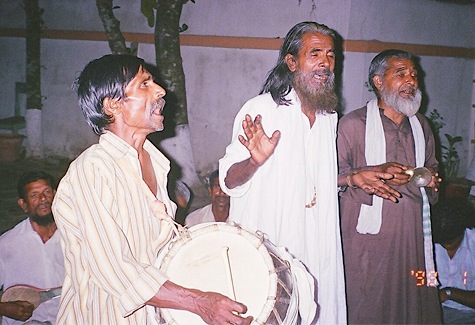
Jainuddin Boyati and team
In her book Jarigan: Muslim Epic Songs of Bangladesh, Mary Frances Dunham writes about how the jari provides entertainment, as well as educates. Dunham, an American, worked with the folk poet Jasimuddin on his Jarigan anthology in the late 1960s when she was staying in Bangladesh. She came back after about twenty years to independently follow up on her work and create a book and audio collection of field recordings out of her research. Her recordings and papers from that time are being archived at Columbia University.
http://findingaids.cul.columbia.edu/ead/nnc-rb/ldpd_10666979/summary.
The jari and other narrative songs return us to our mythologies while reinforcing the place of these stories in our lives. Some myths are interpreted to have local and personal meaning, such as we see at the time of the Durga puja in Bengal, when Durga is invoked both as the slayer of evil as well as the daughter visiting her natal home, soon to return to her husband. Some myths such as the Manasamangal or Bonbibir Pala have immediate relevance for people who live in close proximity with nature; they are thus infused with local ecological and anthropological meaning. Some myths have wider political purpose, such as consolidating communities through the singing of the story of Karbala. Every year Hussain and his clan must die in the Battle of Karbala in order for the community to come together. However, this is only part of the story. Why we need our myths, why we need our occasions to come together in celebration or lamentation cannot be explained with one reason. Just as Durga’s homecoming has political, economic and commercial meanings too, similarly when in jarigan the grief of Fatema is sung, it becomes the grief of every mother; Joynal’s fear is the fear of any child.
Within living traditions, familiarity is a pre-condition for appreciation. And familiarity here means not only knowing the story, but also knowing the form and the protocol of performance. Even as audience you should know when and where you can come in. How to acquire such familiarity? Not just for jari, the question comes up when we are working with other forms too; say with Amulya Kumar’s jhumur which demands a detailed foreknowledge of the Mahabharata. Or baulgan, where you are expected to understand all the play of words and cosmogonic riddles. Here we are talking about the familiarity of the insider in any community, of belonging to a tradition. Standing on the edge of communities and traditions, we often find ourselves asking the question: what is our tradition then?
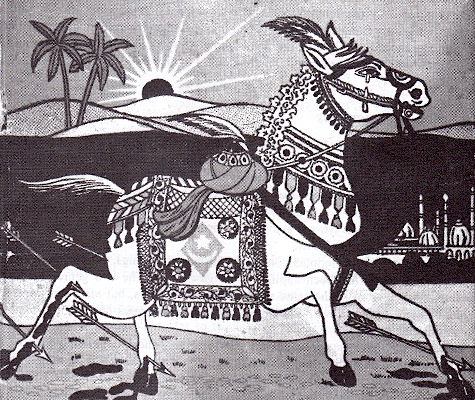
Duldul on the cover of Mir Mosharraf Hosein’s Bishad Sindhu. Image taken from Mary Frances Dunham’s book
Arnold Bake had recorded a group of jari singers from Mymensingh (Maimensingh, according to Bake’s notes) in the east of what is now Bangladesh, at an annual event called Suri mela in Birbhum in the west, on 23 February 1932. This troupe had been brought to perform in Kolkata and Birbhum by the song collector and district adminitrator, Gurusaday Dutta. Jasimuddin, also writes about this performance of the Mymensingh jari singers in Kolkata in the introduction to his anthology of jarigan. According to Jasimuddin, Dutta had also filmed the performance; but where that film might be now, is not known. Could it be that Jasimuddin was referring to Arnold Bake’ footage, because Bake did have a camera with him on that visit and there were films from Kenduli and elsewhere, which can be seen at the British Library and ARCE? So far in our research we have not spotted any Jari film in the Bake collection, however. Jasimuddin’s own collection becomes for us a very useful guide book, allowing us to enter this world of the narrative song through his written text. We need our written records of orality in order to access the world of the oral.
Our location as the outsider-listener has its advantages tool. Questions come to our minds precisely because we do not belong. In our work, through our act of recording we have been trying to understand the social and historical processes that lead to the birth and death of traditions. Why is it that the jari is no longer sung as a living tradition in parts of Bengal like it used to be in the time of Jasumuddin? The jari utsab in Gafforgonj in Mymensing—is that a continuation of the old tradition that Gurusaday Dutta and Arnold Bake had recorded or is it the ‘festivalisation’ of an otherwise ended tradition? The marsiya that the mostly non-Bengali Shia community of Bengal sings in the month of Muharram—does it have any connection with the jari of Bengal?
Writer, teacher and gender studies scholar Epsita Halder has been researching the marsiya tradition of Bengal for some years. She makes her own observation about the differences between jari and marsiya: ‘While ritualistic mourning over the death of Imam Husayn, the grandson of Prophet Muhammad, and his companions in the battle of Karbala entered the domain of folk repertoire in the form of the Jari, it also remained an integral part of the Muharram ritualistic tradition. The performative aspects of Jari include a fluid and undesignated audience, whereas majlis associated with the marsiya tradition is performed in the exclusive and sacred realm of the ritual, to commemorate the martyrs of Karbala in the month of Muharram. The space of ritualistic-performance and the sacred time of performance at the majlises are ritualistically fixed under the parameters of Shi’i religiosity.’ (Private communication with The Traveling Archive. See also Epsita’s essay in Baul Fakir Utsav journal 2013 )
Epsita’s noha video. Shot in Kolkata
The ‘fluidity’ that marks the jari performance can transform the courtyard of Sadek Ali’s house in Uttar Shobharampur into the battlefield of Karbala. Nuru Pagla runs around wildly making up his version of the Hanifar jari. Joynal Joynal, he cries, lamenting the helplessness of the child whose father has died in the Battle of Karbala. Sadek Ali, the well-off trader of Faridpur, is a warm and generous host and householder. His college-going girls, one married daughter, little grandchild and his equally generous wife all sit around the performers on this day of singing in January 2006. But deep inside, Sadek Ali and his wife are crying for their lost son, who lies in his grave in the garden of their house, to our right, shaded by the pomegranate tree. Who is the Joynal in Sadek Ali’s story? Sadek Ali himself, or his son? Who is more helpless? The next day on the Kumar, Sadek Ali sang this same song: একটা পুত্র দে রে আল্লা, একটা পুত্র দে/কামাই খাইবার সাধ নাই, মইলে মাটি দিবে কে? Give a son, Allah, give me my son/ I don’t care for riches in life, but who will bury me when I die? The chorus of listener-performers joined him in lament.
Some day I hope that we will also be able to join this singer-listener community. It must be comforting to have a place or a song to call one’s own.
Sadek Ali had moved to his other house in Ambikapur in 2008, when we went for this recording session. We asked him and our friend Salamot bhai if it would be possible to record a fuller session of jari. They said it was not easy to find jari singers anymore, because jari as a form was slowly fading out from their region. Jarigan flourished during a time of leisure, with feudal patronage. Now the times are changed. However, despite the changing times, a team could still be gathered. Salamot bhai went to the house of Jainuddin Boyati in the Lokkhipur neighbourhood of Faridpur and Jainuddin Boyati in turn got together his brothers Halim, Mofajjal and Alim; Adom was another relative. Mofajjal, who had a piercing voice, also played the dhol. Adom and Samir Kumar Saha played the flute, Mukul Kumar Shil played the harmonium. They sang almost the whole of the Shahidnamar jari. You could hear strains of other musics in their song, suggesting musical journeys and interweave of forms—of the panchali, kirtan and bhatiyali. It was getting late in Sadek Ali’s courtyard. When they finished they said, now only Yazid remains to die. বাকি রইল এজিদের মৃত্যু।
Written in May, 2014
Related links:
Jarigan in Sunamganj. Note similarity with Manasar gaan.
http://www.youtube.com/watch?v=Q-gQ6u0ceWY#t=100
Jasim criticism of Abbasuddin
https://web.archive.org/web/20150317233959/http://banglamusic.com/reviews/jasimuddins-criticism-of-abbasuddin-3.html
Jasimuddin and Alan Lomax
http://sos-arsenic.net/lovingbengal/news.html#30
The ‘western’ tradition of singing Marsiya, very different from the tradition of jari
https://www.youtube.com/watch?v=Zcm-QB922aE
এই রেকর্ডিং সেশন ২০০৮ সালের। গোঁসাই দাসের সঙ্গে আমাদের আলাপ অবশ্য আরো পুরোন।
২০০৬-এর ফেব্রুয়ারীর এক সন্ধ্যায়, আমাদের ফরিদপুরের দুই বন্ধু, সাঈদ আর সঞ্জয় মিলে ভাঙ্গা থেকে আমাদের নিয়ে গেলেন ফুলসতি গ্রামে। সেখানে সাঈদের নানার বাড়ি। সেই সূত্রে সাঈদ ফুলসতির শিল্পীদের খবর এনেছিলেন। কি গান রেকর্ড করতে যাচ্ছি সে সম্পর্কে বিশেষ কিছু জানতাম না আমরা। গ্রামে গিয়ে দেখি রইরই কান্ড। লাল পাড়-সাদা শাড়িতে সজ্জিত মেয়েরা একটি ক্লাবঘরের বারান্দায় সারি সারি দাঁড়িয়ে। তাদের হাতে ফুলের ডালা। আমরা পৌঁছতেই কারা যেন মৌসুমীকে, ‘দিদি আসুন আসুন’ করতে করতে ঘিরে ফেলল আর মেয়েরা, হতভম্ব আমাদের দিকে রাশি রাশি গাঁদা ফুলের পাপড়ি ছুঁড়তে থাকল। শাঁখ-টাঁখও বেজে থাকতে পারে, ঠিক মনে পড়ছে না এখন! আমার হতভম্ব ভাবটা কাটতে ৩০ সেকেণ্ড লেগেছিল মনে হয়। তার মধ্যেই জনতা মৌসুমীকে ঘিরে ফেলে ক্লাবঘরের দিকে নিয়ে চলেছে দেখতে পেলাম। ভিড়ের মধ্যে হলুদ ফুলের পাপড়ি ঢাকা মৌসুমীর মাথা ভেসে চলেছে দেখতে দেখতে আমিও হাঁটা দিলাম সেদিকে।
সাঈদ সম্ভবত এতটা আশা করেননি। প্রাথমিক উচ্ছ্বাস কিছুটা কমতে, সাঈদকে দেখলাম প্রাণপণে লোকজনকে বোঝাবার চেষ্টা করছেন আমাদের এখানে আসার উদ্দেশ্য। এই অভূতপূর্ব আয়োজন যিনি করেছিলেন, তিনি কোন রাজনৈতিক দলের এই অঞ্চলের নেতা এবং নির্বাচিত জনপ্রতিনিধি। ধীরে ধীরে বুঝলাম এই সভায় তিনিই সব। তিনিই আয়োজক, তিনিই বক্তা, তিনিই শিল্পী– এক দেহে যতকিছু হওয়া সম্ভব, কেবল শ্রোতা ছাড়া, সবই এ’ সন্ধ্যায় তিনি। নিজের অজস্র কথা ও বেশ কয়েকখানি গানের পর যখন তাঁর পছন্দের অন্য দু’একজন গায়ক সুযোগ পেলেন, আমরা ততক্ষণে হাল ছেড়ে দিয়েছি। সাঈদ বেচারা অপ্রস্তুত।
আসরে নানারকম গান হয়ে চলেছে। কর্তার নির্দেশে একে একে গায়কেরা, হারমনিয়াম, তবলা, করতাল সহযোগে, যাঁর যা জানা ছিল উজাড় করে দিচ্ছেন আমাদের সামনে। অনেকেরই গলায় চমৎকার মেঠো ভাবটি আছে। দু’একজন সুন্দর গাইলেনও। কিন্তু বেশিরভাগেরই গানে মনে রাখার মত নিজস্বতা প্রায় নেই। রেডিওর ‘পল্লীগীতি’ অনুষ্ঠান শুনছি মনে হয়। একের পর এক গান হয়ে চলেছে, কিন্তু সবই একরকম। ‘পল্লীগীতি’ শব্দটা ব্যবহার করলাম কারণ রেডিওর সেই একঘেয়ে ‘করতে হবে বলে করা’-টাইপের অনুষ্ঠানের সঙ্গে শব্দটা প্রায় সমার্থক হয়ে গেছে এতদিনে। পল্লীগীতির অনুষ্ঠান মানে দূরদর্শনেও যেমন অবধারিত মাটির দাওয়া, খড়ের চাল আর মেঝেতে আলপনার সেই চিরাচরিত সেট; অথবা ব্যাকড্রপে রাঙামাটির পথ, বাঁকা নদী ও তালগাছ, আর তার সামনে পাটভাঙা পাজামা-পাঞ্জাবি বা শাড়ি পরে, ভয়াবহ উচ্চারণে, তথাকথিত ‘গ্রাম্য ভাষায়’ উচ্চকন্ঠে গান। রেডিওতে অন্তত এই দৃশ্যগত বিভীষিকাটা নেই। তবে ‘গ্রাম্য ভাষার’ বিভীষিকা সমানভাবে বর্তমান।
যে কোন বিষয়কে স্টিরিওটাইপে বেঁধে ফেলার সুবিধে হল, আপনি কতকগুলি boundary condition পেয়ে গেলেন। অঙ্ক কষার সুবিধের জন্য যেমন hypothetical condition হয়– x tends to zero বলে পাতাখানেক আঁক কষে ফেললেন; x tends to infinity বলে আরো পাতাখানেক! তবে তার পিছনে বৈজ্ঞানিক যুক্তি থাকে। শিল্পে তো আবার ওসব নিষিদ্ধ। সবই হৃদয়ের কারবার। সুতরাং ভাষা tends to গ্রাম্য হলে খাতাভর্তি repertoire নামিয়ে দেওয়া তো স্রেফ জলভাত। এক অনুষ্ঠানে গোটা বঙ্গদেশ তার বৈচিত্রের ডালি নিয়ে আপনার সামনে দণ্ডায়মান!
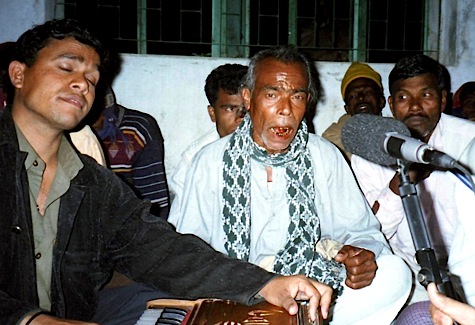
Gosai Das, Fulsati Session, Feb 2006
যাকগে, ফুলসতিতে ফিরি। আমরা সেই অপ্রতিরোধ্য সঙ্গীত-প্রবাহে যখন হাবুডুবু খাচ্ছি, ক্যাপ্টেন ও তাঁর দলবলের ভান্ডার প্রায় উজাড়, এমন সময় নেতা মহোদয় একজনকে ডাকলেন, যাঁকে আমরা এতক্ষণ লক্ষই করি নি। ঘরের কোণে কোথাও বসে ছিলেন শীর্ণকায়, পানের কষে ঠোঁট লাল, গলায় মাফলার ও গায়ে মলিন চাদর জড়ানো পলিতকেশ সেই বৃদ্ধ। নেতা বললেন, ‘আমাদের গান তো শুনলেন, এবার এই বুড়ো মানুষের একটা গান শুনুন’। আমি তো মাইক বাগিয়ে রেডি হলাম। যদিও আশা-ভরসা তেমন ছিল না।
কিন্তু সেই বৃদ্ধ প্রথম সুরটি লাগানো মাত্র আমরা সব নড়েচড়ে বসলাম।
Rugged, পোড় খাওয়া কন্ঠস্বর আর তেমনি ভাব! এতোক্ষণের এলোমেলো আসর নিমেষে জমাট বেঁধে গেল।
বৃদ্ধ গাইছিলেন, ‘আমার নিদান কালে, তোমার দেখা পাব…’। কীর্তনের ঢঙে গাওয়া, সঙ্গে ধুয়ো ধরছিলেন কেউ কেউ। দেখলাম গানটা অনেকেই জানেন। একটা নতুন ব্যাপারও লক্ষ করলাম। গানের একটা নতুন লাইন শুরুর ঠিক মুখে সেই লাইনের প্রথম শব্দটি বলে উঠছেন কেউ একজন। শুনলে মনে হবে, ভুলে যাওয়া গানের কথা ধরিয়ে দিচ্ছেন বুঝি। পরবর্তীকালে এই গায়কীর সঙ্গে আরো পরিচয়ের পর বুঝেছিলাম তা নয়, এটা গায়নরীতি। এখন যদিও লিখছি লক্ষ করেছিলাম, কিন্তু সেই মুহুর্তে এতসব লক্ষ করার মত অবস্থা আমাদের ছিল না। তৃষ্ণার্ত মানুষের কাছে শীতল জলের মত সেই গানে আমরা ভেসে গেছিলাম। আর কীর্তনের সেই টিপিক্যাল চলন– আহা, কখনো খোল-করতাল-ধুয়ো সহযোগে তুঙ্গে ওঠে, আবার ধীর লয়ে ফিরে যায় দুলকি চালে। গান কতক্ষণ চলেছিল মনে নেই (এখন রেকর্ডিং-এ দেখছি ১৫ মিনিটের মত), যখন শেষ হল, আমাদের সকলের চোখের কোণ চিকচিক করছে। সবচেয়ে আনন্দ বোধহয় হয়েছিল সাঈদের। বৃদ্ধ ওঁকে লজ্জার অতল থেকে টেনে তুলে, সোজা গর্ব আর আনন্দের আকাশে ভাসিয়ে দিয়েছিলেন। গান শেষে সাঈদ সোজা ডাইভ দিলেন শীর্ণকায় বৃদ্ধের উপর।
প্রাথমিক উচ্ছ্বাস কিছুটা থিতোলে আমরা ওনার পরিচয় পেলাম। নাম, গোঁসাই দাস। নিবাস, বাওতিপাড়া, ফুলসতির ঠিক পাশের গ্রাম। এই অঞ্চলের বিখ্যাত স্বভাবকবি, সাধক বাণীকান্ত দাসের বংশের মানুষ, সম্পর্কে তাঁর নাতি। গোঁসাই যে পদটি গেয়েছিলেন, সেটি বাণীকান্তেরই। ওঁদের উচ্চারণে ‘বাণীকান্থ’!
বাণীকান্তের গান এই অঞ্চলের মানুষের নিত্যসঙ্গী। সকলেই যে গোঁসাইএর সঙ্গে গলা মেলাচ্ছিলেন কি করে, সেটা আমরা এখন বুঝতে পারলাম।
বাণীকান্ত সম্পর্কে জানা যায় যে তিনি উচ্চমার্গের সাধক ও প্রতিভাবান স্বভাবকবি ছিলেন। মাঠে লাঙল চালাতে চালাতে গান বেঁধে ফেলতেন। সাধনতত্ত্বের গানের লাগসই পাল্টা জবাব তৈরি করতেন নিমেষে। বাওতিপাড়ার বিমল দাসের কথায়, ওঁর জবাবি গানে চমৎকৃত হয়ে, ‘ইংরাজ সরকার বাহাদুর’ নাকি বাণীকান্তকে বলেছিলেন, ‘থ্যাঙ্ক ইউ বাংলা কবি’!
আসর সেদিনের মত শেষ হল। নেতা সাহেব আমাদের জন্য কিঞ্চিৎ জলযোগের আয়োজন করেছিলেন। ওঁদের সহৃদয় আতিথেয়তায় জলযোগ যদিও আর কিঞ্চিৎ রইল না। সারি দিয়ে বসে আকন্ঠ উৎকৃষ্ট চালের পিঠে খেয়ে যখন ফরিদপুরের উদ্দেশ্যে রওনা দিলাম, তখন বেশ রাত। মিহি কুয়াশার চাদরে আশপাশ ঢাকা।
যেতে যেতেই আমরা ঠিক করে ফেললাম যে এই গোঁসাইকে ভালো করে রেকর্ড করতেই হবে। ঠিক হল, কাউকে কিছু না বলে, পরেরদিন আমরা সোজা বাওতিপাড়া গ্রামে হাজির হব। তারপর যা থাকে কপালে।
পরদিন যখন গোঁসাইএর বাড়ি পৌঁছলাম আমরা তখন সন্ধ্যা হব হব। বাংলার আর পাঁচটা দরিদ্র গ্রামের সঙ্গে বাওতিপাড়ারও বিশেষ তফাত নেই। কাঁচা মাটির রাস্তা, ডোবা আর ইতস্তত ঝোপঝাড়ের মধ্যে ছোট ছোট বাড়ি। অধিকাংশেরই খড়ের চাল, ছিটে বেড়া, সামনে ছোট্ট উঠোন। এমনই এক উঠোনে পাটি বিছিয়ে আমাদের বসার আয়োজন হল। গোঁসাইএর পরিবারের আরো লোকজন আশেপাশেই থাকেন। আমাদের দেখতে উঠোনে বেশ ভালই লোকজন জড়ো হল। গ্রামের মেয়ে-বৌরাও গাইলেন আমাদের অনুরোধে।
সেই রেকর্ডিংও রয়েছে এখানে।
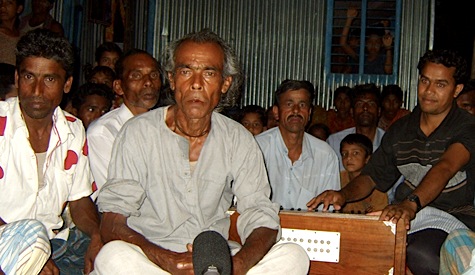
Gosai Das, Baotipara Session, 2008. Nepal Das on harmonium.
যাঁর বাড়ির উঠোনে আয়োজন হয়েছিল, সেই বৃদ্ধ বাণীকান্তের ছেলে। তিনি নিজে গান করেন না। তবে আমাদের পেয়ে একেবারে অভিভূত হয়ে পড়েছিলেন। ওঁদের নিস্তরঙ্গ জীবনে বেশ একটা আলোড়ন তুলে আমরা হাজির হয়েছিলাম। গ্রামে-গঞ্জে আলোড়ন যেটুকু হয়, সেগুলি অধিকাংশ সময়েই রাজনৈতিক; গান শুনতে বা রেকর্ড করতে ‘ইন্ডিয়া’ থেকে আর কটা লোক যায়। সুতরাং ওঁদের জন্য ব্যাপারটা বেশ নতুন ধরনের ছিল নিশ্চয়ই।
একটা বিষয় অবশ্য বারেবারেই লক্ষ করেছি যে বাংলাদেশের হিন্দু অধ্যুষিত এলাকায় গেলেই ওঁরা আমাদের নিজেদের গোষ্ঠীর লোক, পরমাত্মীয় মনে করেন। এটা হয়ত সর্বত্রই সংখ্যালঘু মানুষের একটা প্রবণতা। কিন্তু নিজেদের একটা বৃহত্তর সমাজের অংশ কল্পনা করে ক্ষণিক আরাম আর ক্ষণস্থায়ী স্বস্তির এই বাতাবরণ তৈরীর পিছনে, দেশ-কাল নির্বিশেষে দীর্ঘ রাজনৈতিক ও সামাজিক শোষণের ইতিহাসকে তো অস্বীকার করা চলে না। মানুষের উপর মানুষের নিপীড়নের মানসিকতার বীজ সর্বত্র ছড়ানো। কোথাও তা রাষ্ট্রের মদতে পল্লবিত হয়ে শাখা-প্রশাখা বিস্তার করছে, কোথাও হয়ত তা এত প্রকাশ্য নয়। আর আমাদের ইতিহাস তো সরাসরি ধর্মকে শিখণ্ডী করে রাজনৈতিক ক্ষমতা দখল ও ভাগাভাগির ইতিহাস।
পরে মৌসুমীর কাছে শুনেছি, ঘরের ভিতরে ওকে ডেকে নিয়ে গিয়ে সেই বৃদ্ধ, বাণীকান্তের ছেলে, অঝোরে কেঁদেছেন আর বলেছেন এ’ দেশ ছেড়ে চলে যাবেন ইন্ডিয়ায়। বাইরে তখন গোঁসাই, বিমল, নেপাল ও আরো অনেকে গাইছেন কৃষ্ণের অভিমান, ‘আমি চলিলাম রাই ব্রজ ছেড়ে, আর তো আসব না… আমি দেশের মানুষ দেশে যাব, এই দেশেতে আর থাকব না’। কত ব্যথায় মানুষকে আজন্মের চেনা মাটি, চেনা ঘর, চেনা মানুষ ছেড়ে চলে যাবার কথা ভাবতে হয়, তার আর আমি কি বুঝব।
এই লেখা যখন লিখছি, তার ঠিক দু’সপ্তাহের মধ্যে ঠিক হয়ে যাবে আগামী পাঁচ বছর ভারতবর্ষের শাসন কাদের হাতে যাবে। ভোট শুরুর আগে থেকেই প্রধানমন্ত্রী পদপ্রার্থীর আস্ফালনে দেশের আকাশ বাতাস মুখর। সম্প্রতি কাগজে দেখলাম, তিনি ‘বাংলাদেশী অনুপ্রবেশকারীদের’ বাক্স-প্যাঁটরা গুছিয়ে প্রস্তুত থাকতে বলেছেন। ১৬ মে ভোটের ফলাফল বেরোবার পরেই নাকি তাঁদের দেশ ছাড়তে হবে!
এবারে কোন দেশের মানুষ কোন দেশে যাবে কে জানে!
মে, ২০১৪
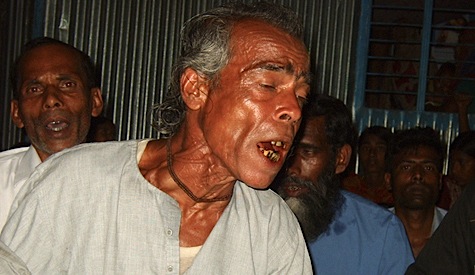
Gosai in Baotipara Session, 2008.
This was the third time we were meeting Gosai Das. Sukanta has written about the first two encounters; about how we met on 20 January 2006 in Fulsati village and how that meeting was filled with the thrill of discovery. The second meeting the very next day was in Gosai Das’ native village, Baotipara, next to Fulsati. His song of the previous evening, in a mixed bag of performances by various performers, had left us asking for more so we went back to quench our thirst. Then the third session, two years later, from which this song here comes.
‘I am walking in search of songs of biraha across a map made up of disjointed pieces of land and water . . . On the wayside are scattered moments of love, loss and longing, which I pick up as I pass them by. It is these moments which I believe make a song, not just the words and musical structure or the idea or message a song tries to express. Besides, it is in both the singing and listening that a song gets made; in the moment and place of utterance and in the person who utters the song.
‘I felt this very strongly the night we went to Baotipara village in Faridpur district of Bangladesh to record songs of the twentieth century bhakta-poet Banikanta, sung by members of his family and the community.‘ This is an extract from my essay ‘Madly in Love: On the trail of songs of separation’ in Poetics and Politics of Bhakti and Sufism in South Asia, a book edited by Kavita Panjabi (New Delhi: Orient Blackswan, 2011).
If Baotipara was a place in one of those countries known for their detailed methods of recording, documenting and preserving the past for posterity and building archives and museums; where they put up plaques for people and remember them for their deeds; if Baotipara was in such a part of the world, then people would know its name for the works of an unlettered man who lived in the early part of the twentieth century and composed songs as naturally as he talked. His name was Banikanta Das. Early twentieth century, so they might even have had a short film or a recording of his voice: Amar naam Banikanta Das!
It is said that Banikanta talked in songs. However, there is no ‘record’ of such details in this un-archived world, except in Baotipara’s collective memory. It is said the folk poet and folklorist Jasimuddin used to visit Banikanta and write down his songs. However, when they were compiled in anthologies edited by Jasimuddin—some born cynics claim—Banikanta’s signature or bhonita was erased from some of the songs (in this system of song’writing’—rather, songmaking—there is usually a verse with the poet’s name). It is difficult to prove or disprove such claims, especially because in an oral culture, there are expressions and idioms which belong to the collective; and to Time, as it were, even though the work might be ascribed to an individual poet/composer.
How then does a place like Baotipara keep record of its time and events? Though unknown to the wider world, places like Baotipara and Fulsati still know Banikanta as their living history. Myths around meetings of the neighbouring town’s ‘folk’ poet with the village’s mystic poet are still retold. ‘Kobishaab’ Jasimuddin is both revered and criticised. Banikanta’s songs are still sung. For how many more generations this will continue, it is hard to say.
In a sense, we are working at a moment of overlap, when the oral tradition of recording and transmitting knowledge in a place like Baotipara is still alive, while we are ‘recording’ with the machine, for our sakes as well as the future. In many parts of the world this process of transition is over, but in our part of the world multiple times coexist. There are ways and ways of recording. This recording was made in 2008 and I am writing this note in 2014. Now most people own mobile phones which can record almost anything which happens to our lives and around us, in audio and video format. Will this technology also bring about the demise of traditions? There are other questions too, mainly of our sub-continent’s politics. Some day Baotipara might become a different world, demographically changed and culturally transformed. Then, while the television might be dishing out global soaps for local consumption on a late spring night, there could be a new rhyme to teach to the children of our children or grandchildren:
This is the place where Gosai Das sang
This is the place where Gosai Das sang on a late spring night in 2006;
This is the song that Banikanta made that Gosai Das sang on a late spring night in 2006;
This is the poet who went to meet the poet who talked in songs and riddles that Gosai Das sang on a late spring night in 2006. . .
Written in May 2014.
Related link:
http://www.thebookreviewindia.org/articles/archives-1032/2012/september/9/of-syncretic-traditions.html
We are often asked about how we choose our field, establish contact and make our field recordings. Do we know the artist from before? Is the artist well known in his/her region or established in the genre? What are we looking for when we go to an artist? There is no one answer to these questions because there is no single method to follow, no fixed plan of action. Things happen. Sometimes we go for a particular thing or person, sometimes it is a matter of chance. Out of all the field recording sessions we have had, Habib stands out as one of those rare sounds that you chance upon; he just happened. This was on our third visit to Faridpur.
Now the place was becoming familiar to us, and our friendships had started to get deeper. We were talking with Salamot bhai about the rare, immersed singer. He said, there is such a man whom I know, he drives a rickshaw and late at night when he goes home, he sings to himself. লোকে বলে, ওই যে হবি যায়। He is quite crazy. His name is Habib; people call him Hobi Pagla. If you are lucky you might meet him. Sometimes he comes to my house at night, but there is no knowing when he will come. He also comes to Shambhunath’s tea shop to hang out; smokes, then helps with the dishes, puts the kettle on, serves tea. Then if he likes, he might also sing a song.
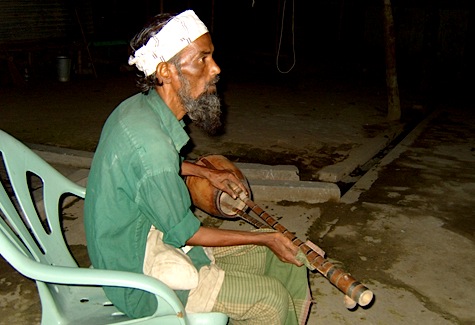
Habib Pagla. A recording session in Sadek Ali’s house, Ambikapur, Faridpur
We were at Shambhunath’s. Salamot bhai asked, হবি আসছিল নাকি? That night Habib actually turned up. Salamot bhai asked him to sing and he sat for a while in contemplation and slowly began to let the song flow out of his body. As the song grew, so grew Habib, beating on the table, his breath rising and falling with the rhythm of the song. Structurally, his song was like the rhythmic prayer or zikr and indeed the song was about this Sufi devotional act of repeatedly pronouncing the name of god.
Open the doors of your heart
See with the light of your eyes
Breathe in, sing la ilaha
Breathe out, sing ila-llah
In the years following this meeting, we have looked out for Habib every time that we have been to Faridpur. We have mostly managed to meet him. Slowly we have realised that Salamot bhai and Habib share a very special bond—Habib calls him abba or father, and deeply respects him; as much as he can, in his own mad way. Such as, he will wait for Salamot bhai to finish his day’s work and adda at Shambhunath’s or Faridpur Press Club, and then take him home in his rickshaw.
Habib has sung this same song again and again at almost every recording session that we have had with him. He seems to carry the song within, like the name of Allah. Tame your desires, open your heart, and sing the name of god. Breathe in, breathe out. While writing this note I called Salamat bhai to ask about the composer, Tinuchand; also to ask the meaning of some of the words. Tinuchand is a composer from the Nadia region; now the place falls in India. He pre-dates Lalon Fokir. And the name is not Tinu, most probably it is Dinu, Salamot bhai said. What is sohi? It is not sohi, the word is sofi; means image. The image of god. Picture god in your mind and then utter the name: la ilaha ila-llah, la ilaha ila-llah. . . . There is no need for doing sizda (sajda) after sizda, no need for touching your head to the ground again and again, if you carry the name and image of god within. Those are the words.
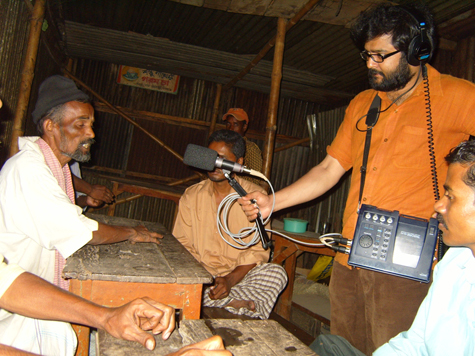
A recording session with Habib in Shambhunath’s tea shop, Faridpur.
খোল রে মন তোর দেল-এর কপাট
ও দিব্যু নয়ন যাবে রে খুলে
লা ইল্লাহ দম বলে, ডাকো ইলাল্লাহ দম বলে
কলেমা তোর আলেক রতন
জপো ওই নাম হরদমের দম
নাফসোকে করিয়া দমন
মায়া দাও গা ছেড়ে
ও দেহের খুলবে চৌদ্দ তালা
দেখবি কত খেলা গো
বেহেস্তে নেবে ডেকে রে তোরে
লা ইল্লাহ দম বলে, ডাকো ইলাল্লাহ দম বলে
ওগো আগে করো সোহি রে সেজদা
পিছে তূমার আছে রে খুদা
মিছা কেনে ডলছো রে কাদা,
মরছো রে কপাল ডলে
ও তোর সেজদার পরে সেজদা
তাতে নাই কা ফয়দা গো
ও দীন তিনু চান্দে রে বলে
লা ইল্লাহ দম বলে, ডাকো ইলাল্লাহ দম বলে
Open the doors of your heart
See with the light of your eyes
Breathe in, sing la ilaha
Breathe out, sing ila-llah
Once Habib declared he would now follow the straight and narrow path. His grown-up son disapproves of his ways. So he has asked him to give up work, not smoke and live properly; do sizda and say his five prayers, and stay at home. So he had given away his rickshaw, he claimed. Perhaps next time he would not come to Shambhunath’s anymore. That was worrying. Habib without the song would be a bird whose wings had been clipped.
Wasn’t so easy to tame Habib though, because he had to go back both to his rickshaw and his songs. However, the last time we met Habib was in January 2013, he seemed more distracted than usual. His daughter was in hospital for a surgery. Habib was singing, but his mind was not quite in the song. More than the kalimah, more than the name of his god, it was finally coming down to these universal bonds of love. How to tame this heart? How to free it?
–Written in May 2014.
Shalla, a region in Sunamganj district of Sylhet, about 100 km south-west of Sylhet town. We went there by boat with Ambarish Dutta and some local friends and it took us the whole day to reach this village called Sadhusree under Shalla police station. The story of this recording session is long and complicated, but what we understood the next morning, having recorded the most wonderful music of the village people through the night, was that the people were finding it too hard to keep their lives going and hence the music was on the verge of fading away. The place remains waterlogged for nearly six months every year (it is what they call the haaor region; haaor having come from the Bengali word sagar or ocean, or sayar meaning lake). The people live in extreme poverty. There have also been political threats because this is a mostly Hindu village and if not threat, then there surely is a sense of insecurity. Hence, people who have found work elsewhere have preferred to leave, even move across the border to India or go further to more distant lands.
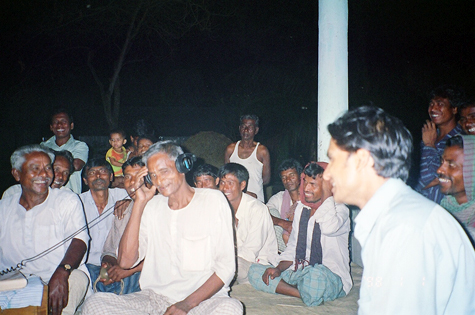
Checking out the recording
This music has never been recorded before–the forms hurigaan, probhaati, tin-nather gaan and so on, part of a tradition that has been handed down the generations. In fact, it is an extremely well-orchestrated and choreographed performance that we saw in Sadhusree, which was led by Birendranath Das and in which most male members of the community took part. It seems that during such music sessions, while the men come out and sing, the women hear the music from inside their homes and join in while carrying on with their chores, The whole recording session was so dynamic that we were missing the camera.
Our main contact in this village was Dharani Das, a young man whom Ambarishda knew through work. He is one of the gentlest musicians we have met so far and this gentleness is reflected in his style of singing. Here he sings a composition of Radharaman Dutta, the bhakti poet of Sylhet.
Written in 2011.
We met Farijuddin in the second phase of our IFA-supported project, when we had started to return to the field for purposes of dissemination. Pradip Kumar Pal, our friend and guide in Silchar, organised a session of music in his home. He is a baker by trade, but also an amateur sound recordist (he considers Sukanta his guru in the business) and he has set up a recording studio in his house to record, among other people, rare artists and forms of the Cachar region. He himself is pretty knowledegable about many of these forms and can beautifully sing samples song . Farijuddin is one of Pradip Pal’s favourite singers.
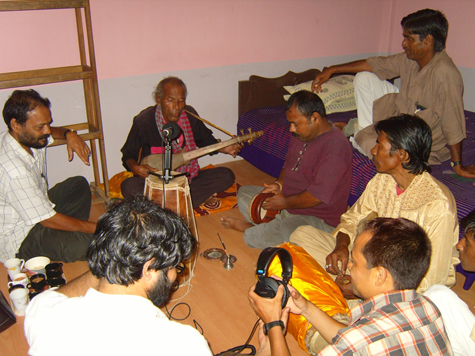
Farijuddin singing, recording session at Pradip Pal’s place
Farijuddin plays the soraj (a version of the dotara with resonance strings) with a unique style. The sound of his instrument brings to mind Dhirajuddin Fakir in the opening sequence of Ghatak’s Titash Ekti Nodir Naam, it is a rare sound which we have not had from any other place.
Here is an article in Bangla by Pradip Pal about Farijuddin published in a local newspaper of Silchar.
Written in 2011.
In 2003, when we had just about begun to make our field recordings, one of our first trips was to Saptiguri village in Sahabad tea garden in North Bengal, 38 km west of Siliguri town. We went following the beautiful, recorded voice of Nirmala Roy, a singer of bhaoaiya, to listen to her live and make our own recording of her songs. In those early days we were trying to listen to/for expressions and interpretations of biraho (longing for union while being in a state of separation) in the folk music of Bengal. As we travelled, and listened, and as time went by, we began to see that categories such as ‘Bengal’ and ‘folk’ could be both limited and limitless; it all depended on the perspective of the traveller and the listener.
We went back to Nirmala and Chandkishore Roy’s house four years after our first visit, in 2007. Our work was evolving from being an exploration of expressions and interpretations of love, loss and longing in the folk music of Bengal to becoming a shared space of telling and listening. Hence we wanted to share with Nirmala and Chandkishore Roy and their family and friends our recordings of their songs and other recordings from the years in between. We had to tell them about things we had heard, connections we had made, while also ask new questions which had arisen in our minds in the course of our work. And those questions were critical to this return.
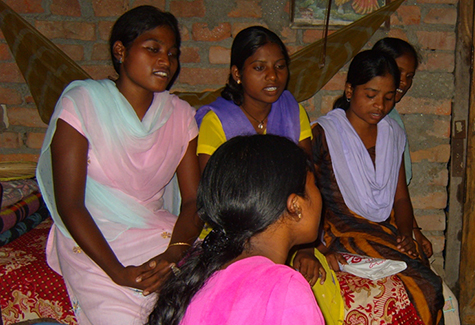
Sova, Deunishia, Prishka, Miristilla, and Aruna
North Bengal is a vast expanse of ‘bhaoaiya land’; bhaoaiya is the form, with its sub-regional variations, which is predominantly heard in the foothills of Darjeeling, in Coochbehar and across the Bangladesh border in Rangpur. In the songs of Goalpara in Assam too we hear its traces. Then if we think of the centuries-old history of labour and industry of this region, especially the history of the tea gardens, then we remember that there is more to the region than bhaoaiya. People also sing and talk in many other languages here. There is a history of that sound and a history in that sound. Labourers who had been brought in from western West Bengal, present day state of Jharkhand, Bihar, Orissa and Madhya Pradesh–mainly Oraons or the Mundas—they all had their own songs and dances and rituals, ranging from old harvest songs of ‘karom’ to later church hymns. In 2004, when we had recorded in a tea garden in Srimangal near Sylhet, it felt as though the singers were singing songs from another time and place. As if, following those songlines, we could return with them to an ancestral land whose name even they did not know.
This recording of these five Oraon girls was made in the house of Nirmala and Chandkishore Roy. In fact, when we were discussing the state of the tea gardens, the sickness in the industry, labourers’ songs and so on, then they sent out one of their boys to go and fetch the girls. They all lived in Sahabad tea estate. This really was a preliminary recording we made, a kind of recce, at the end of which we told the girls, that we would go back again, and meet their elders and listen to more songs and stories. Ten years have passed since, and we have not gone back to Saptiguri. And, if we do now, we will probably find things quite changed in the personal lives of the singers. The giggling Sova Minjh and Deunishia Tirki and Prishka Kindo, Miristilla Tirki and Aruna Panna might all be married and with children now, they might no longer live in Sahabad. On the 17 June 2007, they sang because they were asked to sing—they had no preparation and were quite self-conscious in the presence of us outsiders and our microphone, hence nudging each other and trying to hide behind one another. Yet when they began to sing, you could hear how naturally they sang in unison. There is something utterly communal about this singing. And that to us is the beauty of this music.
A song from this session has also been part of an LP on our work, released by Seattle-based Sublime Frequencies, in 2014.
http://www.sublimefrequencies.com/products/576384-the-travelling-archive-folk-music-from-bengal
–Written in June 2017. Revised March 2023
This was our second recording session with the well-known Sylheti singer Helal Miah, in his Limehouse council flat in East London. Ahmed Moyez had taken us to Helal. First we met in Moyez’s Surma News office, then went to this Limehouse flat on 3 March 2007. There was Helal and his friend Ahmed Ali, the dhol player, and other friends. Helal is a second generation immigrant from Sylhet; he speaks Cockney and Sylheti, but sings in such a way that you feel as though ‘desh’ (homeland) resides in his voice. Moyez had said this—দেশের টানটা আছে তার গলায়। There was a gathering of various generations of immigrants in Helal’s flat that day; they all loved his singing.
Helal got famous after he recorded the Shah Abdul Korim song ‘Maya lagaise’ for Habib Wahid’s album, Maya (2004). The other singer on that album was Kaya, a restaurateur of East London, whom Habib had found when he wanted to record his first album Krishno (2003), a super hit in East Londoni circles and back in Bangladesh too, in which he fused traditional Bengali folk songs with techno and urban beats, electronic, hip hop, rap and reggae. While Kaya became a singer for Habib’s albums, Helal had music running through his veins.
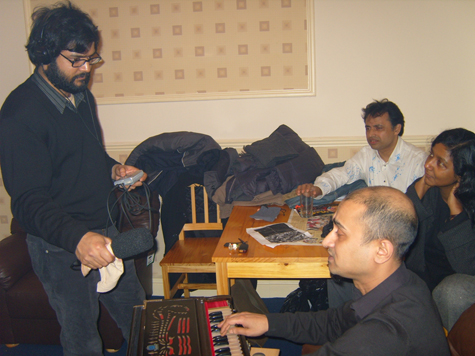
Recording Helal Miah
Helal works in the social work sector and in 2014 he is Executive Director of an organisation called The Consortium of Bengali Associations with his office on Hanbury Street, East London. I am not sure what exactly they do, but I suppose they organise events for and within the community. Each time I see Helal he says the same thing: Didi, we must do something together next time you come. You, Olly, us, Moyezbhai. You remember Ahmed Ali? Then he will pick up his phone and call Ahmed Ali and say, Hello Bhai, See who is on the line. মাতইন তান লগে। And then he will pass the phone to me.
Helal and his friends have a meeting place on Commercial Street, E1. Those three rooms are many things packed into one. Officially called the Oxford College of Sufism, it is a pool club as well as a kind of mazar or shrine where our local sufis hold their own sama sessions. We have met in this pool club-cum college of sufism—Olly (Oliver Weeks), Helal, Ahmed Ali, me, Miti (Arifa Hafiz, an East London based educator and jazz singer)—in different combinations—but ended up not doing any music, only making plans and finally going to Lahore for kebabs. In that pool club, they have a pool table of course, but also a mound of wax in one corner of a darkish room, grown from all the candles that have been lit over the years while the men sang of love, loss and longing and incense sticks burned. It is here that this lawyer friend of Helal’s explained to me the difference between Sylhet and London—I went to my desh, my country, and after a few days I felt homesick. That is my desh, this is my home. That is where I long to go, here is where I long to come back.
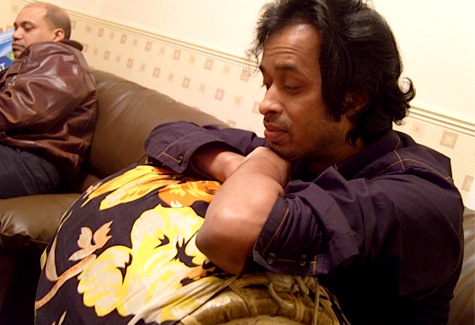
Ahmed Ali
The song from this recording session which we have uploaded is a composition of Kajol Dewan, son of the great rebel poet of Manikganj, Mataal Rajjak. (A small aside: once Kajol Dewan had got embroiled in some civil case and left Bangladesh to come and take temporary refuge in London). This song by Helal is a Bangla qawwali which means it is a form of song which is much travelled any way. It comes from lands west of the subcontinent and arrives in this eastern end as a melody and form and as a stream of stories. The song gets made in Bangladesh, then travels out, crossing the border into India; also crossing oceans to come to London. Boundaries of ‘desh’ are fluid in the making or transmission of such music. This is a song of praise to the Sufi saint Khwaja Moinuddin Chishti, who came to India and settled in Ajmer (where his shrine stands now) and preached the path of devotion through sama, evoking divine presence through song and listening to music. Helal had sung this song on the first day too, so on the second day I was humming the refrain with him.
On 3 March 2007, we had had this conversation.
Helal: I used to hear these songs around me. From my father when I was growing up.
Moushumi: আপনার আব্বাও গান করতেন?
Moyez: ওর আব্বা তো গানের মানুষ।
Moushumi: কী নাম?
Moyez: কুদ্দুস আলী।
Moushumi: এমনিতে কী করতেন?
Helal: He had a job. He worked for Dunlop company. ওই যে tyre আছে না?
Moushumi: কত সালে আসছিলেন?
Helal: উনি আসছেন 1968-69. Sorry, 64-65. He was quite young when he came.
Moushumi: And you, your brothers and sisters, everyone was born here?’
H: Yeah, everyone was born here,
M: And none of your siblings do music? It’s only you?
H: It’s just me, unfortunately.
Unfortunately! Everyone laughs.
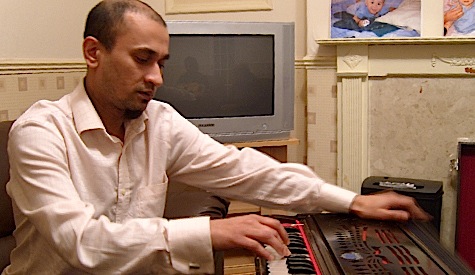
Helal
Helal: তাহলে শুরু করি মায়া গানটা দিয়া?
Ahmed Ali plays the dhol.
বন্দে মায়া লাগাইছে
পিরিতি শিখাইছে
কী যাদু করিয়া বন্দে
মায়া লাগাইছে. . .
Moushumi: কী সুন্দর!
Moyez: গান হোক। গান হোক। বন্ধ হয় নাকি?
H: নতুন একটা গাইতেছি।
Moyez: কার?
H: শামসুর। তুমি কি জানো না আমার কী সুখে দিন যায়।
Moushumi: There is so much emotion in your singing. And it sounds so pure although you’ve lived here all your life. So you really think. . .so it’s possible for you to do this because the community here is really quite rooted. Yes?
Helal: O yes! Absolutely.
M: So, what do you think connects people here with people back in Sylhet? Or with people at home in Bangladesh?
H: Personally, I think it is the music. Because people here, especially the younger generation have moved into the folk scene. Five six years ago if you stopped a 20-year-old Bangladeshi, he would never know what a folk song is. But now there is more awareness. People feel that they can relate to Bangladesh when they listen to a bhatiyali song. Majhi re—when they hear the majhi call, they can picture the land.
M: Maybe these are people who have never even visited home?
H: That’s right. I certainly know a lot of people who have never even visited Bangladesh. But still they listen to folk songs.
M: How come what was not happening 20 [I think I meant 5-6] years ago is happening now?
H: Now music is available through the internet. That is one great thing. Before you recorded an album and sent to India and then it reached UK. But now music is available.
M: Twenty years ago too there must have been a need to connect?
H: There was a need of course. But for that generation it was just work, work and work. But now people have more time. For listening, for practice. For the arts. Now you can also get musicians more easily.
I asked about women; are they also part of the scene. মেয়েরা আছে?
H: British-born, British-based মেয়েরা আছে। আমাদের একটা ফ্রেন্ড আছে, শিরীন, she is originally from Chittagong. If you hear her baul songs, she sings just like they would sing at home. We will get together with her one day.
M: Is this music travelling outside the community?
H: Most definitely. Recently our music somehow reached the Queen of Spain and she has shown interest. There is interest in the mainstream.
M: So are there festivals you are being invited to? What sort of festivals? World music type places?
H: London Festival, it is arranged by Trumann Brewery. It is a big festival. Earlier it was only reserved for the white people, but this time we got invited.
M: এটা কোথায় হয়?
H: Bromley-by-Bow এ একটা বড় brewery আছে। They’ve their own park. পার্কে খুব বড় একটা fire display হইছিল। Fireworks and everything. Normally it is reserved for other musicians. First time we were invited this year.
M: এটা বছরের কোন সময় হয়?
H: Normally it takes place in November.
M: Are you going to try to go to places like WOMAD?
H: We will go if we are invited.But we are more focussed on the community.
M: How would you say your music was different from, say, the Asian Dub Foundation?
H Well, primarily, they [ADF] have less vocals. More drum and bass. Also when they have vocals, it is either in English or some other Indian language. Ours is Bangla. That music is more for clubs.’
M: So is it for the whites mainly?
H: A kind of white. Even Asian white, if you know what I mean.
M: Is it Left liberal then the audience?
H: No, I wouldn’t say that. In England we have a kind of people who are called clubbers. That music is for those who want dance music.
M: Your music is not for clubs?
H: No. We wanted to do something for everyone. Also for the community.
M: Were you in the club scene ever?
H: Yes I was. I was a DJ.
M: Is the Bangladeshi youth scene influenced by the black youth scene?
H: Yes it is. Now we are trying to get out of that somewhat. But not entirely. Bangladeshi rappers—you won’t know they are not black. For our album, we had four rappers; one Bangladeshi, three black. We don’t want to break away from their influence, but want to see if we can create something together. After all, it is the English music scene that first gave us our own music. Bengali things came later for us.
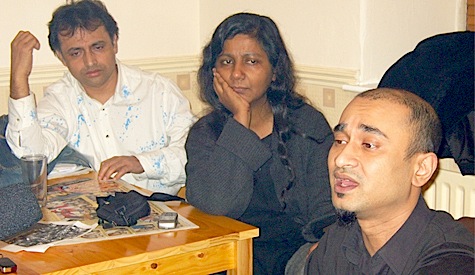
From Left: Moyez, Moushumi, Helal
M: What kind of music would you listen to when you were growing up?
H: Rap.
M: Is that what your generation listened to?
H: Yes:
M: How old are you, by the way?
H: I am 31.
M: Well, let’s have some more music.
H: All my songs are real high scale, বুঝছেন?
M: করেন না আপনি। যত জোরে করার করুন।
H: একদিন, দুইদিন, তিনদিন কইর্য্যা. . .
দোহাই লাগে বন্ধু তুমি আর জ্বালাইয়ো না। — সাজ্জাদ।
M [to Ahmed Ali, asks when he first came to England]: আপনি কবে এসেছেন এই দেশে?
A: In 1978.
M: What do you do here?
A: Now I do nothing. I am retired. Just do music. Have fun. এই দেশে যা দেয় বেশি কিছু না করলেও চলে, চলে যায়। আরো যারা আইছিল, তারা দেশে ঘরবাড়ি করলো কত। কিন্তু হাসন রাজা বলেন, ঘরবাড়ি দিয়া কী হইব? It’s like that.
M: How old are you?
A: 38. I used to do music with Helal’s dad. আমি তখন খুব ছুট ছিলাম। এরা আমারে মারতো। আমি শুনতে শুনতে শিখে গেলাম।
M: কার সঙ্গে প্রথম এসেছিলেন?
A: বাবার সঙ্গে। এখন বাবা নাই। মা আছে। আমাদের সবাই এইখানে। দেশে কেউ নাই। প্রথম দেশে গেছলাম ১৯ বছর পর। তখন কী মাতে বাঙ্গালি কথা বুঝতেই পারি নাই। পরে বুঝলাম। আখন দেশে একবার দুইবার যাই।
M [asks Helal how old he was when he first went to his desh]: হেলাল কবে প্রথম দেশে গেছেন?
H: When I was 17. Now I go once or twice every year. Not just to Sylhet, but all over. Must come to India, to Calcutta, now that we have met.
M [to Ahmed Ali]: Will you play with me?
A: Sure. আমার তো যেইখানে মন লাগে সেইখানে পইড়্যা থাকি। But I can’t play Rabindra, Nazrul, এইসব।
M: আমি রবীন্দ্র নজরুল গাই না। I try like you all. So we can jam together.
H: আমার মন মজাইয়া রে,
দিল মজাইয়া মুর্শিদ
নিজের দেশে যাও। . . .
M: এই গানটা কার?
There is some confusion. Then someone says: বোরহান উদ্দীন। পুরানো গান।
M: কোথা থেকে গান শিখেছেন বেশি?
H: রেকর্ড থেকে। ব্রিক লেনে পাওয়া যায়।
M: আপনার প্রিয় শিল্পী কারা?
H: ক্বারী আমির উদ্দীন, কামাল শাহ, কালা মিয়া, রুহি ঠাকুর, রণেশ ঠাকুর। নূতনদের মধ্যে সাজ্জাদ নূর—he is very good.
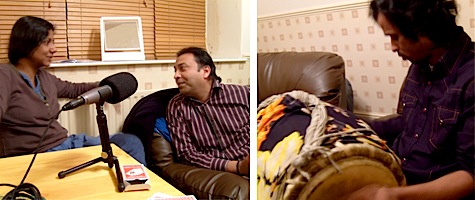
Left: Kaya. Right: Ahmed Ali playing dhol
M: অনুষ্ঠান হয় যে for the community, দেশ থেকে শিল্পীরা আসেন, এইগুলি কোথায় হয়?
H: Brady Centre, York Hall, Stratford. Summer-এ হবে। বৈশাখী মেলা, Brick Lane Fest, London Fest, Mayor’s Fest—এইগুলি সব হবে। These are big. I’m talking twenty, thirty, fifty, sixty thousand people. Indian মেলাও হয়, one in Gunnersbury Park, সেইখানে তো 100,000 people হয়। Now we are getting invited to these festivals.
M: Now you can make a living out of your music?
H: If I chose to, yes. Like Habib has done in Bangladesh. But I do a job.
M: Is Kaya’s background like yours? Is he also working? Is he about your age?
H: Yes. He has a restaurant. He is about Ahmed Ali’s age.
M: Your parents were also struggling with the language, weren’t they? For them they had only one language.
H: Struggling with their jobs, language, they had no time for leisure, for socializing with music. পরে সব settle করার পর, বেশি বয়সে they could do music again.
M: Yet you got your music from your father?
H: Yes, he also played the violin.
M: Does he still sing? Will he sing for us if we go?
M: No and I doubt he will sing now.
[Then we talked about Ruhi Thakur, how he used to sing with Helal’s father. That he was so seriously ill. Perhaps we made his last recording, we told them.]
Helal sings a composition of Dinoheen
ও মনা দুষ দিব আর কারে?
আজ মনার অন্তরে ধরলো গুনে।
Then he sings a song by Kajol Dewan, the same song which we have here.
H: আনুশেহ রা আসছিল, we did a concert together. Docklands-এ। যারা আগে কুন দিন লালন শুনে নাই শুনলো।
M: How is their music different from yours?
H: Audience overlap করে। Students, young people. তারপরেও different somehow. Different styles. That’s the good thing with folk. You can have so many styles.
M: I too work with folk. But I am not rooted like you, nor experimenting like them. Mine’s a private voice. Song of the drifter.
A: রেস্টুরেন্ট-এ কাজ করে, এমন লোক আছে, কাজের পরে, উপরে যাবে, saucepan-এর lid বাজাইলো হয়তো, গান করলো, খুব আনন্দ হয় তাতে। এমন অনেক আশিকান আছে।
–Written in Apr 2014.
Related Link:
Helal Miah with Parapar band members

